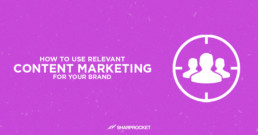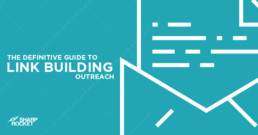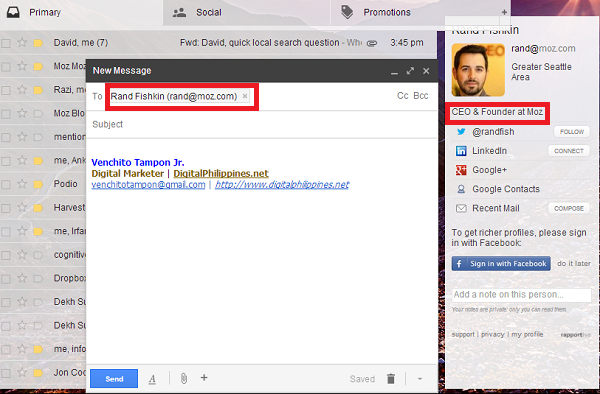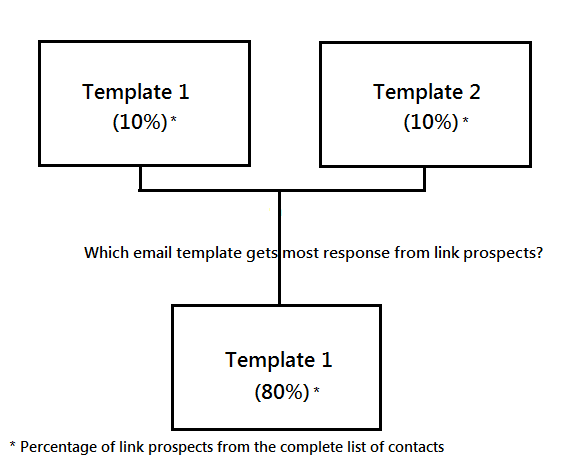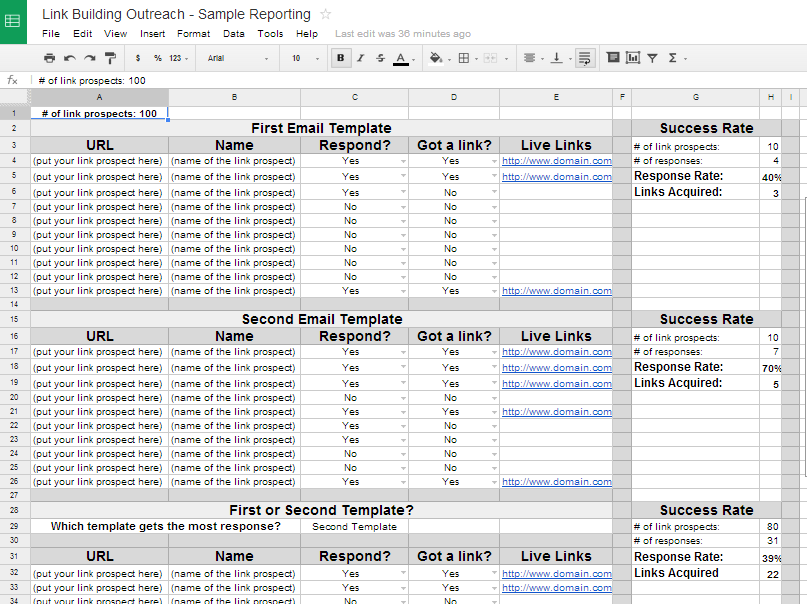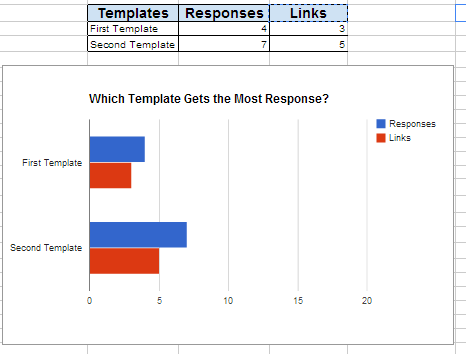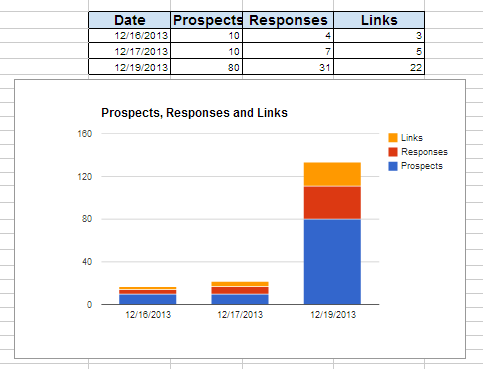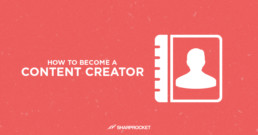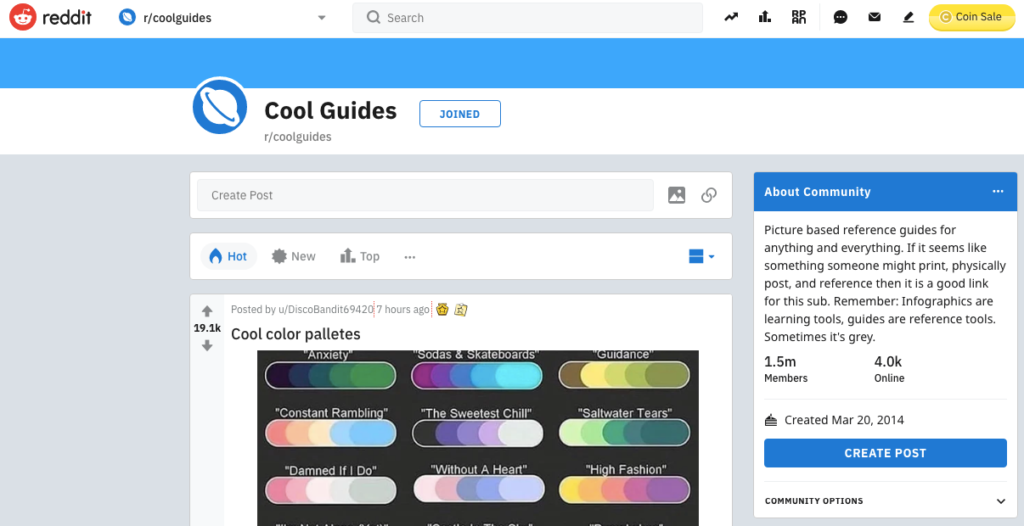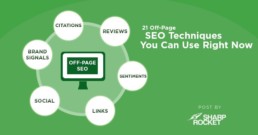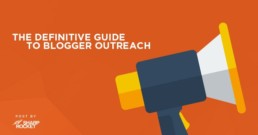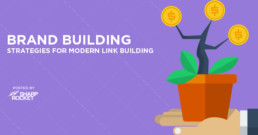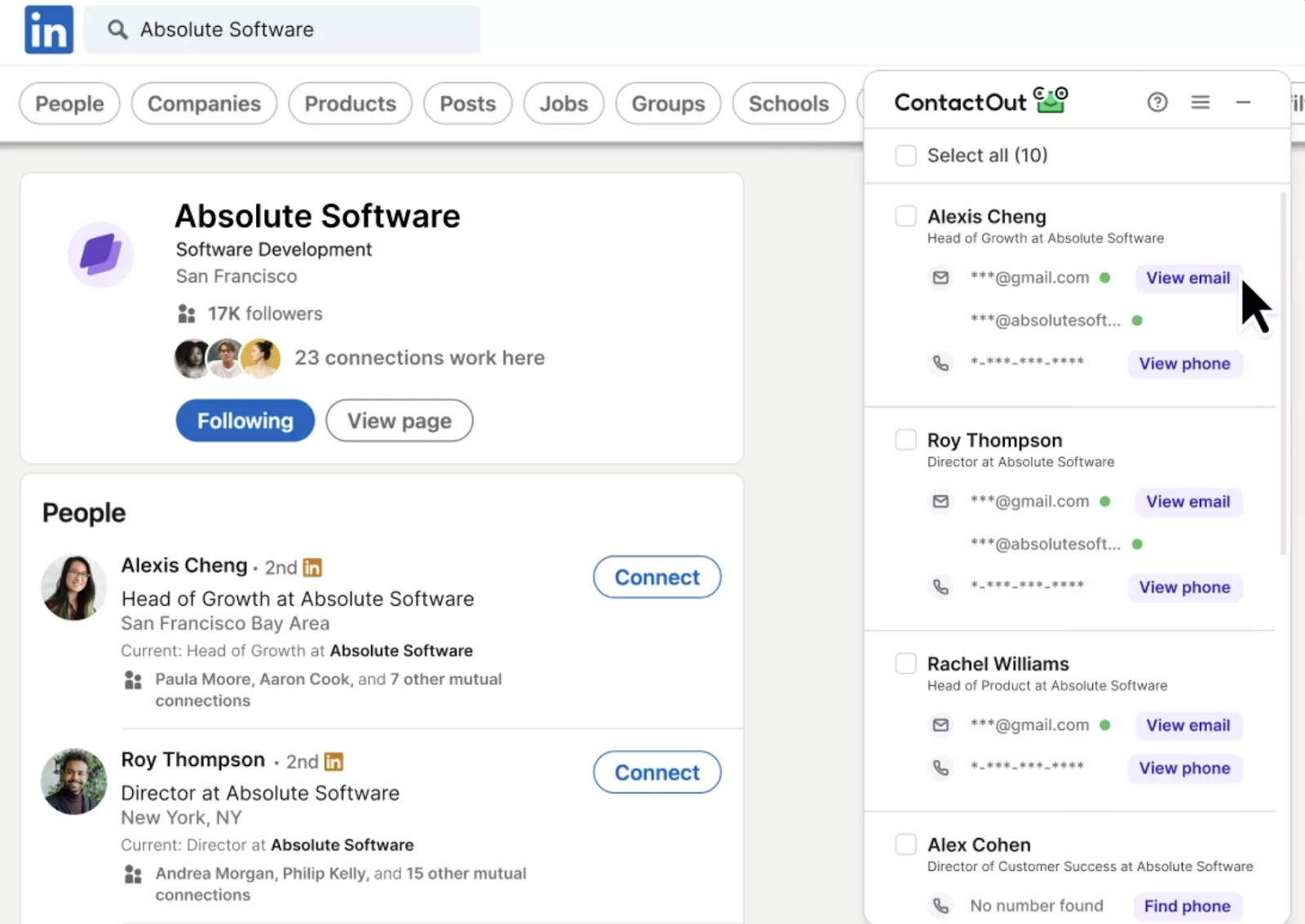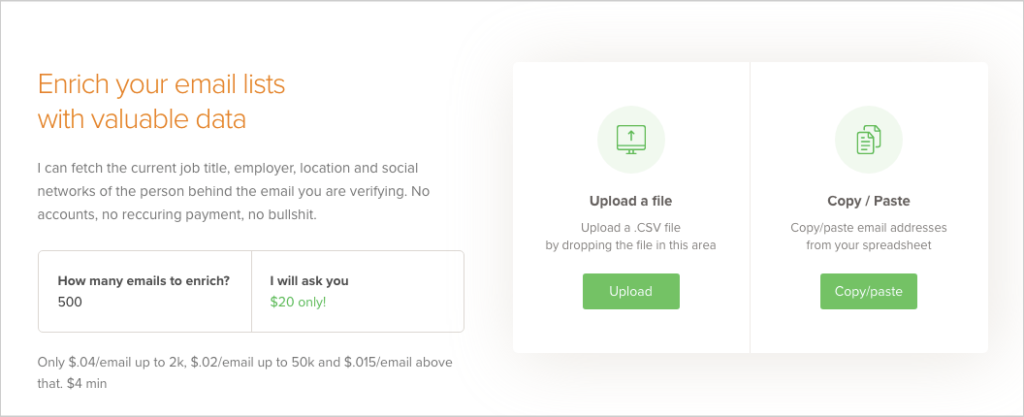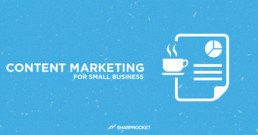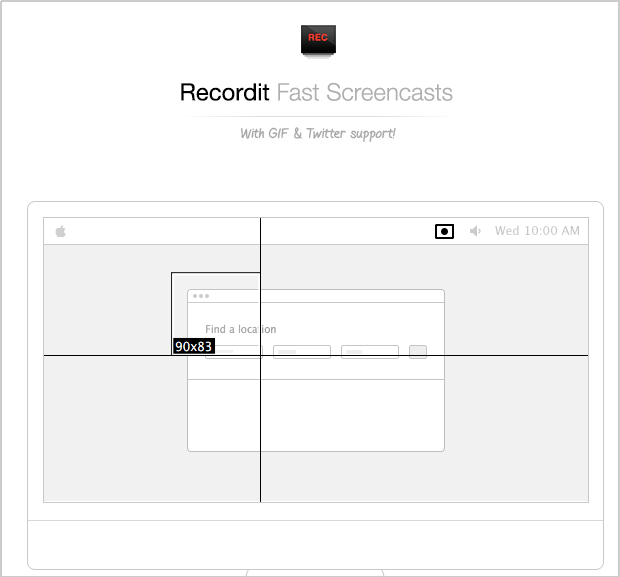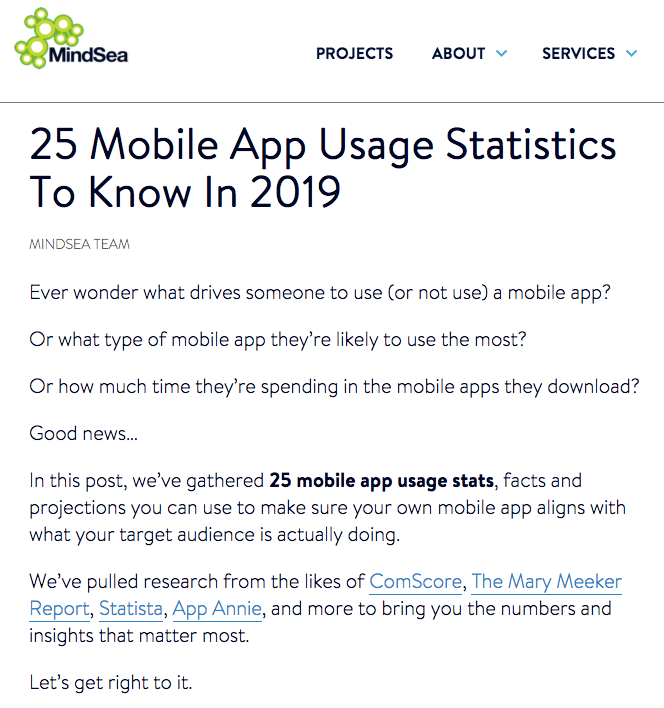How to Use Relevant Content Marketing For Your Brand
What is relevant content?
Relevant content is your offer to your audience. Something of value must be brought to the table before they begin to take an interest in what you want and need. Reciprocation matters today more than ever in content marketing.
The basic question to ask yourself when making an offer is, "who is my target audience?"
Generally, if you don't know your audience, it wouldn't be possible to know and meet their needs with your content. It is as simple as that.
Relevant content marketing is meeting the minds of two parties. Tied that to link building, it is a meeting between your value proposition and the needs of your linkers.
Building high-quality links require that your content is relevant to your target audience. Your audience — linkers are looking for a piece (reference, citation, content type, etc..) they can link to.
Relevant content isn't only pertaining to your newly published 'definitive guide' or your latest round-up from top experts in your industry. It is more than a produced piece.
There are many factors to make this "meeting of the minds" successful. That includes a proper understanding of some methodologies.
Basic Methodologies in Relevant Content Marketing
Have some frameworks in mind when planning your content marketing campaign. Doing so gives you an advantage as to what kind of output you can expect from your campaign.
Audience Targeting
In targeting your audience, one activity you need to know is persona development.
In traditional marketing, a persona is described as a semi-fictional representation of an ideal customer based on market research and/or real data about your existing customers.
You develop a persona not only in preparing your outreach initiative but also in creating relevant content for linkers.
To have a basic understanding of how personal development works, you can check out these two useful guides:
I discussed linkable audiences in many of my blog posts before. On this broken link building guide for example, I always say that by targeting a specific linkable audience for resource guides, you are placing your content on a good spot for links.
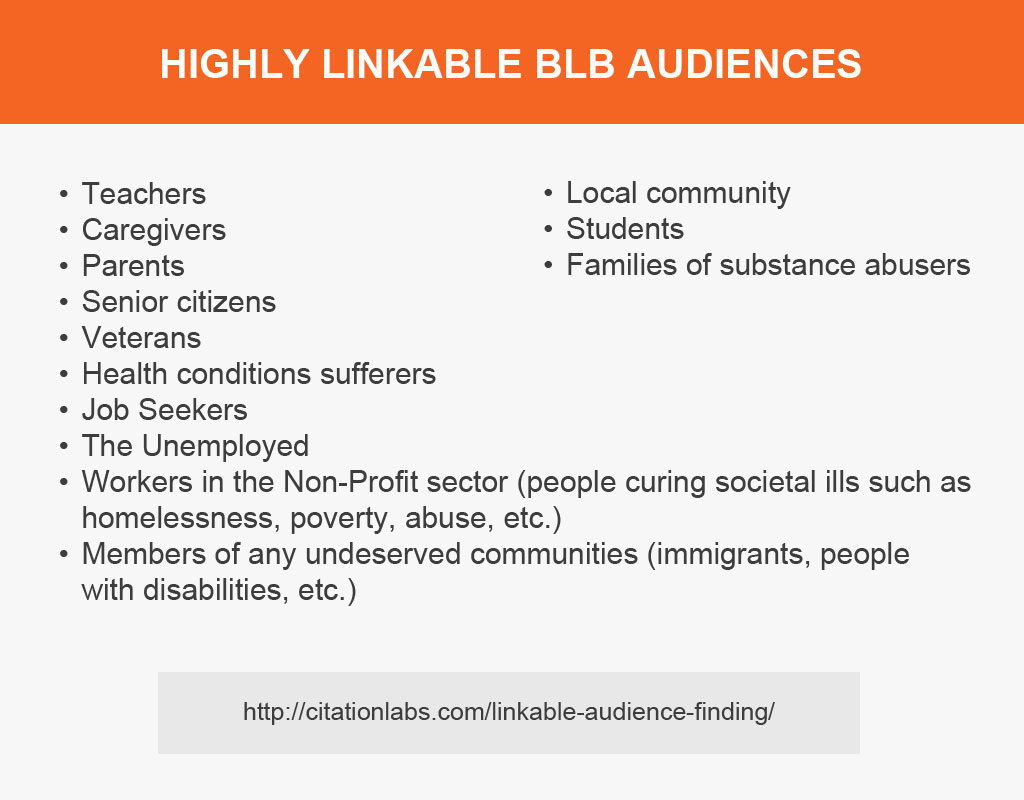
With the above linkable audiences, you can start creating a persona. This persona helps you craft better quality in content and therefore, increases the likelihood of improving its linkability factor.
Linkable audiences are connected to the linkability of your content. Content's linkability depends on its utility to targeted content consumers. More so, with the type and size of the audience, the content caters to.
A more niche smaller fraction of audience directly being targeted by your content speaks of better quality in results than content focused on a large volume of scattered audience.
Developing a persona gives you an advantage in pursuing links. You know what to prospect, what metrics to use to qualify your link opportunities, and how to better craft your email copy.
Authority Building
Content helps build authority in your space. If you're starting out, the best way to gain momentum is to produce web assets that showcase your expertise through information and stories.
There are two key mindsets in building authority through content marketing: be the first or be the best.
Be the first
In an industry where there is high competition because of the mass production of content, you can't just publish one and hope that you build a huge following.
By being the first in content, you find untapped opportunities others don't seek. Either find a new angle on those topic opportunities or look for new keywords to create content around it.
You can use Ahrefs to discover emerging keywords and sort ones related to your niche.
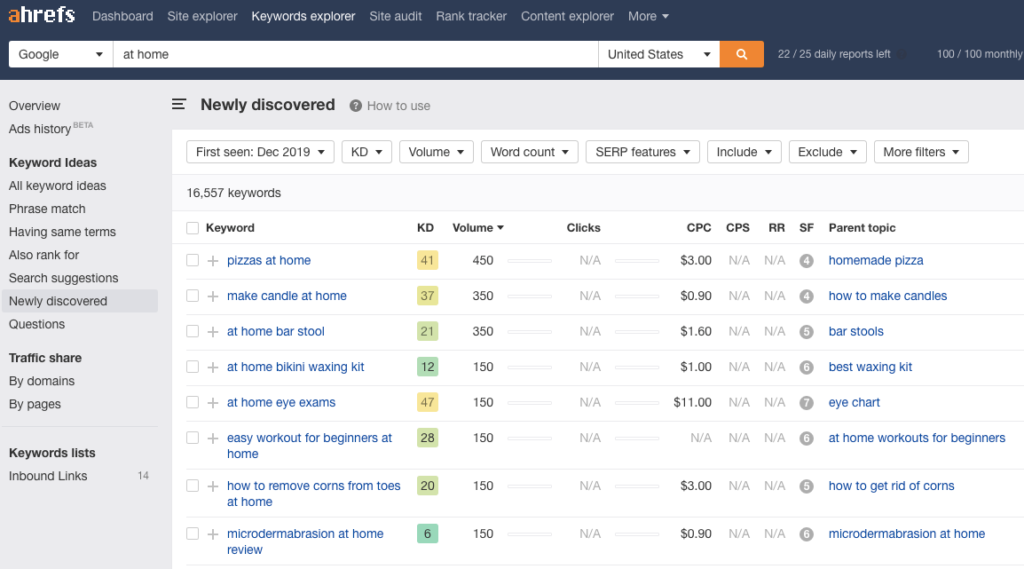
You may also look for frequently asked questions using the Question filter of Ahrefs' Keyword Explorer.
Be the best
Start producing a more comprehensive version than other similar content assets.
You can add other content formats to fulfill others' needs for learning. These formats might include, but not limited to video, audio, 3d versions, or images. The idea is to capture more audience by offering more ways and opportunities to consume your content.
Curate better by making insights from industry experts flow smoothly within the content. Put in first sections with information not expected by your readers ("unexpected hooks"). By adding this element to your content, you're likely to expect more engagement of your readers to your page.

Aside from collation, make sure you have something important to say in your content. A data-driven piece, thoughts experts take on your topic, and new methodologies and principles can help increase the credibility of your content.
And lastly to be the best in relevant content marketing — be authentic. Your readers know if you're true to your words. Particularly in industries where practitioners are heavily perceived as true sources of content, it's important to have well-planned research on the subject.
What makes content marketing more relevant isn't only targeting the right audience and starting to build your authority through content production, but also have all these things properly distributed to good places.
Appropriation of Channels of Distribution
Content creation is just half of the battle. You need to distribute what you published.
There are many means to promote your content assets. But a great way to start is always anchored to what you are currently capable of.
You can use your social profiles lo build strong networks with your followers and like-minded people in your industry. For example, you can learn how to use Twitter effectively to create Tweetstorms that can attract an audience and clicks to links of your content pieces.
For Reddit, you may engage deeply in subreddits where your target audiences are in play. You don't just spam subreddits with your links. You first understand the rules and appropriately promote your content whenever it fits. Here is a good guide to help you with Reddit marketing.
Another content promotion channel is HARO. Answer queries and provides stories to journalists, publishers, and other content creators for topics you have expertise in. See if the platform fits your resources and discover how to use HARO on a regular basis.
Look for channels that are potential recurring sources for traffic. Start getting your articles published in major publications — best to pursue sites relevant to your industry.
Lastly, let's talk about outreach. Here are some outreach methods you can start using to promote your relevant content:
- Influencer outreach - create more brand awareness by collaborating with influencers for a piece of content or distribution of your web assets.
- Targeted outreach for tool reviews - if your web-based tool is niche-specific to a certain audience, start getting blog links from content sites.
- Manual outreach - initiate an outreach campaign to build the first set of authority links needed to rank your piece of content. Once links start to help improving content's rankability, your content can lead to some attraction marketing assets of your brand.
What Brings Them Value
Generally, relevance is subjective. And it is only your readers, your consumers or whatever type of audience you are looking to serve will determine how useful your content is to them.
Always bring value to relevant content marketing. Start with a value-driven mindset when planning, when creating, and when promoting your content assets.
The Definitive Guide To Link Building Outreach
Outreach is one of the biggest parts of the job for link builders especially if they are just starting to build relationships with a few people in their respective industries.
As a matter of fact, in most link building campaigns, outreach consumes almost half of the time used for link building (probably because of the long inbox dialogue that happened before getting the link that they want).
I know you’ve read a lot of articles discussing how outreach should be done with care and personalization. You may have thought that the process is completely complicated in terms of the needed resources, link building tools, and time budgeted for this activity.
This boils down to one viewpoint: link builders are only for the persistent ones.
Well, there is nothing wrong with that. But in seeing outreach as a too-complicated activity in link building is not good thinking.
In this post, I want to share with you a simple guide on how you can effectively conduct your outreach campaign.
But before delving into the different steps used in this guide, let me give you some misconceptions about the outreach that I know many link builders are still thinking of right of this moment.
Misconceptions About Link Building Outreach
Lengthy emails are more likely to get higher response rates than shorter ones.
One factor that may cause an increase/decrease in the response rate is the length of the email.
Actually, there is no guarantee that a lengthy email yields a higher response rate than a shorter one. The number of words that must be used would mostly depend on the type of outreach you’re doing.
For product reviews, you might write a longer email since you need to explain the unique proposition of your product and use more words to entice your blogger to write a review about it.
While if you’re just sending an email to a person to let him see/share your content, you just need to be direct to the point and use 3 to 5 sentences to tell him your offer (since end-receivers in that kind of outreach don’t want to read fluffy words in their inbox).
The main point is that you shouldn’t care too much about the number of words that you will use in your emails. The more concise your email yet should be understandable, the better.
Outreach is all about personalization.
Personalization is only the first thing to consider in outreach. The next thing is authenticity. People are not always looking at the number of personal information that you know about them.
Don’t ask yourself, “how much information do I know about my prospect?”. But instead, answer this question, “How much do I care about my prospect?”.
People don’t care how much you know until they know how much you care. – J. Maxwell
Use reciprocation to your advantage. Offer your prospect something valuable that might interest him to do a favor for you (e.g. give you a link).
If you care about what he needs, he’ll be more likely to give you what you want.
Now you know some misconceptions about outreach, it’s time to understand the steps to a successful link building outreach.
How To Do Link Building Outreach
1. Goal Checking
You will not create again a list of goals for your link building campaign. You had this before, right? Now, you need to stick them into your mind while doing your outreach.
Remember that your link building goals should align with the operations of your business and should be more than just getting high quality backlinks. Check your list if the goals noted can bring success to your brand. Otherwise, make a revision with them.
Here are some goals that you’ve thought of when doing your link prospecting in the first place (and you know they can add value to your business):
Improve your online reputation management (ORM)
All brands want to impress their clients/customers as much as possible. Unfortunately, this doesn’t happen only by creating good and high-quality content targeted for its target audience. Your content must be seen by them in any way that you can (exert more effort on relationship building to get better results).
How can they see your content? Through outreach.
Unlike PPC ads and other paid marketing efforts, outreach is a free-to-use method to get your content in front of your audience and let them take an action for your brand (i.e. sign up for your newsletter).
Outreach tactics to improve your ORM:
- Content distribution to influential bloggers/webmasters (e.g. guest posts)
- Participation in industry-related communities (e.g. forum marketing)
- Pitch bloggers who do weekly/monthly interviews and ask if they can include your content assets.
- Find journalists and tell them your brand stories (use Followerwonk to search for them).
Increase in referral traffic
Link building is useless if it doesn’t add traffic to your site. It may seem good to see one link in your backlink profile but if it doesn’t give your site new visitors, then you are not squeezing the most value out of your link building efforts.
Outreach is your first initiative to increase your site’s referral traffic.
You let your prospects identify your requests (i.e. content placement) and why you are worthy for such. If they accept your requests, you can submit your content and get a link from that effort (contextual links from your guest post or from an introductory paragraph of your infographic).
And from the proper placement of your link, you can receive referral traffic from your prospect’s page/site.
Outreach tactics to increase your online traffic
- Ongoing content distribution to high-quality media outlets (e.g. regular content contribution)
- Engagement in industry-related conversations that are mostly found in community threads
- Massive interviews (pitching bloggers who have an interview section on their blogs and incentivizing them to conduct an interview with you)
- Build expertise-based relationships with key influencers in the industry (to get natural links that can bring new followers/visitors to your site).
Rank for competitive and highly convertible keywords
Having your content placed on the top five spots of search results for targeted keywords could bring continuous search traffic to your website. If targeted keywords have high conversion rates (i.e. buying keywords), an increase in leads/sales is possible as well (conversion link building).
Outreach tactics to rank for competitive and highly convertible keywords
- Increase in content promotion efforts with variations of targeted anchor texts for higher chances of ranking for related terms.
- Conversation participation in online communities (target keyword-based online communities – i.e. forums that have your target keywords in the threads’ titles).
- Pitching site owners that have links pages (placing your link in the page through broken link building and/or paid methods).
- Reaching out to social sharers of a successful existing content (asking them to also promote your content asset).
Enhance branding and market awareness
Online presence targeted to customers is the first reason why brands go online. When people search for a product/service to use, they want their offerings to be seen on different web places where their customers are actively participating (forums, blogs, Q&A sites, etc..).
Outreach makes this branding effort a lot easier since you only need to reach out to a few people who are influential in your niche which can speed up the process of your brand promotion (the higher is their engagement, the faster is the amplification).
Outreach tactics to enhance branding and market awareness
- Pitch bloggers who write high-quality product reviews (incentivize them by giving a free trial of the product, payment, or both).
- Get journalists to cover stories/news about the new developments of your brand.
- Sending emails to authoritative media outlets who’re seeking insights/knowledge from key influencers (include your personal or your brand’s achievements to secure a higher response rate).
- Continuous engagement in web places where the target audience participates.
2. Information Gathering
You need two things before you gather the needed information of your link prospects:
- List of identified link building goals in your notepad/word document with corresponding actionable tactics to achieve each goal.
- Spreadsheet of qualified link prospects (approved by your SEO manager/link building specialist).
When you now have these two lists, proceed to information gathering. Information gathering is simply the process of finding the important contact details of the must-pitch/approved link target.
Below are the details that you need to look for each link prospect:
- First name (with credentials such as Dr. to address the person ethically)
- Email address (methods to find this will be discussed later)
- Company position of the link prospect (optional)
If you come across a website that has only one website owner, it is easy for you to see his contact details by simply looking at the About Me page.
However, for several owners/persons of one website, you have several contact details to choose from. In this case, you need only to select one or two from the list and have his/her contact info placed on your spreadsheet. But how?
Go back to your link building tactics list and identify the person you need to contact for each link building tactic.
- Guest posts – blog/content manager
- Product reviews – content manager
- Interviews – specific staff member or the site owner (if not available, find the closest person of your interviewee and just ask him if he can direct you to your target person)
- Round-up posts – blog manager
- Get people to see your content – blog manager, social media manager
- Contest – page creator (when there’s a page for event inquiries)
- Event resources - event manager, support system person,
- Discounts/coupons – content manager
- Broken link building – page creator, original webmaster,
If you can’t find the right person to pitch for your link building activity, look for the last resort – support system manager. Commonly his email address would be info@domain.com or support@domain.com. Make sure you ask for permission/request to him to help you connect with your prospect.
Now that you have identified the right person to get in touch with, you can now find all the important details of that person.
First Name
There is no need to explain this further. But if you’re doing link building for commercial websites, you have to include the credentials of your link target (i.e. Dr. if he is a doctor).
I discovered that this is important since the person would want to address properly his name either by phone or via email.
Here are the places where you can find the email address of your link prospect:
- Contact Us Page. Look at the different sides of the homepage (top, bottom, sidebars) to find a link pointing to the contact us page.
- Contact Form. Find the email ad at the top of the contact form (somewhere in the description/paragraph above it).
- Employee Bio Page. For prominent brands, there might be a bio page for each of the brand’s staff members or employees. If you can’t find your prospect’s bio page, search for his personal blog/site (it may have been stated in the bio page, then find his email address on his own website).
- Google search. Use this query: site:domain.com @gmail.com OR [at] [dot] to see his email address in the search results.
- Linsy.me with Rapportive. Type in the name and/or the site of your link prospect in Linsy.me and place each and/or all of the email addresses in your email message (see the image below). Make sure you install Rapportive in your Gmail account to ensure that he is the right person you’re looking for.
I also recommend using Buzzstream or Citation Labs Contact Finder for easy identification of email addresses.
Company position of the link prospect
You can add this detail to your email to make your message more personalized, knowing that this can catch the interest of your link target (since you’ve done a little bit of research to get that small personal detail).
3. Segmentation
Before doing outreach, I categorize all my contacts based on the link-based metrics (i.e. DA) I’ve pulled out for each of my link prospects. This will help me prioritize my list of contacts as to which of them should I first reach out to.
The three categories that I used in this phase are:
High – Create the most customized outreach email. Offer an additional value to your pitch. For instance, you want the blogger to write a review about your product, you may want to add another offering (i.e. monetary value) to ensure a positive response.
Medium – Use a template that needs only revision in its intro paragraph. Include details on how you landed on the website of your link prospect.
Low - Use a standardized template to scale your outreach. The template must only require little to no revision.
Add a column to your spreadsheet for contact segmentation. Then proceed to create outreach templates for the two categories (medium, low).
4. Outreach Template
For your first category (High), you might not need an email template since you will write highly customized emails for each of your link targets.
However, for the other two categories, you want to have an outreach template to speed up the process (especially if you’re reaching out to 500 to thousands of contacts).
There are three outreach principles that I always keep in mind when I create an email template:
- Offering. What do you offer to your link target? Is it free content? Product or service? Sponsorship? This must be the first thing your link target must be able to see at the top of your message.
- Unique Proposition. How different is your offer from other offers? If you’re providing the same value then why would they bother to reply back to you?
- Call to Action. The end of your email template should get your prospect to take any action (give you feedback, answer your question, etc..). Be careful not to ask immediately for a link. It will just decrease your success/response rate.
The basic formula to create an outreach template is this (from SEER Interactive’s post):
[Asset] for [Blog/Website Name]
Hi [First Name],
[Brand] [thing brand is offering]. [CTA].
Thanks,
[Your Name
So if you’re outreaching someone for a guest post, your email template may look like this:
Subject: [New Content / Guest Post] for [Blog/Website Name]
Hi [First Name],
[Brand] would like to contribute an article about [topic]. Is this something you’d be interested in?
Thanks,
[Your Name]
Add variations to your email template to create multiple templates and test which one is the most effective. For instance, you want to test the best place to put your CTA offer.
In this case, you can create two templates: one template includes CTA in the intro paragraph; the other one has the CTA at its end.
The more you do testing, the more you improve your outreach.
Real Life Email Outreach Templates
Guest Post
Hey [First Name],
I saw that you’re the founder at [Site] and I wanted to get in touch.
I am looking to write about the topic "[topic]".
[Why do you want to write about that subject?]
I'm sure that this topic would catch the interest of your readers.
What do you think about this? If you’re interested, I am happy to get something written up and sent over to you – or if you have another topic you’d like to see covered, I am more than happy to write on that.
Here are some of my posts I've written on other blogs:
[URL 1]
[URL 2]
[URL 3]
Thanks,
[Your Name]
Results:
Response rate 79%: (11/14)
Links acquired: 11+ (with 2nd-tier links for this post)
Sample links:
- Guest post for Cognitive SEO (DA 50)
- Guest post for Raven Tools (DA 73)
- Guest post for Site Beginner (DA 41)
Round-Up Post
Hi [First Name],
I'm doing an expert round-up on my site and I know that many people would love to hear your thoughts to this question:
[Question]
You can include images (e.g. screenshots) and videos to support your idea.
I know that this will be a great resource for [industry] today. That's why I want to include your tip (since you've been sharing useful strategies/tactics about [topic] on [Site]).
Thank you for your answer in advance, [First Name].
Kindest regards,
[Your Name]
Results:
Response rate: 52% (51/99)
Links acquired (linking to this round-up post): 8+
Sample links:
- Search Engine Land (DA 92)
- Zen Optimise’s Weekly Optimizer (DA 35)
- Wow Internet’s Weekly Round-up (DA 42)
5. Execution
Now it’s time for you to do the outreach. Here are some tools that you can use for the execution phase:
- Gmail with Undo, Boomerang, and/or Yesware add-ons.
- Buzzstream (freemium)
- Marketo Sales Connect (freemium)
Among these tools, I personally use Gmail since I find it convenient and easy to use. However, Gmail and other email service providers can limit your outreach efforts such as handling multiple inbox dialogues and tracking responses from link targets.
If you are tight on your budget, you can consider Gmail and Excel spreadsheets as your outreach tools.
Here are a few tips to get the most value out of the said tools:
- Use canned responses in Gmail for easy template creation. You can even include your subject line in your email template so you can just copy and paste it in the subject line once you write the draft or send the message already (this is effective if you have long subject lines).
- Install the Undo tool in Gmail so you can easily undo the message if you still don’t want to send it (i.e. you remember some grammatical errors in the message).
- Use split testing in outreach. Create two different email templates (you add variations to their subject lines). Send an email message to the first 10% of your contacts. Send another one to the other 10%. Wait for 1-2 days for their responses. If they don’t respond, check each of your templates and see which details you can improve to get more replies. Select one from the two templates that get the most response and use it to reach out to the remaining 80% of your link prospects.
Here’s a diagram to help you with split testing:
Track the dates when the person replies back to you and when the link goes live. It will give you an idea of which week/month gets higher response rates (i.e. December is not a good season for outreach since most (all) are busy for the celebration).
- Allot one week of the interval before you follow up on your contacts. Check first their pages/sites if they had linked to you already. They might forget only to tell you your live links.
- Continue to build relationships with your prospects. You might get another link from them in the future (if you need be).
6. Reporting
If you can measure it, you can improve it. This saying is always applicable in outreach. After you send out messages to your target linkers, you have to track the response rate and the number of links you acquired from them for the following reasons:
- You can have a better understanding of which template gets the most response and certainly add/change details to the template to get better results.
- You can estimate your industry’s link acquisition rate for a certain portion of contacts (2% rate for the first 10% of the whole list).
- You can determine which day of the week yields the highest results in outreach.
There are still a lot more reasons why you need reporting in link building outreach. But the above reasons are what you need the most to improve your outreach efforts.
To simplify the reporting, I created a tool that will help link builders (including me) to measure the success that we’re doing in the outreach process.
Link Building Outreach - Reporting Spreadsheet
As you can see, I applied split testing in the execution and reporting phases of the outreach.
You can easily track the success rates for the first split (10%), second split (10%), and last split (80%) of the activity. You just need to put the important details in the spreadsheet:
- URL of your link target (page/site)
- Name of your link target
- Yes/No for the response section
- Yes/No if you get a link from the prospect
- URL of links that you acquired
The tool will automatically count the response rate and a number of links that are lived for each outreach split.
The spreadsheet could also give you visual representations of the number of links and percentage of responses for a part of the whole portion of your list of contacts.
I will update this tool in the future to track and analyze more needed details in outreach.
How to Become a Content Creator
What is a content creator?
A content creator produces material for a target audience that serves both a user purpose — entertainment or educational, and a content marketing purpose — generating brand awareness, product/service purchase or brand loyalty. The content he or she produces takes many forms including blog posts, videos, visuals, and audio.
Content marketing has grown its importance over the past couple of years in the entire digital marketing field.
Its proven efficiency in improving thought leadership for brands as well as demonstrating expertise for online personalities has been more of a need than a want today.
There are increased demands for content creators to deliver various types of content for online audiences — bringing more jobs to more people. The above quality of work like in any industry lures more pay and career opportunities.
This leads us to the question, "how to become a successful content creator?".
A little disclaimer here: the tips that I'll be sharing below are driven from my experience and from the experiences of content creators I've been following online and have mentored me in this area of content marketing — content creation.
Before we answer the question "how to become a successful content creator?", let us first define what a content creator is.
How to Become a Successful Content Creator?
There is no one surefire formula for achieving success as a content creator. You can't box content creation with limited ideas. However, there are certain principles and habits you can employ and adapt to your context in order to achieve the results you want for your content.
Let's start.
1. Get updated about the industry
Whether you are creating content for your own blog or for a brand you're employed with, reading the latest industry updates gives you an advantage.
By knowing what is currently happening in your industry, you can take things right into perspective, which helps in putting more insights into your content piece.
With stored knowledge, you can provide a different angle about the topic you're publishing — a twist that kills boredom for your readers.
Getting updated with industry news allows you to see new brands and new personalities you can also collaborate with for future content creation initiatives.
One way to put this into a habit is to use a tool to save articles for later reading or use. Rather than trying to squeeze time for reading when you're focused on a big task, why not use a tool to save articles you just stumbled upon. This saves you a couple of wasted unfocused hours.
You can use Pocket to save articles and pages you want later for viewing.
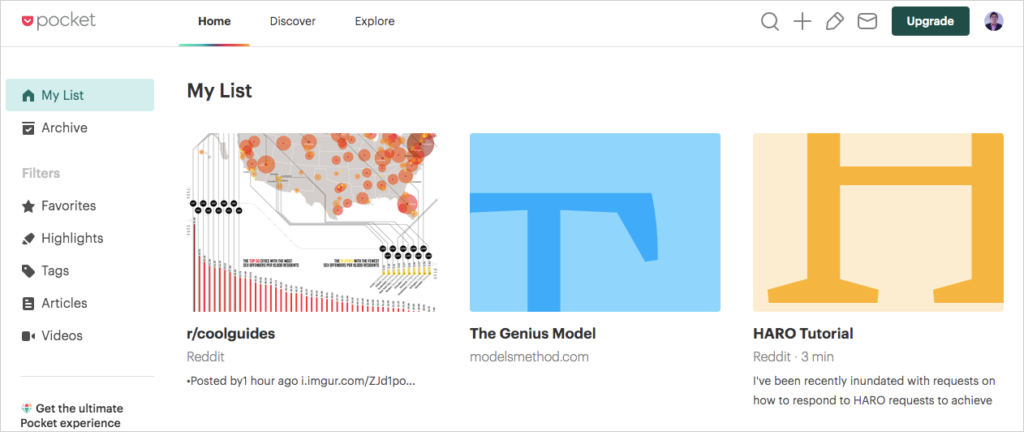
When finding activities to become productive, you can check your Pocket over the phone. Without too much time consuming, you get things done as a content creator.
2. Produce content regularly
Whether your piece is a video, audio (e.g. podcast), or text-based (article), be consistent in your production.
The way to achieve better quality in your output is to produce more content.
By consistent content production, you see points of improvement as you assess each one of them after the production (even during its distribution or promotion phases). You see how to make it better through the feedback of your consumers — readers or followers.
Quality control is essential in content creation and can be done more effectively if there is a good number of content pieces produced daily. Always strive for more content assets without sacrificing quality.
As a content creator, there are times when you feel like you can't publish any more pieces. That's when you need the inspiration to push you through.
Here are some materials that can inspire you to produce content pieces regularly:
Sidenote: During the Coronavirus, here are some good reads to help you with your content strategy: SiegeMedia's content strategy during coronavirus, and Moz' content ideas guide for every niche (what readers want during Covid-19).
Further Resources:
- Content Marketing Ideas & Strategies For Small Business
- Creating and Developing Content Assets Like A Pro
- 5 Linkable Assets Examples
- LinkBaiting: Creating Content That Attracts Links
3. Curate content
Content anxiety is common to content creators. It happens due to the pressure of putting out too much content to fulfill the editorial calendars of blogs. To overcome this type of anxiety means that you follow your content schedules without sacrificing the quality of output.
One way to fight against content anxiety is through content curation.
Content curation is the process of organizing and presenting outside content in a new, meaningful way.
Essentially, you are banking on other people's published content. Organize them to provide easy references and easy consumption to your readers.
You can start content curation by following brands and thought leaders in your industry with solid content assets.
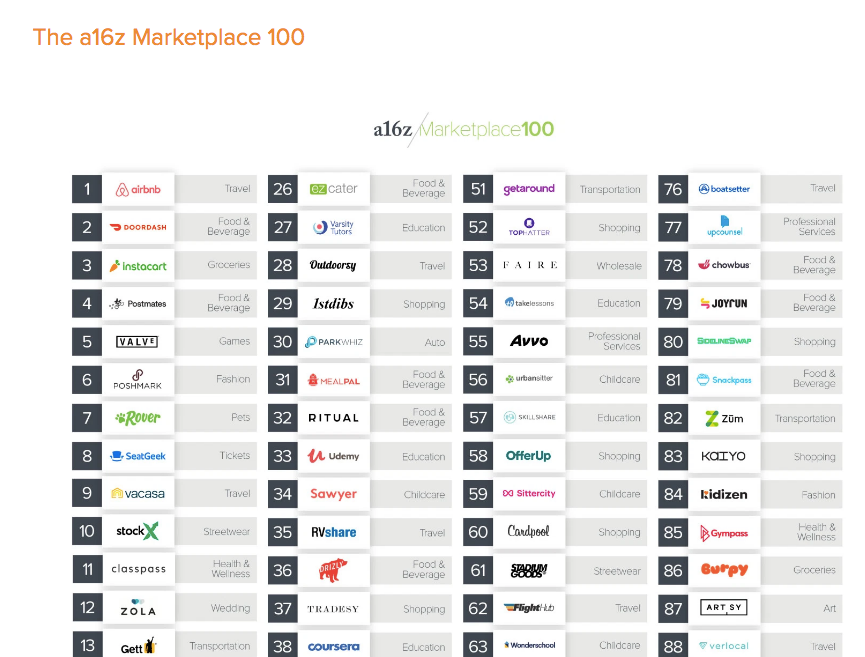
You'll be able to find patterns of topics they produce that may be of relevance to current happenings in your niche. Curate them in a way that follows a content idea.

By excelling in content curation, you don't have to cram with both quantity and quality of content.
4. Consider other content formats.
A content creator isn't only fixated on writers. Content creators can be podcasters, videographers, and graphic artists too. They produce different types of content but aim for the same purpose for the brand or site they're involved in.
The key to gaining more awareness of your brand is to tap other content formats that best suit your audience. If you're a writer, try and invest in producing audio content like podcasts. For example, have your written tutorials be recorded on videos to provide additional learning material to your text-based piece.
Understand the learning styles of your audience. Go to places where they normally engage in. You can use Reddit to see what content format resonates more with your community.
5. Invest in building your reputation and relationships
Regardless of whether you're working as an in-house or agency marketer or a freelance content producer, it is essential to build your reputation online.
The easiest way to build your authority is to participate in online community discussions, where you think you can provide people with your expertise.
Answer niche-relevant questions on the forum and on community sites like Quora. You can use Ahrefs to discover specific questions that are constantly receiving visits from people. Simply reverse engineer by plugging in Quora website and go to organic keywords
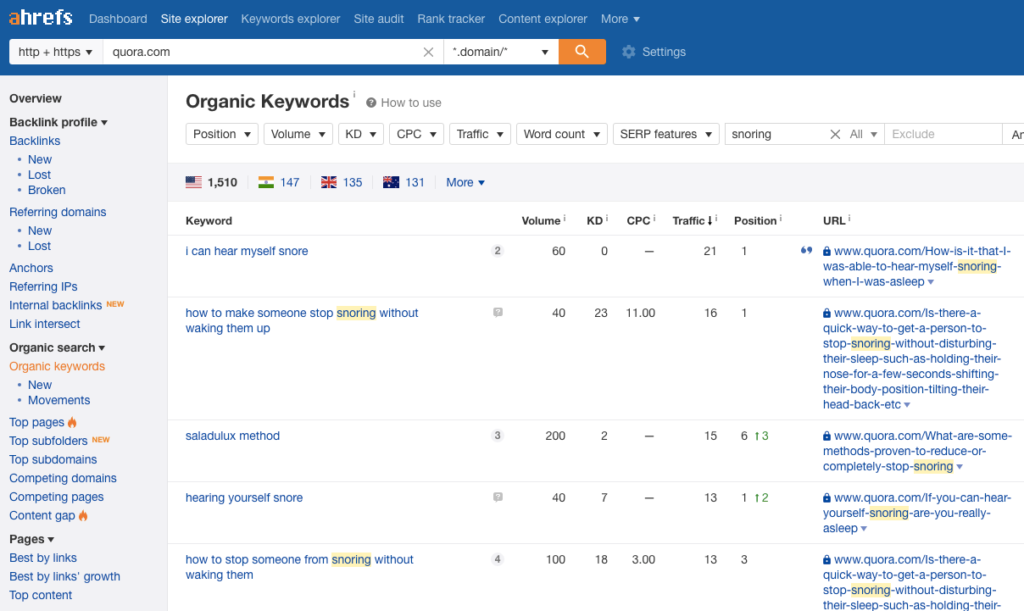
Start connecting with other content creators and thought leaders in your space. Build authentic relationships. You may never which one of them can help you further advance your career in the future.
Seek Continuous Improvement
Definitely, there are other more principles, ideas, and methodologies to become a successful content creator in today's time.
However, one that is foundational is to seek continuous improvement. It's a never-ending process to know what works in content creation and how to effectively distribute those assets to other places.
Off-Page SEO: The Definitive Guide
What is off-page SEO?
Off-page SEO refers to link building and all related activities & actions focused on growing our Website popularity, happening outside of it, and therefore the name.

Aleyda Solis, Founder of Orainti
Off-page SEO to me is any kind of optimisation that takes place away from the site itself. Generation of signals from third party websites to tell Google that the thing you are optimising deserves to rank. The main part of this is obviously link building but increasingly can incorporate other things like social.

James Agate, Founder of Skyrocket Digital
Off-page SEO means doing anything from an external point of view to assist with SEO efforts. This could mean link acquisition, building mentions, using a digital PR agency, building your brand off site to have a positive impact on your websites SEO.

James Norquay, Founder of Prosperity Media
Using these principles as solid foundation, let me walk you through the 21 off-page SEO techniques you can immediately use right now for your website.
[mc4wp_form id="6921"]
21 Off-Page SEO Best Practices
1. EXPAND LINK LISTS WITH A SIMILAR CONTENT PROSPECTING TOOL
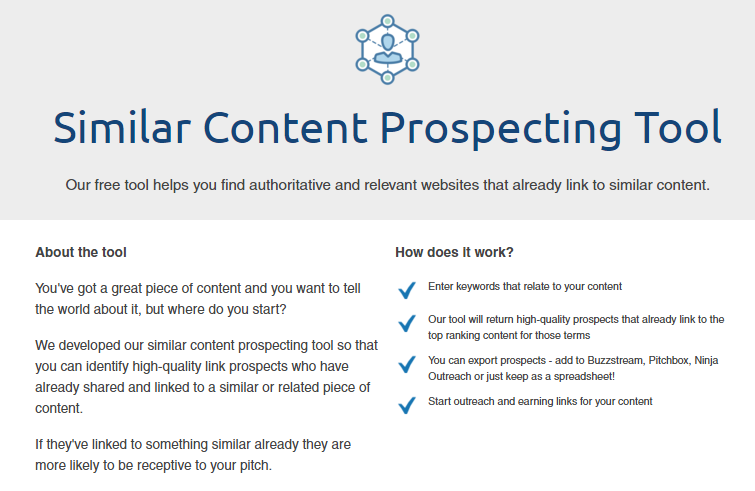
Websites that are linked to content or resource similar to an asset page published on your site are more receptive to outreach than any other link prospects primarily because of their linking history.
When they had linked to a particular page, they are likely to be interested in its similar resource and consider it for a possible linking opportunity.
Topical relevancy and higher link acquisition rates are a few notable advantages when you reached out to said link prospects.
Given this, here is how you can find these high-quality backlink sources:
STEP 1: Enter niche-specific keywords (related to your content) in Skyrocket’s Similar Content. This link building tool will automatically generate high-quality prospects that are linking to the top-ranking pages for searched keywords.

STEP 2: Export domains and list them in a Spreadsheet or you can plug them into your favorite outreach tool.
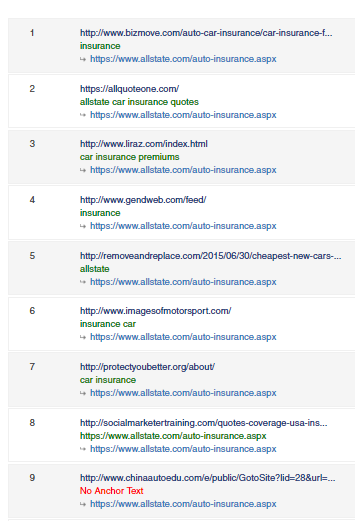
STEP 3: Reach out to webmasters and publishers of those potential linking sites and ask if they’ll be interested to look at your content piece. Here is one example of an email template that you can use, which is actually for follow-up purposes.
Hello [ NAME ],
I contacted you a few weeks ago to share a resource that I thought you may
find of interest, and you informed me about your upcoming blog/site
update. I was wondering if you’ve been successful in the update and had a
chance to review my message; a copy of which is provided below for
reference.We’ve launched a really detailed guide to [ TOPIC ] and I
thought you might be interested in seeing it - [ URL ]If you are still updating this page -
[ URL ] then perhaps our guide might
make a useful addition.Please let me know if you have any questions. And if this isn’t for you or
you’d rather I didn’t get in touch in future please let me know and I’ll
be sure not to send you any other messages.- [Your Name]
2. LEVERAGE CONTENT TEMPLATES WITH BUZZSUMO
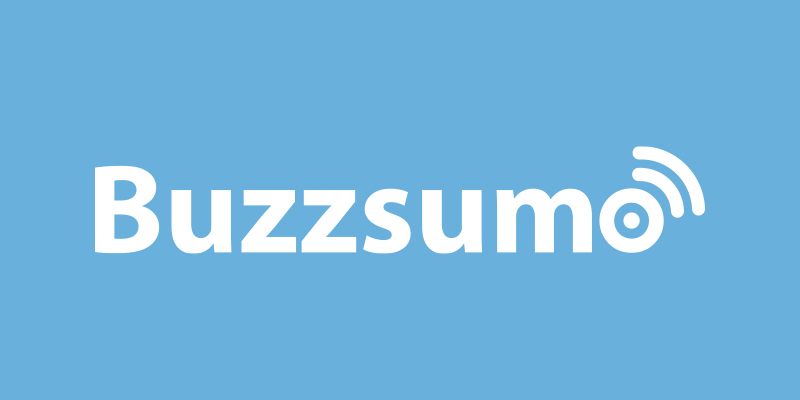
The ability to scale content assets without sacrificing qualify differentiates average content marketers from excellent ones. A year ago, Ross Hudgens shared one strategy on how to create incredible content assets at a low cost. It is with the use of content templates.
Content templates are simple formats of successful content assets from other verticals or other brands that can potentially be replicated to your own content marketing campaigns.
Two good examples of these content templates are these posts by Hubspot about habits for hyper-productive people and habits for content marketers.
Hubspot’s content marketing team found this “habit-type” content template to be a good blog post framework. People simply want to emulate habits that make other people successful in whatever field they belong to.
Thus when you publish content like this, it easily gets traction from many people – acquiring multiple social shares and earning referential links from publishers.
How to find content templates that are likely to earn links naturally?
STEP 1: Find popular content-producing sites in your industry and use Buzzsumo to look for their most-shared content pieces.

STEP 2: Take note of all possible content formats and list them down in a Spreadsheet.
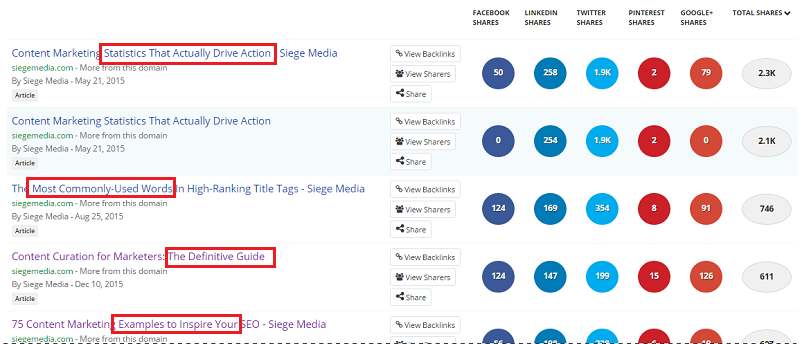
STEP 3: Create content pillars based on your preferred content formats. This would require testing but when you see results from first published content, you can replicate this to every sub-niches in your vertical (check out my definitive guide on blogger outreach).
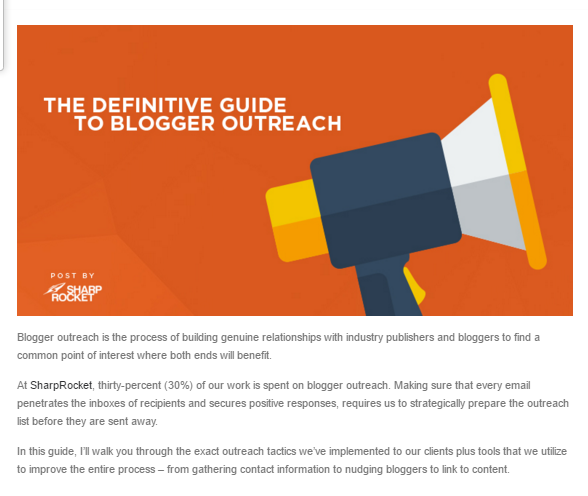
3. LINK TO INFLUENCERS WITHIN CONTENT
Though Google doesn’t count outbound links as a direct ranking factor, knowing how to properly link to relevant sources externally is still a best practice in the search industry. External linking to credible resources and useful content produced by influencers helps an initial boost of promotion to your content piece.
Maximizing this strategy is a sure way to put more eyeballs on your asset.
How to execute this properly?
STEP 1: Search for influencers in your niche whom you can easily connect with. You can use Buzzstream or a simple Google search to discover this kind of people.
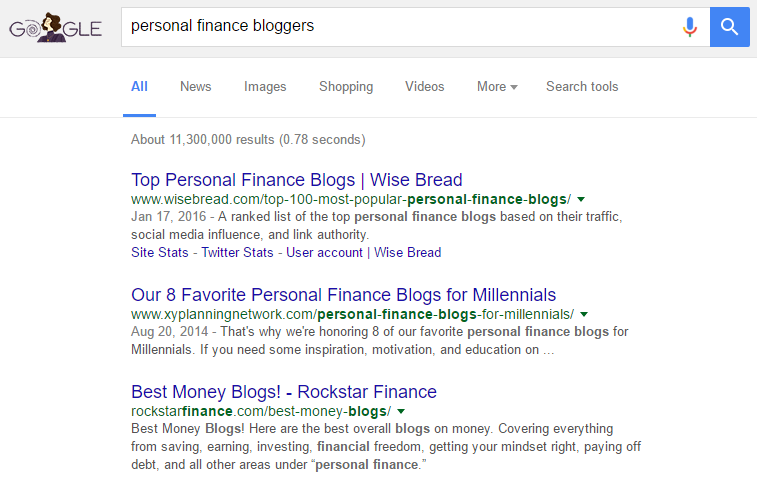
STEP 2: When starting to create content, try to find relevant blog posts of influencers. You can use the search phrase, site:domain.com “keyword” or site:domain.com intitle:”keyword”. The latter search strings are more useful because it provides the most targeted results - finding pages that discuss the whole topic, not just including your keyword in one paragraph.
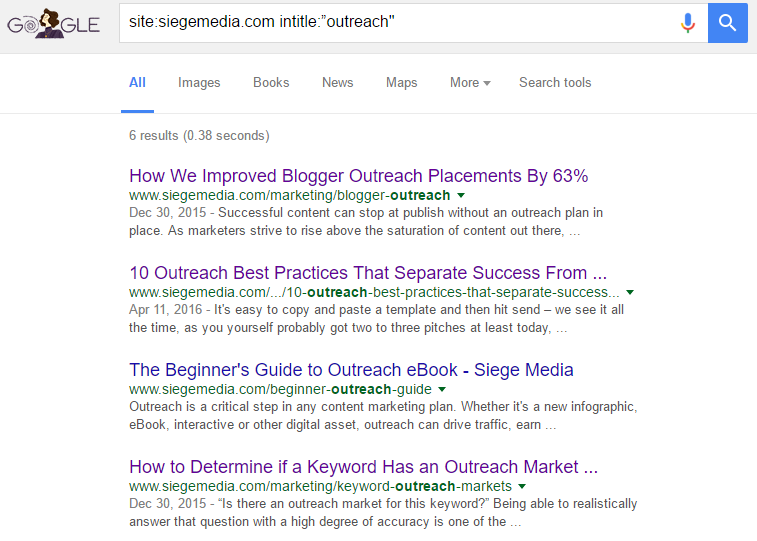
STEP 3: Once you publish your content, reach out to these influencers using direct email outreach. Results from this are either social shares or contextual links from publishers. Even if you got one social share from an influencer, this can be worth a hundred of traffic to your site.
Hi [ NAME ],
I saw your website and found that you linked to one blog post about [ TOPIC ].
Just thought that you might find my definitive guide on [ TOPIC ] also useful. It is a rich content that contains an [ DESCRIBE YOUR CONTENT ].
[ URL ]Kind regards,
[ YOUR NAME ]
4. BUILD HIGHLY-CONVERTING MICROSITES
If you’re aiming to capture small segments of your target market, one way you need to invest in is creating microsites. This method can enable your brand to build high-quality links your competitors can’t easily copy, as well as give your site more opportunities to attract potential clients/customers.
One good example of this branding strategy is how Aleyda created two microsites that provide a lot of value to the SEO community – All SEO Guidelines and The Marketer Toolbox.
Both of these sites target segmented audiences, the first one helps SEO practitioners (both in-house and agency-level) while the second one focuses more on marketers and tool creators.
Now, how can you identify your specific market segment and create a microsite out of it? Below are a few steps to get you started, but if you want to take the whole process, you can check out these posts and this guide by.
STEP 1: Go to your Google Analytics data. Look at the top-performing posts with high conversion rates.

STEP 2: Determine what market segments you can tap that aren’t going too far from your main content theme. For example, in my case, I can create microsites for link building tools and templates/checklists for link acquisition given that I’m currently offering link building services.
STEP 3: Once you choose an overall theme for your micro-site, buy your own domain name and hosting. In terms of the site’s content development, you can produce scalable content pillars like round-ups on an actionable topic, interview series, and user-generated content.
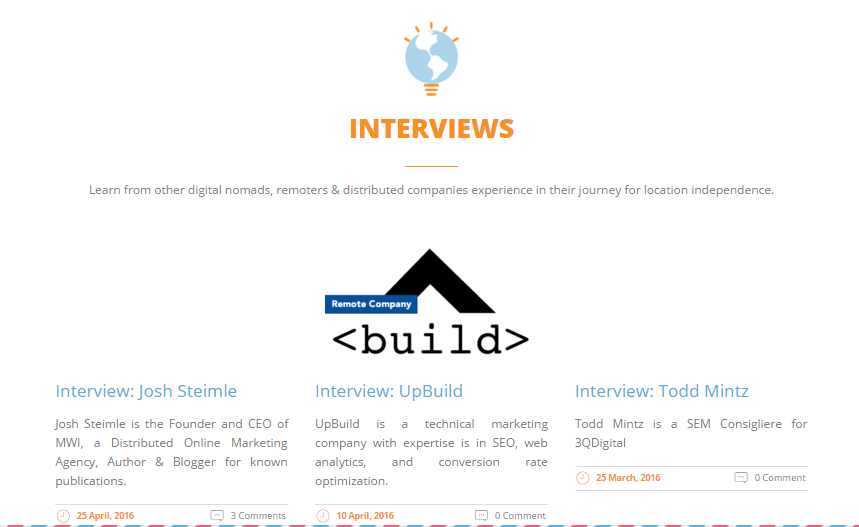
5. USE INTERVIEWS AS GUEST ENTRIES
Guest blogging has been an effective off-page SEO technique for many startup marketers building their own brands from scratch. What makes this more effective is the ability to craft solid content that isn’t a carbon copy of another piece or a revision of a blog post published on one popular blog.
The challenge in guest blogging is really writing expertly-written content that won’t just acquire a single link but will potentially get second-tier links from blogs linking to the contributed piece.
One way to be able to do this is by using interviews as guest entries for other websites. Given that answers from industry experts are most likely to be actionable, helpful, and experience-based, they can be considered as solid content for guest blogging. Here is how you can execute this process:
STEP 1: Find publishers and book authors using Google search or influencer prospecting tools.
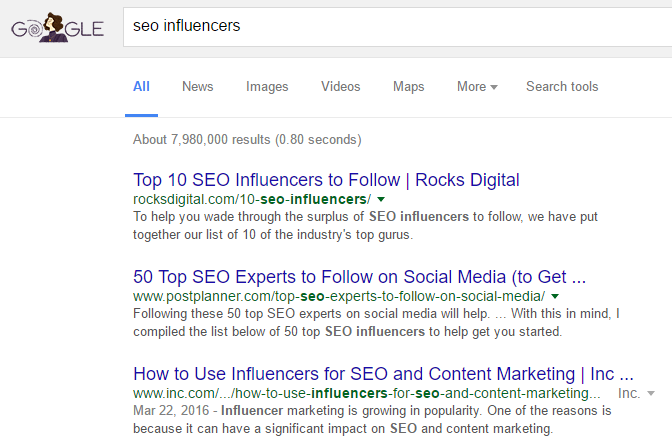
STEP 2: Reach out to these niche experts and do an interview with them. Below is an email copy you can use:
Hey [ NAME ],
I hope you're doing well.
Just want to tell you that, [ WEBMASTER NAME ] who manages the [ SITE NAME ], gave me an opportunity to guest post at [ URL ] and am planning to do a short written interview with some of the below bloggers and I was requesting if you can be one of them.
- INTERVIEWEE’S NAME 1
- INTERVIEWEE’S NAME 2
- INTERVIEWEE’S NAME 3
- INTERVIEWEE’S NAME 4
If so, I’ve attached a short written interview that you can use to share your tips or ideas.
If you’re interested in including screenshots as part of real life example, you’re welcome to do so.
The topic of discussion is [ TOPIC ]
Cheers
[ YOUR NAME ]
STEP 3: Use their answers as guest content for your target blog. Check out these examples of interview-based guest posts.
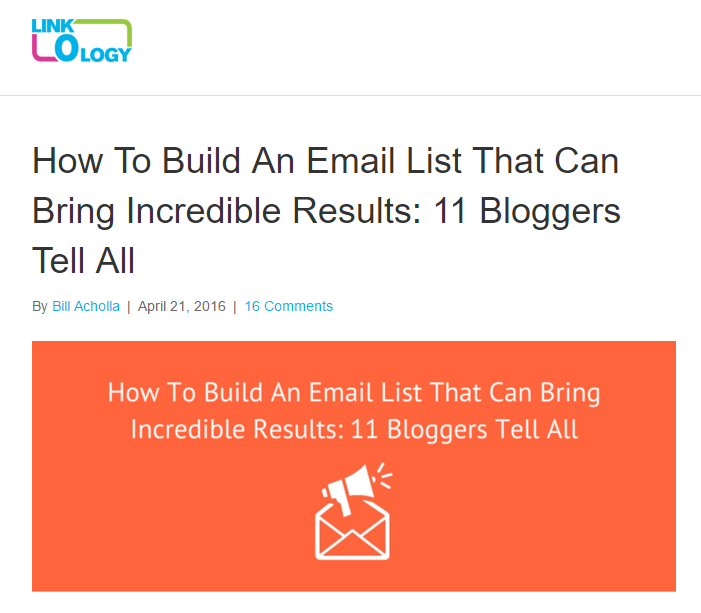
6. COLLECT LINK PROSPECTS FROM LISTPEDIA
Using social media platforms like Twitter for link prospecting is a strategic approach for link builders to find new bloggers and publishers that aren’t yet found through Google search. With this, you can expand your list of outreach targets without actually depending on search engines as your primary source of target domains.
Besides getting additional backlink sources, you’ll also be able to tap influencers that have a strong massive reach both in web publishing and social if you try using social media as your main link prospecting tool.
In other words, you get more benefits when you do outreach to them since they won’t only be linking to your content, but they’ll also share your content with their existing followers. This can allow your brand to acquiring more backlinks from their followers’ blogs as well.
You can start this by using simple Twitter searches to find bloggers in your industry. However, if you are doing bulk prospecting, you can scale the process by using Listpedia.
Listpedia is a new self-made search and creation Twitter tool that can generate massive Twitter lists relevant to a particular keyword.
Here are three steps on how to use Listpedia for link prospecting:
STEP 1: Go to Listpedia and search for a particular audience you are aiming to reach out to (e.g. personal finance, finance, or insurance).

STEP 2: Check each individual Twitter profile in the search results to see if they have their own blogs or websites.
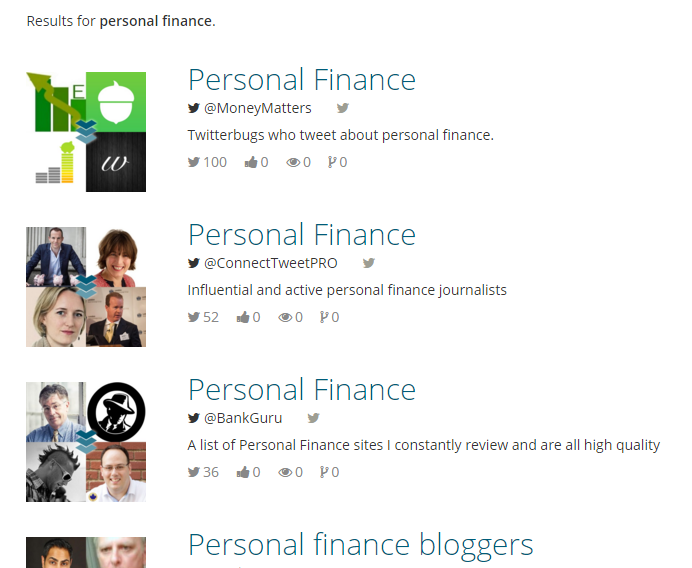
STEP 3: Once you think a particular website passes your link metrics (Ahrefs rank, DA, or Trustflow), you can include it to your outreach list, find his email address and send a pitch via email. Below is an email copy you can use:
Hey [ NAME ],
I saw your profile on Twitter while doing my research, and also saw that you are part of this Twitter list [ URL ].
Just thought that you might find my post about [ DESCRIBE YOUR CONTENT ] really useful. [ YOUR CONTENT URL ]
Have a great weekend!
All the best,
[ YOUR NAME ]
7. INCLUDE POST-PREVIEW AS ADDITIONAL PROPOSITION TO CONTENT
Creating remarkable content may require experiences and case studies from your own brand that gets people into action - after they consume the content. Case studies that take days, weeks, or even months are really time-consuming for content creators.
However, there is one way to easily add a data-based experience that won’t cost you money. That is, including data from an influencer/expert you’ve had a relationship with. Since there is a connection involved, the influencer won’t look at it like stealing his ideas as you initiate asking for permission to use his data.
I did this strategy when I wrote my old post on increasing blog traffic where I included an experience-based tip from Roel Manarang – a local-based social media marketing expert. He backed up his claim with a case study of a Facebook strategy, not even shared on his blog, at the time I inserted his technique into my blog post.
Here is how you can use post-preview in your content creation phase:
STEP 1: Identify influencers you had relationships with (grab your list from off-page SEO technique 3). Filter the influencer list by expertise these influencers have been known for (i.e. link building, off-page SEO, conversion rate optimization, etc..) and choose those you think can collaborate with you once you create your next content.

STEP 2: Reach out to influencers and ask if they’ll be interested to add some insights to your upcoming post. You can try this email outreach copy below:
Hello [ NAME ],
I know you're quite busy today. But just a quick heads-up if you're interested to contribute insights to my upcoming post about [ TOPIC ].
I would like to know if you have any experiences and tips regarding [TELL MORE ABOUT YOUR UPCOMING POST].
Let me know your thoughts.
All the best,
[ YOUR NAME ]
STEP 3: Include the influencer’s tip to your content and start to promote it to people who might like your link to your post.
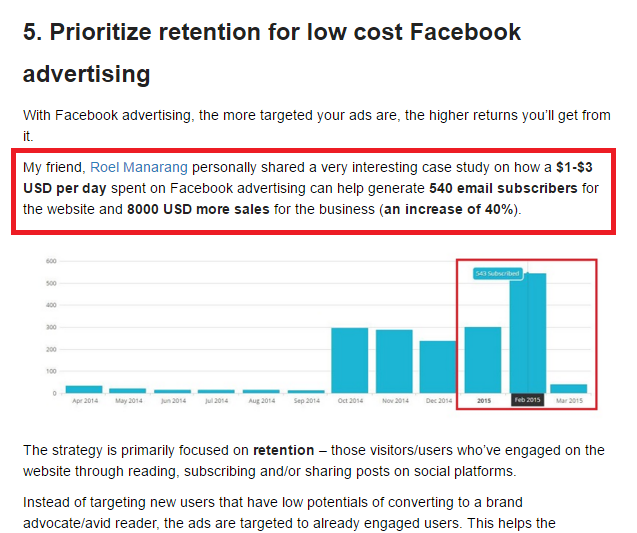
8. IMPROVE RELEVANCE WITH BRAND KEYWORD INTEGRATION
Google understands the relevance of a brand towards its connected domains in the industry sphere based on the keywords and context of each content produced in the website. Knowing this, you will create additional content based not only on the industry terms you want to rank for but on keywords you could potentially rank.
This is doable in three steps.
STEP 1: Go to Google Keyword Planner and plug in your homepage in the landing page search. You will then see a list of keywords Google considers to be relevant industry terms of your brand
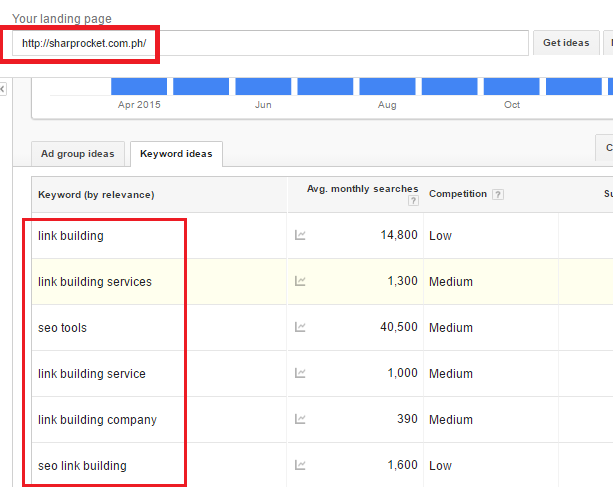
STEP 2: Choose among the list of keywords which of them you will likely target for your next content.
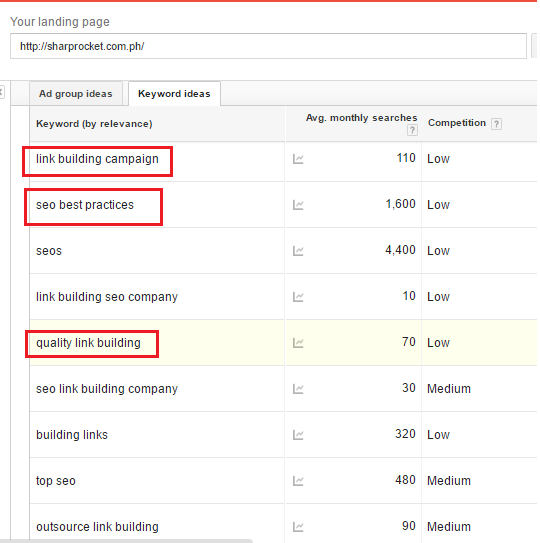
STEP 3: Include industry terms when writing your content in order to improve the LSI relevance of your website.
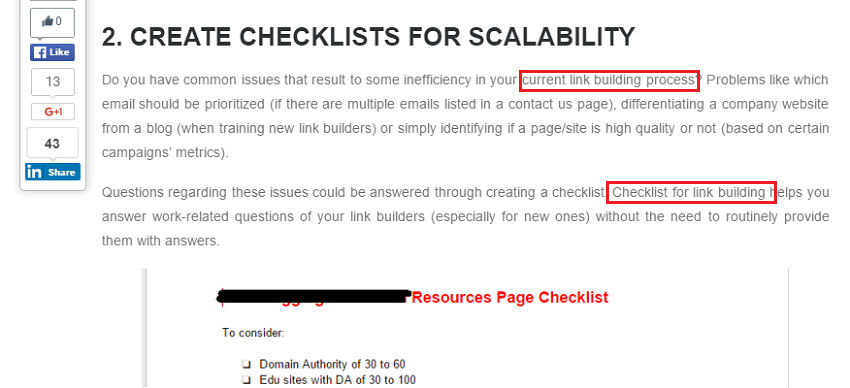
9. GIFT GIVING TO BUILD RELATIONSHIPS
Engagement marketing involves two sets of groups: those who are part of your networks and those you still need to reach out to – commonly referred to as “direct outreach”.
The good thing with direct outreach is that you don’t need to invest a huge amount of money and chunks of hours to start with. There is actually a less-costly way to effectively build relationships with influencers and authors who are part of your direct outreach.
James Norquay from Prosperity Media showed how a set of cupcakes from his client can strengthen relationships built with their brand partners.
Another example of this link relationship-building technique is when Larry Kim of Wordstream sent letters of appreciation to customers and to people who became a great part of building his brand.
Want to know how to execute a strategic approach in engagement marketing? Here are actionable tips to start an effective community engagement.
STEP 1: Identify one valuable thing you can offer to your brand followers or potential brand ambassadors.
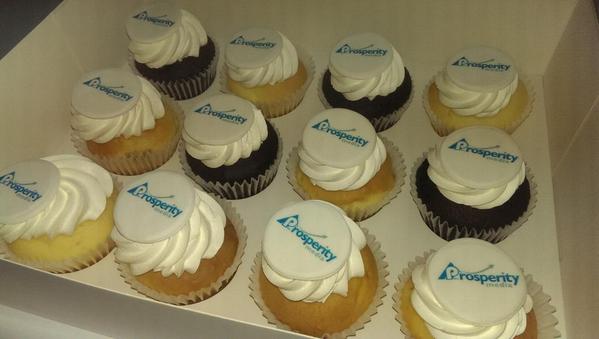
STEP 2: Think of ways on how to deliver your gift to your list of recipients. It could be through international or local shipping and/or an online transfer system if your gift is a virtual product.
STEP 3: Once the gift is released, you can track web and social mentions from influencers using BrandMentions.
For more ways to build high-quality backlinks to your website, check out this list of actionable link building strategies.
10. INVEST IN GETTING REFERENCES FROM Q&A SITES FROM REAL PEOPLE
The nature of searchers in this age of web usage is leading towards search activities in very niche-targeted search engine sites and community sites, where people would look for answers to their frequent questions from niche community sites instead of going straight to their favorite search engine tool.
Identifying these websites where a portion of your target market hangs out can allow you to acquire referential links that your competitors haven’t thought of building for their own sites.
The community-based backlink below is a good example of how powerful branding could help you semi-automate your brand’s link acquisition process. If you look closely at the answer, it is not a result of our marketing work, but from a person who trusted our expertise – Anton Shulke.
We actually did a webinar for his website and the benefit becomes mutual in the form of a link pointing to our brand.
How can you leverage branded link acquisition (off-page SEO) in community sites?
STEP 1: Create a list of outreach prospects that include your current brand followers, customers, and clients. Your brand followers could be any person you’ve built relationships with in the past either through content distribution, exchange of business ideas, or as simple as being your co-member in an offline/online niche group.
STEP 2: Look for relevant discussions that can potentially drive highly converting visitors to your site. In my above example, the keyword that I used is best SEO agency in Manila. The trick here is to use the site: search operator plus the keyword – e.g. site:quora.com “best X in Y” to generate targeted discussion pages.
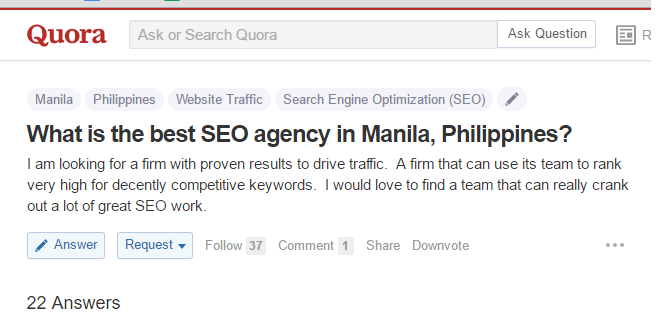
STEP 3: Reach out to your outreach prospects and ask if they can participate in the discussion. If they are your loyal customers/clients, they’ll likely give a recommendation to your brand.
OTHER USEFUL RESOURCES:
- Google’s New Review Search Option And Sentiment Analysis
- Why You Need to Find All Your NAP Variations Before Building Local Citations
11. TRACK MENTIONS FROM RELATED COINED TERMS
Link reclamation is probably one of the first initiatives when doing a strategic off-page SEO campaign for a website that has established authority in its vertical. It is because there is a higher probability of getting your first set of in-content links simply when you reach out to people who are familiar with your brand and have used your resources in their content works.
In addition to tracking mentions of your content assets, you can also do the same strategy to your competitors’ resources. There are many types of content assets you can actually track to see if there are publishers or bloggers who used your competitor’s content in bloggers’ websites but not credit their original sources.
A few examples are images created by the brand (infographics), mentions of your products, embedded Youtube videos, and other content that deserve credit in a form of links.
How to use competitor-based link reclamation strategy to your own advantage?
STEP 1: Identify the top-performing pages of your competitor’s site by using CognitiveSEO and using the number of referring domains and page authority as your performance metrics.
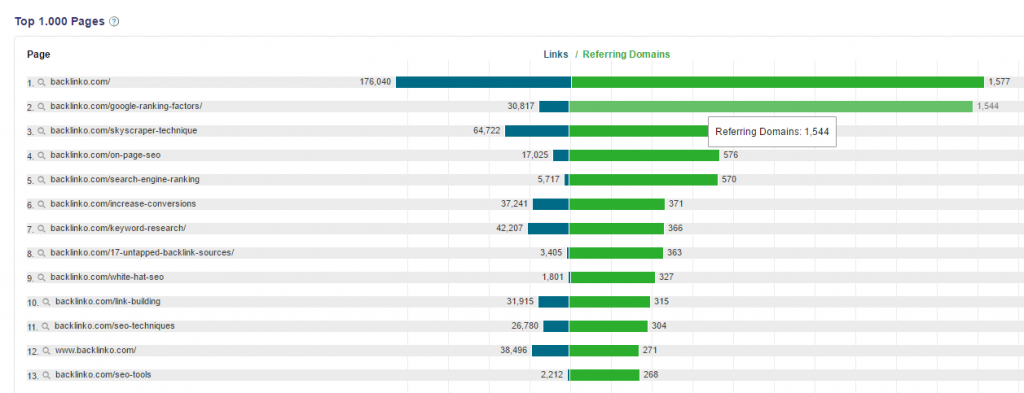
STEP 2: Track upcoming mentions of chosen resource/content of your competitor using BrandMentions. The tool will automatically notify you if there are new mentions, whether they are linked or unlinked on other content distributing sites.
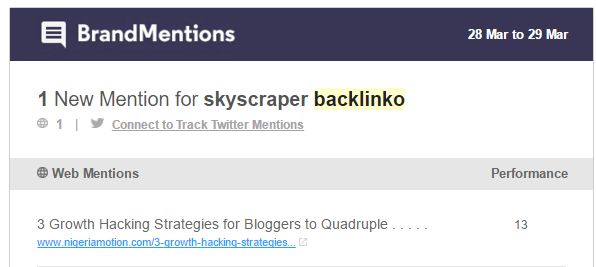
STEP 3: Find a resource of yours that is similar to your competitor’s content. Reach out to the blogger and pitch him showing your related content. You don’t need to ask for a link, it will be automatically given once they perceive your content as valuable.
12. REVERSE IMAGE SEARCH FOR LINK PROSPECTING
Reverse image search is an effective off-page SEO practice that helps link building practitioners to find out blogs where the image has been embedded. If the blog is linked to a wrong image source, it is best to ask him for the proper credit.
Though this off-page SEO technique is mainly used for link reclamation, you actually apply this same strategy to your link prospecting process. How?
STEP 1: Find a competing visual asset in your industry. It could be the infographic you tried to post on your blog that gained massive social shares or a generic image created by an expert in your field. You can use a simple Google image search like “infographic” “industry” to find these popular visual content assets.
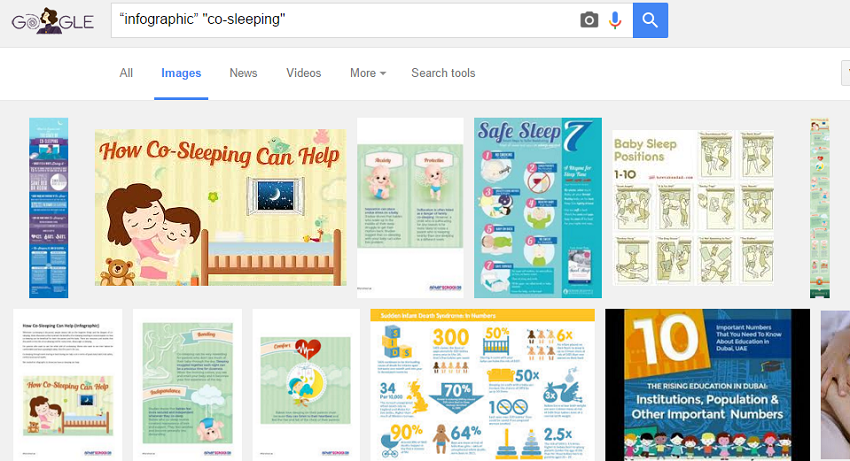
STEP 2: Grab URLs of these visual assets and plug in your favorite reverse image tool to find websites that embedded them.

STEP 3: Add those websites in your spreadsheet as your additional backlink prospects. Reach out to them with a unique proposition, not necessarily for the purpose of image link reclamation.
13. COLLABORATE WITH INFLUENCERS/AUTHORS
Aligning brand strategy with your off-page SEO process enables you to strongly build relationships not only with like-minded bloggers but with entities in the same vertical.
This helps your brand to position itself on the web and on its specific field by being perceived as a credible and trustworthy website by search engines and by target searchers – because links coming from trusted websites are good indicators of a site’s trustworthiness.
One simple branding approach is collaborating with niche influencers and authors for content creation. Given that they had industry experience in web publishing and a massive audience following, touching base with them assures the quality of a content asset and a more effective content promotion than doing it alone.
How does influencer outreach start?
STEP 1: Find influencers and authors in your niche who’ll be interested in a content partnership. Do a Google search for “guest post by” [ industry ] to search for this kind of personality.

STEP 2: Identity what kind of mutual benefit you can offer to your outreach prospects. It could be asking them to answer a set of interview questions, to be compiled and published on your blog, or cross-publishing content pieces – i.e. embedding your infographic to his blog in exchange for a guest article on your site.
One pro tip here is to actually look at your prospect’s latest articles and see what type of content they usually publish and in conjunction with your content publishing – what type of asset do you want to test out on your website.
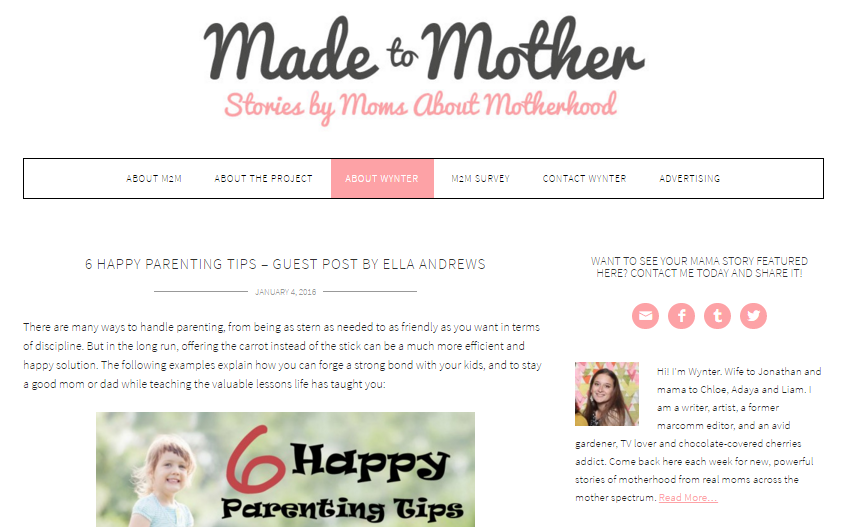
STEP 3: Send straightforward pitches with strong value propositions to capture their interests
Useful Resource: 50+ Ways To Increase Website Traffic (Roundup)
14. FIND HIGHLY CONVERTING OUTREACH PROSPECTS IN MOMENT QUERIES
Targeting high-profile bloggers who are likely to convert into linkers is one main objective of a blogger outreach campaign. But that’s going to be really tough if you don’t know how to find them.
Searching the web for potential linkers is one initiative you can start in your link prospecting process. However, your search phrase (keywords plus search operators) should be as very specific as possible to get the most refined results from search engines.
One off-page SEO technique to be very specific with search pages as well as to increase response and link acquisition rates in your outreach is to actually use in-moment options in Google search.
This means that pages that will appear in search results are assured to be published within the past hour or past 24 hours from the moment of search.
How to start with this link prospecting technique:
STEP 1: Do a Google search for your preferred search phrases.
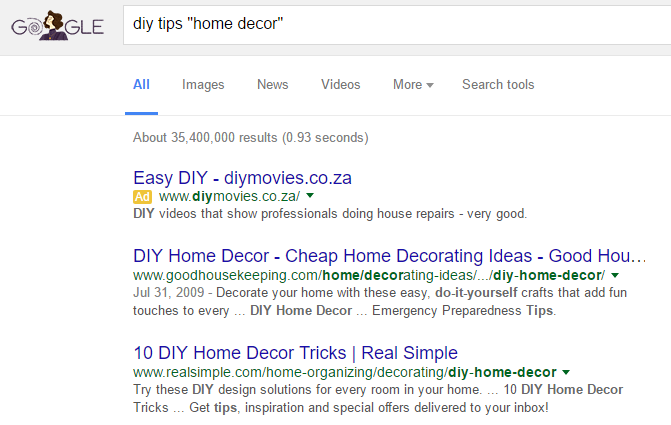
STEP 2: Filter the results by date of publishing (Search – Date – hour or 24 hours).
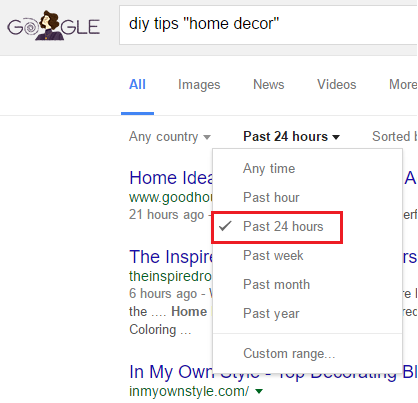
STEP 3: Gather those pages that are relevant to your niche and put them down in a list. Qualify them based on your link metrics and reach out to them afterward.
15. USE LONGER STRINGS FOR HIGHER CLICKS FROM LINKS
Links have been a top-ranking signal in search today and this has been proven many times - see these posts at SEOAuv about link importance and this experiment on Moz on how long links can influence rankings).
Links help websites rank in organic search. This is unarguably true. However, many marketers forget other objectives of links like driving visitors to a linked page. If it does generate visits, acquiring links can also become a very strategic approach to increase followers, subscribers, and brand advocates.
If you are distributing content to other blogs – i.e. contributing a guest article or providing answers to interview questions, make sure you only add niche-specific resources to your contributed piece. If the topic is email list building, don’t add any pure on-page article to content unless it is contextually relevant.
State the value of a referenced resource by giving readers a preview of the information the content includes. The best way is to actually use longer strings to describe what the content is all about.
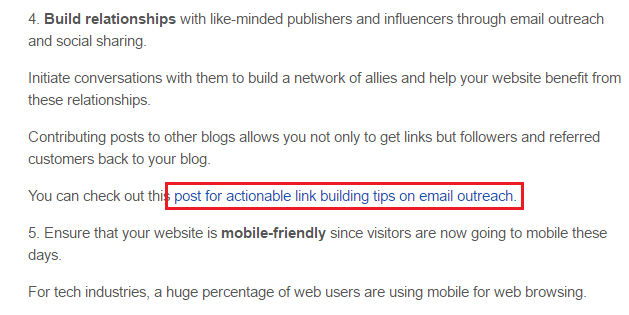
16. ACQUIRE NEWSLETTER LINKS
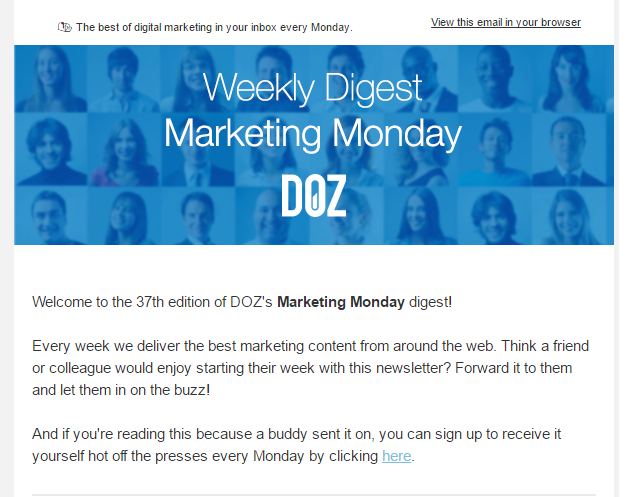
Email newsletters are good sources of information from publishers. This information could either be a curated list of links from top articles of the week or a preview of a new blog post posted on the hosted blog.
Getting featured in these newsletters is a very powerful branding/marketing strategy, as it allows your brand to distribute its own content massively to a different audience which will also help you increase your existing followers if you absorb active social sharers from other blogs.
Eventually, when these followers are fascinated with your blog content, they will eventually be your brand advocates who might be interested in linking to your content assets from their own websites and social profiles.
That’s why identifying newsletters that allow external linking to other relevant sources is a huge advantage for marketers. Exclusive feature in newsletters becomes a profitable off-page technique nowadays.
Follow this simple step-by-step guide to get featured in topical newsletters:
STEP 1: Create a list of blogs that feature top resources in newsletters on a monthly, weekly, or daily basis. You can also check out your current list of outreach prospects to find newsletter-featuring websites.
Once you’re done with the list, take note of how periodically these blogs send emails to their subscribers by looking at some obvious statements on their available opt-in or landing pages on their websites.
STEP 2: Subscribe to these blogs’ email lists and know what kind of resources these newsletters usually link out to (identify similarities in form, length, and theme).
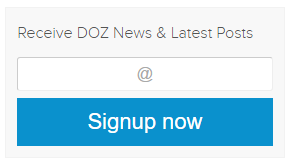
STEP 3: Constantly provide actionable and useful content on your blog to build a strong readership following and to get recommendations to be featured in other blogs’ newsletters. If you are not getting any exclusive email feature after months of content publishing, you can try reaching out to publishers in your earlier contact list and ask if they are interested to see a new user guide or resource.
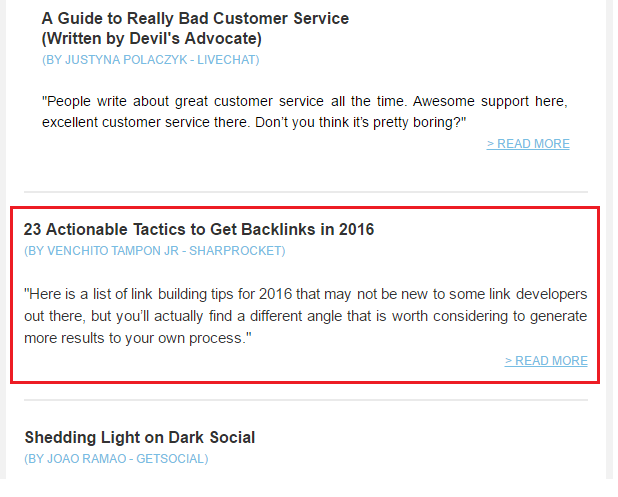
17. ADJUST REFERRAL COMMISSION RATE FOR AUTHORITY BLOGGERS

Relationship building matters in online marketing as it helps you build a strong following base that is capable of introducing your content to new readers, who might actually be your potential linkers.
Bloggers, especially those who are professionals, are part of a market segment that has the highest response rate among all online users simply because of their availability and full-time access to the web.
Building relationships with these bloggers allow you to dominate a particular part of your market segment, given that their followers could also connect with you for different forms of partnership. This is a compounding effect to your branding campaign since you will get a double portion of the market – your target bloggers and their followers as well.
The best way to initiate this off-page SEO technique is to offer an affiliate program or a referral commission system to attract bloggers in reviewing your products or services. Here are some steps you can follow through:
STEP 1: Create a list of bloggers who might be interested to write a review about your product/service or might share some stories and insights with your offering.
STEP 2: Segment your list of bloggers based on their social following base (Twitter followers), authority, and their websites’ factors (i.e. referring domains, domain authority, estimated organic traffic in SEMRush).
You can also add the format of content they usually produce on their website. If they can produce more than one – i.e. articles and webinars/videos/podcasts, it’s a good sign that they can engage their audience with different content types, which is very important in retaining the interests of your target visitors while consuming your product/service review.
STEP 3: Prioritize reaching out to authority bloggers. Offer them a higher commission rate so you can easily entice them to write a review about your offering. You can also make cross-publishing an additional value proposition in your outreach. The idea here is to make the off-page SEO strategy beneficial for both the blogger and your brand.
For example, your brand will get an additional following base and potential customers from the product/service review and the blogger will also have the advantage of co-branding himself by publishing an article to your brand’s blog and adding it to his portfolio or about page (as featured in….).
18. GET OUTREACH DETAILS FROM CLEARBIT
Finding a person’s name and email address is the initial phase in link building outreach. This is where most of your outreach initiatives will depend on given that if you find wrong contact details, obviously your pitches won’t be taken to the right place.
When finding outreach prospect’s personal details, it’s very important to use effective web-based tools such as Clearbit. I personally use Clearbit as an alternative tool for Rapportive because the product is capable of giving you the free email address of the person you’re contacting, not only validating it if it’s actually working.
How to use Clearbit for initial pitch:
STEP 1: Install Clearbit to your Gmail Chrome Extension.

STEP 2: Click “Connect” link at the upper right side of Gmail and choose “find an email”.
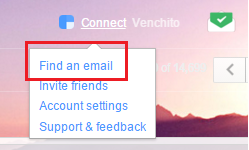
STEP 3: Type in the homepage URL of the site you’re extracting the email address from. The tool will automatically provide names of people working for the company and/or are included in the website. Choose the person you’d like to connect with.

19. COMMENT-BASED LINK PROSPECTING
Link prospecting is the initial phase in link building where you’ll start to find possible link targets from verticals that are relevant to your website. This is also where your entire link acquisition campaign will depend on, as this initiates the process and helps you identify what particular methods you’ll be performing to acquire links from your target backlink prospects.
Creativity matters in link prospecting since you have to choose the right keywords that will be able to generate refined page results in search engines.
One off-page SEO tactic we’ve been using for our link research campaigns for our clients that are very effective in providing high-quality blogs is adding the number of comments to a specific link prospecting phrase. Here is how you can exactly do it:
STEP 1: Add comment plus number to your prospect keywords (“comments(8)” “keyword”) and generate results on search.
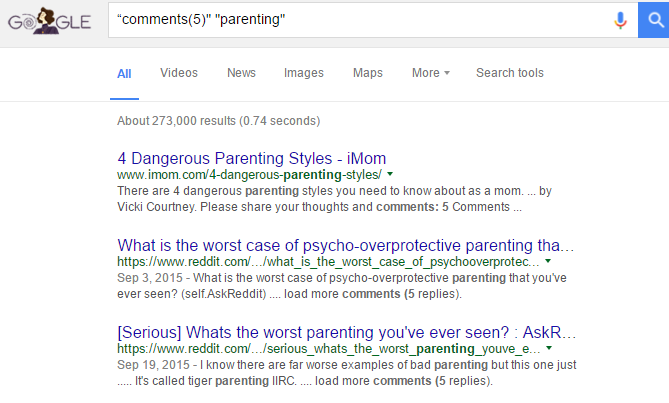
STEP 2: Qualify results based on your brand’s link metrics. Discover new backlink opportunities by checking links inserted in blog’s comments.
STEP 3: Try using the following comment-based search phrases to collect more backlink targets:
- “disqus” “keyword”
- “commentluv” “keyword”
- “notify me of follow up comments” “keyword”
20. CREATE LOCAL NICHE PROFILES
The ability to dominate a market segment, particularly if you are a local brand, highly depends on the brand awareness you build in your local community, whether offline or online.
Local link building nowadays is leading towards partnerships with local organizations and institutions as well as really getting into the minds of your customers (mindshare), which is a solid combination of an off-page SEO strategy that can certainly impact your lead generation process.
One easy way, but mostly overlooked off-page SEO technique in building local links is creating niche profiles.
I’ve noticed this recently when we had a vacation last month that instead of searching in Google for the best restaurants located near our vacation place, we go straight to a popular local website that features nearby restaurants and food stores – Zomato (which is actually a recommendation of one of our friends).
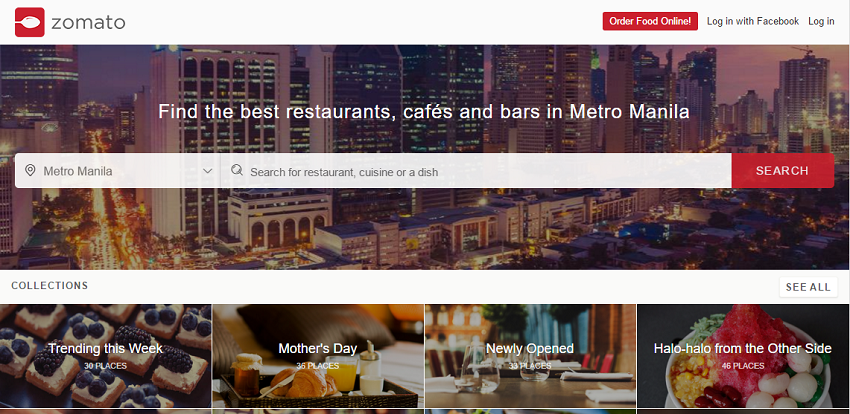
Having said that, creating local brand profiles that are targeted to an industry you’re trying to promote your products/services to, is a handy technique you’ll generate high returns from your marketing efforts.
Other Useful Resources:
21. STRONG BRAND MESSAGING
Brand building is the new link building and off-page SEO strategy in digital marketing today, given that when brands become true to their core values, messaging and personalities, it becomes easy for them to penetrate and dominate their target audiences.
There are many ways to send a strong brand messaging without actually hard-selling your products/services, below are some steps you can apply:
- Identify your brand’s core competence, to be able to know where you would put most of your efforts.
- Invest in creating comprehensive resources that will give the best answers to commonly-asked questions in your industry.
- Provides satisfaction and excellence to existing customers or clients so you'll acquire hard-to-built links that your competitors can't easily copy (see this link we've earned recently).
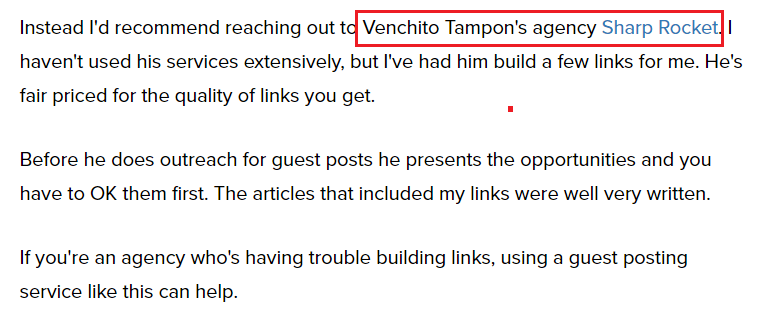
The Definitive Guide to Blogger Outreach
What is blogger outreach?
Blogger outreach is the process of building genuine relationships with industry publishers and bloggers to find a common point of interest where both ends will benefit.
At SharpRocket, thirty percent (30%) of our work is spent on blogger outreach. Making sure that every email penetrates the inboxes of recipients and secures positive responses, requires us to strategically prepare the outreach list before they are sent away.
In this guide, I’ll walk you through the exact outreach tactics we’ve implemented to our clients plus tools that we utilize to improve the entire process – from gathering contact information to nudging bloggers to link to the content.
Other Definitions of Blogger Outreach
Before getting straight to the how-to section, let me give you some definitions of blogger outreach from what we’ve considered as linker outreach veterans.
Blogger outreach is the process of contacting bloggers through any communication medium for the purposes of collaborating on projects, such as giveaways, content publishing, or sponsored posts.
Ross Hudgens, Founder of SiegeMedia
Blogger outreach is a marketing channel, which involves building relationships with bloggers to form mutually beneficial partnerships. The aim of these partnerships is to effectively promote one's business, while simultaneously providing value to the blogger and their audience.
Dave Schneider, Founder of Ninja Outreach
5 Blogger Outreach Best Practices
What makes practices best in their natures are small differences that can take mediocre emails to outreach emails that convert into high-value links. When others are looking forward to new strategies or tactics that can be tried and tested for a change, there are small overlooked details you can already apply to create success for your next outreach campaign.
1. Tracking Open Rates With Mailtrack.io.
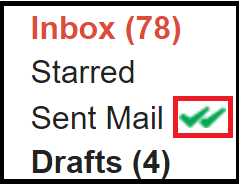
One missing metric of many outreach campaigns we’ve encountered is the open rate. Open rate is basically the ratio of emails opened (whether they landed a coverage or not) over emails sent.
If you are handling several outreach campaigns, you get to overly focus on emails that received responses from bloggers and tend to overlook opportunities from emails opened yet not replied to.
If you can track the latter type of emails, you can build potential equity you would have missed if you remove it from your outreach database or you just follow up with them with the same initial email template.
One best outreach tool that can aid you with this is Mailtrack.io. This blogger outreach tool enables you to know if emails had been sent to their proper places and if the person you’re reaching out to opens your email. This provides you insights to better understand the majority of your outreach prospects. If a person reads your email but didn’t respond to it, you can draw hypotheses from these:
- Your content offering doesn’t cut through the interest of the blogger.
- Your subject line attracts but had no relation to the body of your email.
- Your email is fully promotional in nature.
From this hypothesis, you can take actionable measures which you can read in the latter part of this guide.
Back from the great functionality of the tool, Mailtrack.io offers the said feature for free. So if you are weighing budget with outreach ROI, the tool helps you save product costs.
2. Encouraging Response With A Content Proposition
Mediocre outreach specialists send emails with naked URLs to view their content. Without trying to describe what the content is all about and how it does help bloggers’ readers regarding a topic, the email is near the same as spammy bulk blasts. Both don’t provide enough value.
Instead, you’d want to capture the blogger’s interest by stating the unique proposition of your content piece – know what differentiates your content from others and explicit it. Including social proof in your email also builds credibility to your content - e,g, how many influencers had shared your content asset.
Besides content proposition, there is also one way to leverage interest – that is, visitor engagement. This is often stated in broken link building campaigns which goes like, “If you fix the broken link in your resource page, this will help your visitors find the referenced resource”.
Apply this same principle to blogger outreach. You can structure emails that end something like this:
If you think adding more interview related references to your page can make your website visitors engaged, let me know if you'd like to see it.
With this type of proposition-based call-to-action, you encourage more positive replies from bloggers instead of letting them view only your piece.
3. Leveraging Specific Subject Lines
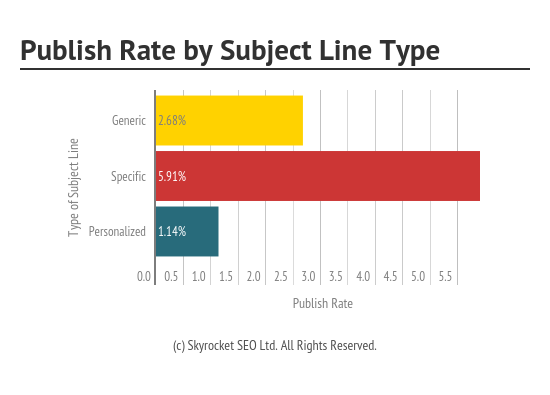
Personalization gets so much attention from the link building community, particularly those whose main task at an agency is outreach. It’s easy to pre-conclude that because an email is personalized, it would help the content earn links instantly.
That’s not always the case. If you’re crafting a long customized email, the person who will be reading this would lose his interest at the start. Brevity lacks in some way.
That said, one good piece of advice here is to segment your outreach list based on priority – identify which bloggers needed to pitch emails with a strong level of attention. For low to medium-level bloggers, you can create an email template with specific subject lines, such as, “hoping to be included in your career resource”, which would only require small tweaks in the email replacing attribute tags such as name, site name, and target page.
In their latest outreach data, Skyrocket had seen no evidence of getting better results by crafting personalized subject lines in emails (see image above). Besides ease in crafting individual emails, there is uniformity among outreach specialists who work on the same blogger outreach campaign. Also, it saves a ton of time.
4. Highlighting Attribute Tags
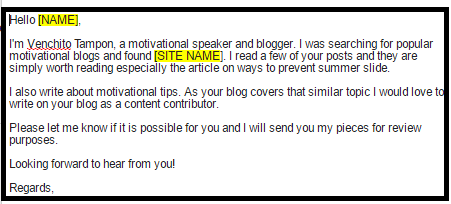
As a company that loves outreach, crafting email copies is essential in scaling the initial blogger pitch, which are structured in such a way it could be customized for certain people. This provides us the luxury to spend more time in relationship building once the conversation started, instead of exerting extra efforts to fully personalize emails.
Keep in mind that because email templates are great, they aren’t prone to some human errors. If you happen to send emails to editors without replacing one of the attribute tags ([name], [site name], etc..), you end up losing the potential equity you would get from the conversation you try to make with the editor.
More so, if you aren’t careful with replacing attribute tags with website details, there are possibilities of receiving replies that say, “that is not my website” or “you should have researched my website first”.
One minor error in tag replacement is a major error in the entire outreach process.
If you value every single outreach prospect, one tip here is to highlight attribute tags when constructing email copies or canned responses, so if you feel you have forgotten one of the details, you can easily skim the entire email draft before actually sending it. If Gmail is your preferred outreach platform, it is a lifesaver option to enable the Undo feature –which helps you to revoke your mistake.
5. Bridging Conversations Through Email

If you’re not maximizing other mediums of communication aside from email, you’re missing out on opportunities that might get you to faster coverage of links.
At SharpRocket, we’ve tested using Twitter in our link prospecting phase and we’ve found great blogs out of it. It also gives us a clue that there are visible industry blogs in this social platform that if we’ll be going to reach out to, we can bridge relationships that can convert into links.
Creativity matters in blogger outreach. If you’re an outreach specialist, you shouldn’t just sit down when you can’t contact the person through email, but find at least two other ways to approach the person.
Initially connect with the outreach prospect using social media platforms like Twitter and bridge the latter part of the conversation through email. There are a few good reasons why I think this workflow works. First, you avoid communication errors caused by email technical issues. Second, you can validate the email to contact to by asking it straight to the Twitter handler (blogger).
Here’s an example of an exact email that shows how this practice works:
Writing this further to our conversation on Twitter (I'm @nirajr). Great to be connected.
6 Blogger Outreach Tools
This definitive guide to blogger outreach isn’t complete without tools that can aid you with the entire outreach process. So here is a list of tools that I highly recommend and we have actually used and tested for our clients, which you can also try to take your campaign to the next level.
1. Email Hunter
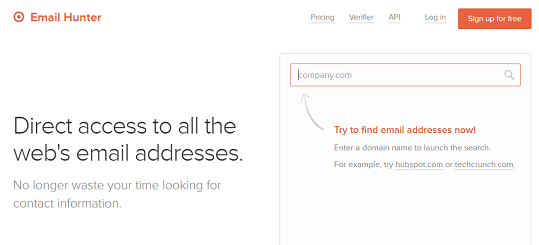
Email Hunter is a great freemium tool in finding email addresses without actually dumping to each individual pages of the website to collect the contact details. It’s definitely a time-saver tool for bulk lists of outreach prospects that might need hours for manual searching of email-addresses.
However, when Email Hunter pulls out data, it would provide a long list of contact emails, so you have to manually choose which email to contact to (preferably this kind of email format – name@domain.com). Later this guide, you’ll learn about our list of prioritized email formats that respond to pitches we make.
2. MAIL TESTER
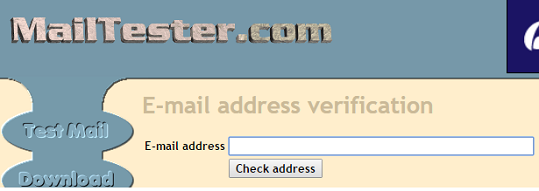
If you’re doing blogger outreach for years, you probably would agree with me that an outreach campaign usually comes with “Mailed Delivery Messages”. If you skip these errors and you try to find secondary emails to replace them with, you can consume some minutes, which should have been used for other outreach workflows.
You can avoid said type of messages by validating emails before you actually pitch them. Mailtester does help determine if emails are of good use, which minimizes your time searching for secondary-level emails.
3. BUZZSTREAM
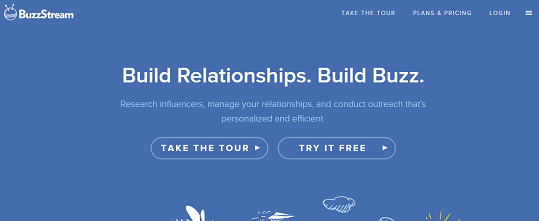
If you land on a website and you want to contact the blogger straight from the browser, you can do so with Buzzstream’s Buzzmaker tool. The tool gives you the luxury to execute immediate blogger outreach without using the main outreach dashboard.
Buzzstream lets you also track emails that converted into links and enables you to label emails with specific relationship levels, so you can monitor which ones should be prioritized.
The said tool works effectively for large teams of link builders and outreach specialists.
4. PITCHBOX
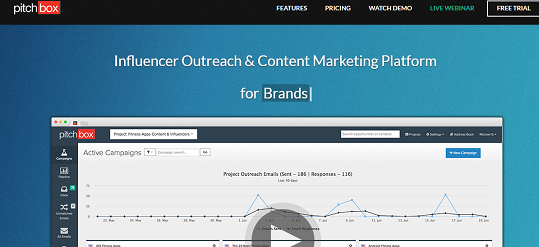
Designed for small teams of link developers, Pitchbox allows you to automate follow-ups and consecutively send them to bloggers with a set amount of time interval between each follow-up. If there is no reply within the first days after an email has been sent, the tool sends another follow-up email – which takes away the trouble of checking if the next set of follow-ups cut through the inboxes of outreach prospects.
Additionally, Pitchbox’s difference-maker is the ability to create pre-built reports – a definite time-saver for outreach managers wanting to grab email data (i.e. number of email responses vs number of emails sent). Instead of manually computing these numbers, you can automate the reports by clicking on buttons.
5. NINJA OUTREACH
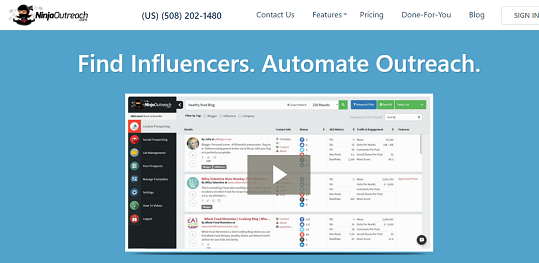
Ninja Outreach’s handy feature from a blogger outreach perspective is allowing you to pre-fill contact forms with email templates upon visiting contact pages of blogs. If you guaranteed that a certain person is qualified to reach out to, the said feature of Ninja Outreach saves you time not revisiting them for future outreach.
Generally, if you have a basic to intermediate level knowledge in the overall blogger outreach process, the tool has an easy user interface that helps you execute everything from link prospecting to email outreach.
6. MEME GENERATOR
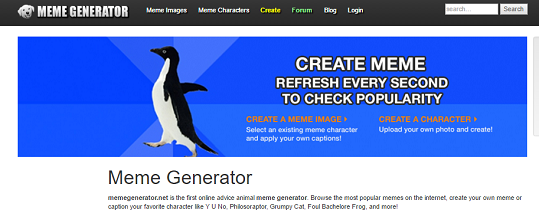
For saturated niches where bloggers receive dozens of emails every day, it’s ineffective to send emails that almost look like other blogger pitches. While it’s true that content can speak for itself, transitioning your emails from good to great necessitate your email to stand out.
One way to do this is to tweak some parts of your email that will add humor to your message but still encourages bloggers to respond to your pitch (see image below) - hat tip to @seoteky.
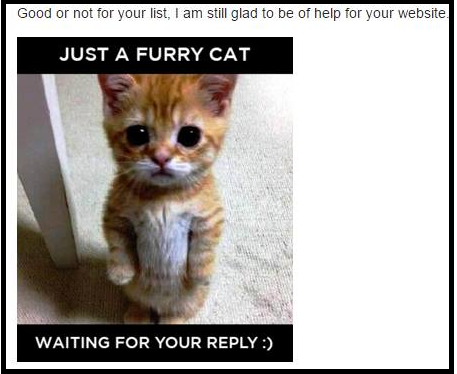
THE SCIENCE BEHIND EFFECTIVE BLOGGER OUTREACH
Data, in particular psychology studies, leverages the results of the entire workflow of blogger outreach – as it reveals things that needs improvement or removal and helps plan strategies that almost-predict results in the next campaigns.
Below is a curated infographic of external research studies generated from analyzing thousands of emails sent to different people. This will definitely help you craft outreach emails that guarantees more than average success.

Share this Image On Your Site
If you’re looking for more supporting data of this infographic, here are the step-by-step breakdown on the science behind effective blogger outreach.
USE CC FOR TWO RECIPIENTS
When gathering contact data of publishing sites, you mostly see that twenty percent (20%) of these blogs are coupled with multiple authors and/or team of editors. This may raise confusion on which one of these people you should be reaching out to.
At SharpRocket, we had a solid chronological preference on which email should be collected first.
- Visible email - find the most visible contact email on the page (for resource page) or on contact pages - domain.com/about or domain.com/about-me (for blogs).
- Personal email (e.g. venchito@digitalphilippines.net). Use Rapportive or Clearbit to validate if it’s the actual email being used.
- Contact page of the sole author
- Department / Position-based - identify the person who is capable (at most) of accessing the website and editing the article/page.
- admin@domain.com
- editor@domain.com
- info@domain.com
If there are several emails to choose from, collect two of them and save it to your database.
In the study conducted by Yesware, they’ve found out that emails sent to one person while cc’ing another are 12% more likely to get response than email sent to two people.
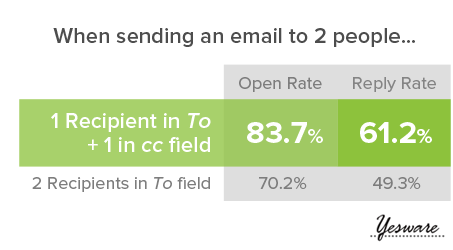
The probable reason for this is that the one person who directly receives the email has the responsibility to take an action, because there’s another person looking at the email. This also encourages the other person to reply if the primary action doesn’t take place. Needless to say, you can receive more response by only sending an email to one person while cc’ing the other recipient.
One quick note here is do not try to get the following email formats from prospect sites, as emailing them would directly go to support, customer service or sales group - they won’t take time if your pitch isn’t product-related.
- sales@domain.com
- support@domain.com
- service@domain.com
- hello@domaincom
- office@domain.com
The next best option when these emails are only available in the website is to grab the site’s page where it locates the contact form. Then direct your pitch through that form.
MAKE SUBJECT LINES CONCISE
ReturnPath shared an interesting study on subject line usage, which shows that 49 subject line characters or less gets 12% open rate and 75% CTR higher than those with 50 characters or more.
This may require immediate testing to make results possible for your campaign, but in essence, the reason it works is the brevity of the subject line.
Make your subject lines straightforward so busy bloggers could get the whole point of your message – definitely makes your email stand out.
REFERENCE PAST ENGAGEMENT
What most link developers or SEOs didn’t truly understand about relationships, is its ability to create a flywheel of links with low maintenance cost and efforts. When you connect to publishers, particularly those that gained mutual content benefits, it’s a less hustle to distribute a newly-released content to a target audience if you have a network of publishers to promote your resource.
Use this to your own advantage.
A smart outreach strategy starts an email with a reference to any past engagement with the publisher. Whether it’s a Twitter conversation or a recent offline interaction, a statement indicating a relationship gives a cutting edge to outreach results.
Buzzstream and Fractl found that 66% of publishers are more likely to open an email with a subject line referencing a past relationship. This added small detail to subject lines makes a big impact, if executed properly.
PERSONALIZE SALUTATION
If you want to get higher ROI from outreach efforts, personalization is a must-have rule when crafting an email. While this part is a no-brainer, many still ignores its power. If you send a pitch to email formats like editor@domain.com, when the site has its own about me page, it’s easy to conclude that you didn’t spend a minute researching even just the name of the blogger.
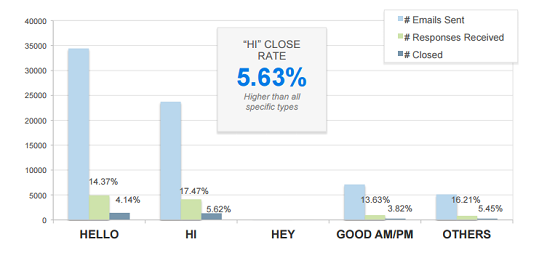
Additionally, using “Hi” as your greeting can improve close rate 5.63% over all other specific types based on iAcquire’s lessons in analyzing 300,000 custom outreach emails. There is no particular conclusion from this, but somehow reflects on the idea that greetings like “Hi” is commonly used in normal conversations.
WRITE SHORT EMAILS
Brevity in subject lines complements with short body email messages. Among thousands of emails, SiegeMedia concluded that the highest converting email length is an average of 83 words. Their hypothesis? Short enough to be easily readable, long enough to be customized.
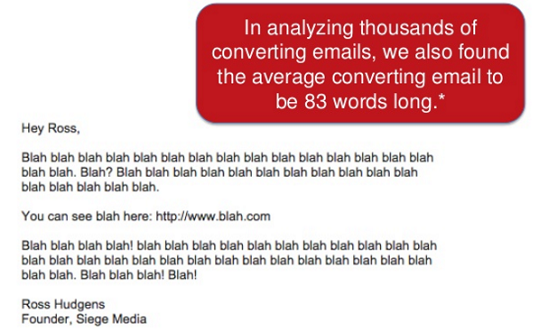
Be careful though when you customize email copies and before hitting the “send” button. You can get messed up by not replacing attribute tags (i.e. {Name} and {Site Name} or using two email templates in one email – one copy is at the bottom of the email (not visible at first glance).
USE SOCIAL PROOF
In email outreach, mentioning a social proof in the body of an email breaks the stranger barrier between the sender and the recipient.
When you include a mutual connection in your email, either a colleague, decision maker, influencer or popular publisher, it signals that you valued the opinions of others. This takes cues that you’re being related to a particular person they might know, which easily builds trust.
Studies of Yesware show that emails with social proof get 33% reply rate. Content-wise, if you’re being asked to promote a certain content, you wanted to know if the resource has gained some traction already, guaranteeing shares and additional links to your site when it is promoted.
A few social proof examples that are worthy to be mentioned in your email:
- 3000+ shares on a piece you’ve shared recently
- Contributor’s badge for a large publication site
- Number of publications or media exposures you’ve been featured in
- Name of industry experts you collaborated with
INCLUDE TRUST SIGNALS IN FOOTER
Aside from social proof, there is also one trust signal that can drastically increase your campaign’s link acquisition rate – that is, branded logo. If you’re reaching out to bloggers in behalf of a client or your company, adding a branded logo to your email makes success possible.
A few statistics to consider, gathered from iAcquire’s outreach case study:
- Emails without logos – close rate at 3.72%
- Emails with embedded logos – close rate of 6.03%
- Emails with linked logos – 10.58%
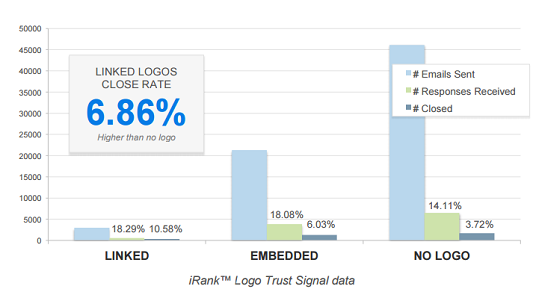
If you’re working in an agency as an outreach manager, ask permission from your clients first before sending emails to bloggers with embedded company logos. Some white-label clients don’t want their brands disclosed in the blogging community – outreach specialist will act as a generic content marketer finding the resource worthy to be promoted.
SEND EMAILS EARLY MORNING
Bloggers either full-time writers, in-house specialists or business owners have their own specific hours in a workday to check email inbox. Taking advantage of this increases the chances of your outreach emails being opened. So the next time you pitch bloggers for any reason, consider the best day of the week and best time of day where they’ll likely see and prioritize your email.
Buzzstream and iPullRank found that email sent between 1AM and 9AM return the highest placement and response rates. Hypothetically, if you schedule emails in this range of hours, you’ll increase the chances of getting your emails read and prioritized by your target bloggers for emails responses.
Additionally, pitching emails at best email reading days converts better than them on any particular day.
In the recent study by SiegeMedia, it shows that Monday is the best day to send initial outreach emails among other days. Monday emails also converts 80% better than Thursday.
In my opinion, Monday works best primarily because it is the start of the working day. Bloggers have the energy to respond to as many relevant emails they supposed to answer.
WITHHOLD LINK IN INITIAL EMAIL
I’m not a fan of being aggressive with email outreach. We usually pitch customize emails explaining why our content piece is worthy to be read and shared. Emails don’t include a naked link to view the content but rather just asking bloggers if they are interested to take one look at the resource.
SiegeMedia has the same approach with us of forgoing the link, to “catch and hold” the interests of bloggers. Once the interest has been captured, the next step is to maintain it. .
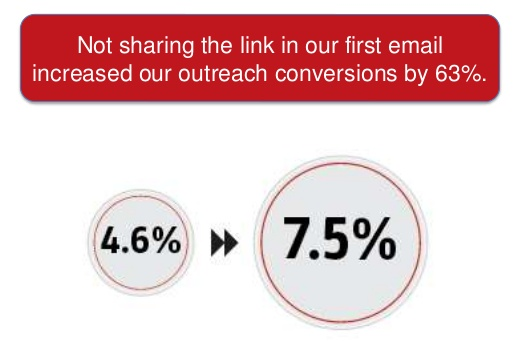
Starting the conversations first and keeping their interests until they decide to reference the work/resource better results to links than carelessly landing an email that gets to auto-spam filters – another reason why withholding the link in the initial email is preferred.
FOLLOW UP PEOPLE
Hubspot found that 50% of emails are opened in the first 24 hours. After 24-hour timeframe, 80% of emails were opened within 12 days of being sent.
If you didn’t receive any response after the initial outreach, you can follow up bloggers to increase chances of getting additional responses.
A silent conversation is worse than a solid “no” response. If you don’t get a response, you are stuck with a decision whether to continue the conversation or proceed to another prospect in the list.
If you decide to send follow-up messages, be mindful that too much of it can irritate the blogger – potentially can burn bridges along the process.
One way to avoid this is to send one last follow-up message to know the reason why they never had a chance to get back to you.
At SharpRocket, we send an email listing down three common reasons of silence and encouraging bloggers to choose one.
Here’s an email template we send to publishers.
Hi [ Name ],
I haven’t heard back from you, and that tells me one of three things:
1) You’re not interested at this time, but we can work out something in the future.
2) You’re still interested, but haven’t had the time to get back to me yet.
3) You saw our content but you think it’s not fit to add to your page.
Please let me know which one it is, because I’m starting to worry. If you have other reasons, please let me know so I can stop bothering you.
Thanks and looking forward to hearing from you.
[ Name ]
This follow-up email enables us to act on issues immediately, such as:
- Get back to the blogger when there’s another content/resource to offer.
- Schedule a custom follow-up to get an update after some time (for case 2).
- Improve content based on the feedback of the blogger (for case 3).
Based on our data, 70% non-respondents to first email would reply to a follow-up message above. This saves a lot of time for outreach specialists as they don’t need to reach out to the prospect again if the blogger decides not to be contacted again.
FURTHER READING:
Blogger Outreach The Right Way
Have We Been Helpful?
Want to take your link building to the next level – — but don’t know where to start, and are feeling overwhelmed by this post.
We are here to help you. SharpRocket is a team of link building specialists who love building high quality links.
To learn more about how we can help, take a look at the services we offer.
Six Small Differences You Can Make to Your Email Outreach
Outreach is an effective way to form relationships with people who haven't known/seen your brand, and are likely be interested to get more eyeballs to your content - either through contextual linking or social sharing.
It's easy to look up successful case studies in acquiring links and getting more traffic through email outreach. The step-by-step process is mostly indicated, but those little changes one can make to turn a mediocre outreach email into a solid placement of links are sometimes ignored.
So, let's take a look at some details that will improve the probability of getting the links you desire.
1. Validate Emails Scalably
Whether you've done large-scale campaigns or a one-time off outreach campaign, you always come across bounced emails.
These are email addresses that are either non-existent or maybe the receiving email server is temporarily unavailable, overloaded, or it couldn't be found.
In general, you don't have control over these bounced emails - but you can avoid receiving them by doing either of these two things:
- Check the validity of the email upfront.
- Find another email address that can be your second contact in case the first one bounces.
For the first solution, there are web-based tools that can aid you with validating emails - mailtester.com, and email-checker.net.
Doing so to each of your hundreds or thousands of emails can consume much of your time.
Instead, you can use Email Verification Tool to scale the validation of email addresses. This Google Sheet add-on below is easy to set up and automatically checks the email deliverability of emails.
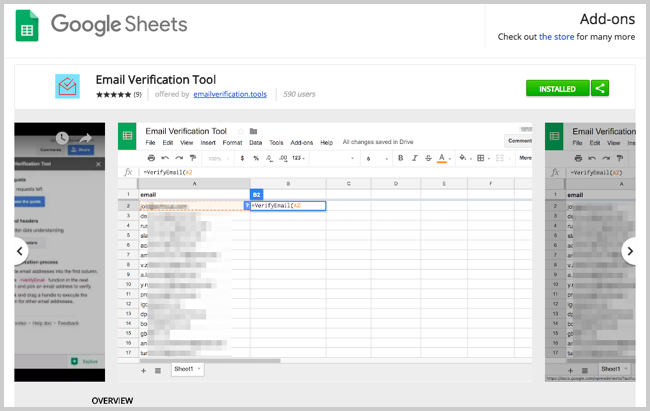
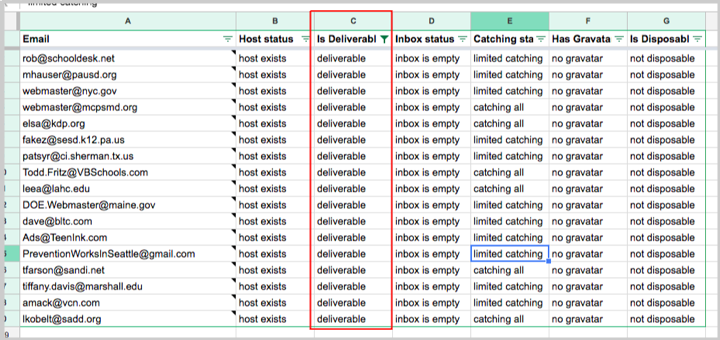
When emails are undeliverable, there are two options you can choose from:
- Find other ways to connect to your outreach prospect either through Twitter or Linkedin.
- Look for the next available contact person (editor, librarian, webmaster, etc..)
By scaling emails' validity upfront, it'll help you go for the next methods to connect to your link prospect. Not doing so is a waste of link opportunities you've developed for one specific website.
2. Ask "Who To Contact" For A Specific Page
When you're sending outreach emails, chances are the people you're reaching out to aren't the first-hand persons who handle the desired page you're trying to acquire a link from.
For those who know which person or department handles that single page and have been kind to send you the right contact person and his/her email address, you compose a new email, forward your original message, and send it to the new contact person.
That may not be always the case. Sometimes the thread of conversation gets longer until you found out he is not the right person to connect with for your link request pitch.
That said, one tip for you to add changes to your initial email is to ask who is the right person to contact.

You'll be surprised because they can helpfully give you the exact name along with his/her email address.
No back and forth emails. Less waste of time you can instead spend talking to the right outreach person.
3. Give Context In Your Emails
It's easy to copy and paste email outreach templates. But when you get replies like, "Which one?" or "what are you referring to?,” it's another lazy approach to send another canned response to get the link immediately (and hopefully proceed to another email conversation).
Without your contact person getting the right understanding of your outreach email, it'll be difficult for him to take any actions on your part.
One principle to consider is to always give the right context in your emails.
For example, if you've had the exact target page, it'll be better to include the Page Title of the resource page in your first email - providing your outreach prospect with the right context of your pitch.
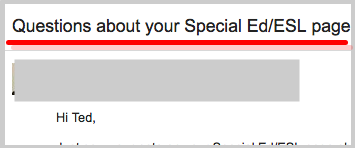
Relevance is crucially important in outreach. But when the context is misunderstood and/or not shown in pitches, it'd likely reduce your outreach placement rate.
4. Track Significant Rejections
Not all outreach campaigns succeed. For certain reasons, the link placements for target sites are not achieved - which lowers the conversion rate of the overall campaign.
Link building, in reality, is a hit-or-miss activity. Those misses particularly in outreach should be identified in order to make necessary steps, either to turn those rejections into link placements or better off use those rejections to make adjustments in one area of a link development campaign.
I'm a big fan of Stephen Covey's principle of "Circle of Concern" and "Circle of Control".
Basically, it shows two circles of choices that cover all the things in our life over which can just be concerned about or we can control of. These circles are called, "circle of concern" and "circle of control".
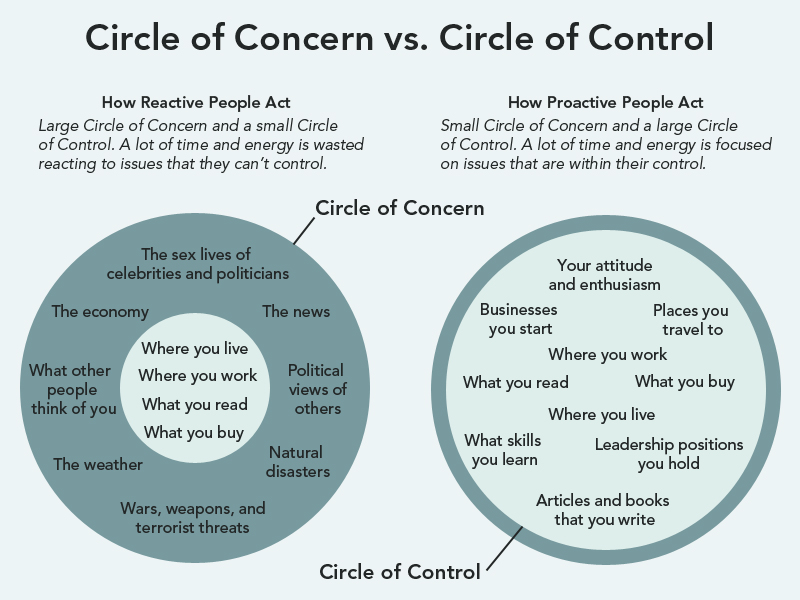
Applying that to outreach, we'll be able to identify which rejections in emails we have control over (make adjustments if we can) or simply a concern (have to move on quickly).
Here are some examples of rejections in outreach and guess which ones you have control over —make adjustments with your content/outreach/prospecting) or a concern that can be considered as a loss or reality of the campaign.
- The webmaster you're contacting is planning a website redesign (and may temporarily not be able to add any new external links).
- The daily schedule of the webmaster/link curator is tight and couldn't do you a favor of adding the link.
- The content being pitched to is topically irrelevant to the target page/website.
- The page where content is hosted can't be accessed or is displayed as an error.
There are a lot more examples I haven't included here, but the point of bringing this up is to track rejections that are only significant for changes or improvements in your content - through developing its format, user experience, and other factors that can affect users' trust. There may possibly be some necessary adjustments in your email's subject line and email copy used overall, which can hugely impact how your message will be perceived by the webmaster.
5. Value Time Of Contact Persons By Showing The Value Of Your Pitch
Giving descriptions that your content is "amazing," "comprehensive," "ultimate," or "complete" (even if it's not) while not showing why it can be described as such takes more seconds of reading your email than it actually should've provided value to your contact person.
Here are some tips to intelligently describe your content in email pitches:
- Let them know the format of your content piece. While this can be added straight to the subject line, it'll be more emphasized if it's repeated on the email body.
- Give one or two-liner points of the utility and comprehensiveness of your content, particularly if you're targeting resource pages where they've linked to similar pieces.
- Show actual social proof of the content - whose influencers and/or major local/niche media sites, for digital PR campaigns, the contact person may be familiar with that have linked to or mentioned your content asset.
Value the time your contact person will spend reading your email. By giving him enough reason to check out your content, you'll have more chances of acquiring editorial links from his publication.
6. Follow-Up With Another Email Format
Sending follow-up emails to non-respondent prospects is one fundamental activity in outreach. There are other reasons why it is a must-do besides getting a response from someone who hasn't read it.
- Take another chance with a non-respondent contact person who've read and seen the value of your pitch but hasn't taken any action yet (the follow-up email can re-confirm the decision and push the action further).
- Knowing the best times and seasons to connect again for people saying "can you get back to me during summer or start of the school year?". A follow-up email gives you a clue of their best moments to reach out to (make sure you take a note of this in your spreadsheet).
- Organize fairly your email contacts by changing relationship stages from In Communication to Not Interested those who are not really interested in your pitch - which saves a lot of your time sending them another email either from the same website/project or of another one.
There are two ways to approach follow-ups: sweet and short follow-up email or a follow-up that tells three options that they can choose from.
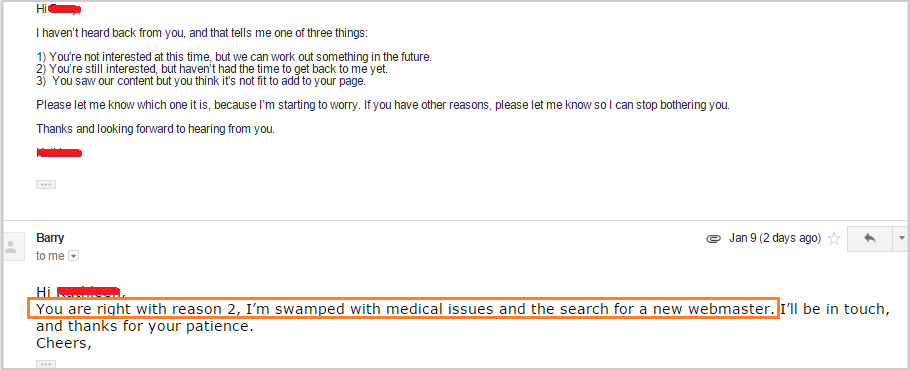
Don't be lazy in sending follow-ups given there may be missed link opportunities you should've probably gotten if you skip on them.
One recommended practice is to create your own email experiments for your initial and follow-up email templates: A/B testing subject lines, email body, email sender, and any email fragments that are worth testing.
It is best to both have a bandwidth to do what already works (email outreach best practices) and have enough left for trial and errors in email experiments.
Need help with link building? Check out our link building services.
Brand Building Strategies for Modern Day Link Building
Brand building is the new link building.
Keyword-centric link building is long gone. Focusing on a large percentage of exact match anchor text usage on inbound links will do more harm than good for your website.
The way to win in search nowadays is to start thinking brand-first.
Over the years, search engines and users favor brands that have a strong presence online. Think of a product you need right now and remember a brand that sells a kind of it.
The long-term effects of building your brand through links are overwhelming. It's not instantaneous but can illustrate a slow yet gradual increase of benefits as soon as the leverage starts kicking in (think link building flywheel).

For small websites with inadequate size, budget, and resources to win over their competitors, the only way to strengthen their brands is to build the right types of links.
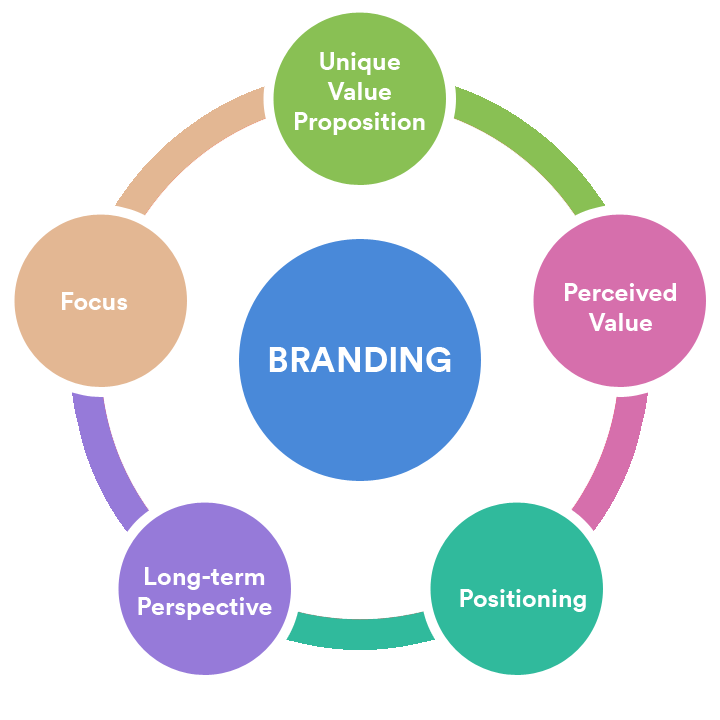 Below are four strategies to effectively help you with your link building campaigns that aim to build your brand.
Below are four strategies to effectively help you with your link building campaigns that aim to build your brand.
1. Invest In Big Content Assets
Publishing content assets that are big enough to cut through the noise requires both resources and creativity. If you don't have the former requirement, double down on the latter - creativity.
Start by identifying topics that are frequently searched by people in your industry.
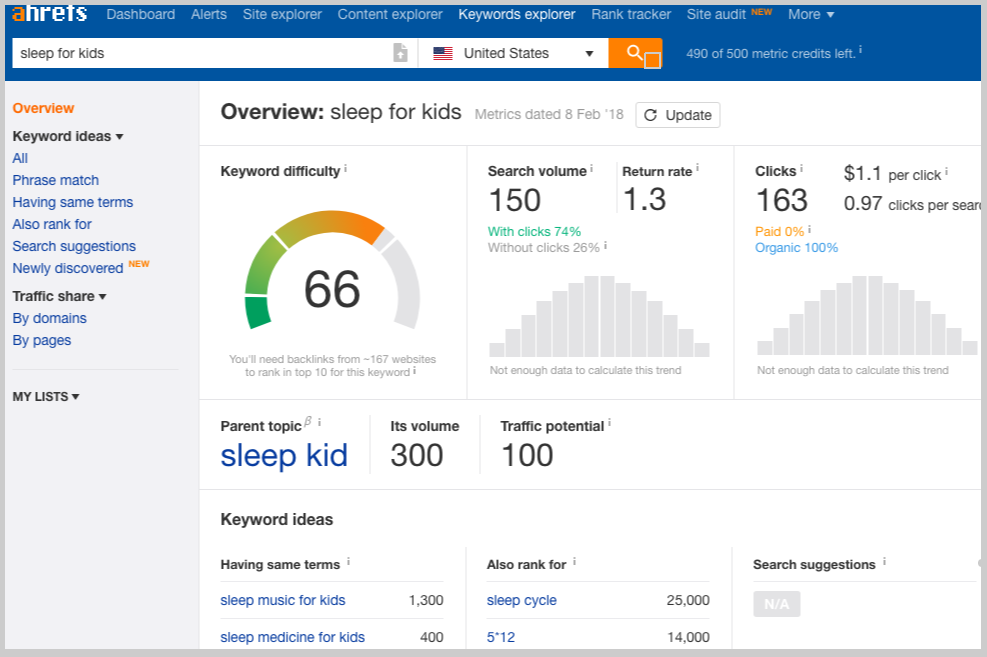
Ensure that there's a substantial amount of pages linking to the pages ranking in your target keyword. This guarantees that there's an audience of publishers that might possibly link to your content asset when you reach out to them.
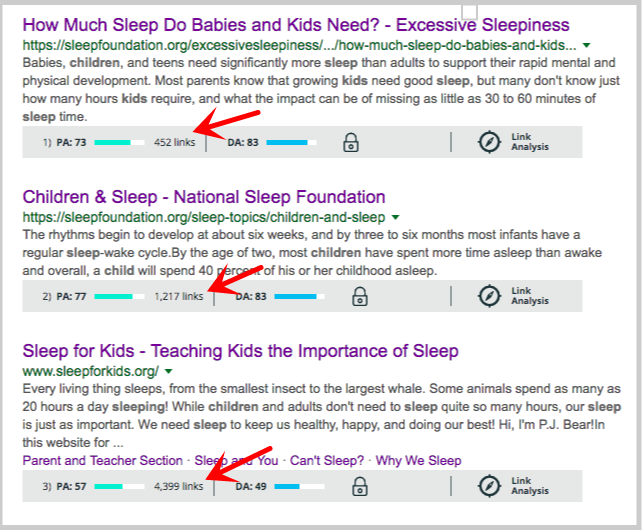
Pro-tip: Observe niche websites that are focused on a particular topic and are targeted to a specific audience.
For example, this website is particularly centered on providing information to parents and teachers on the importance of sleep for kids and how to get them to sleep better
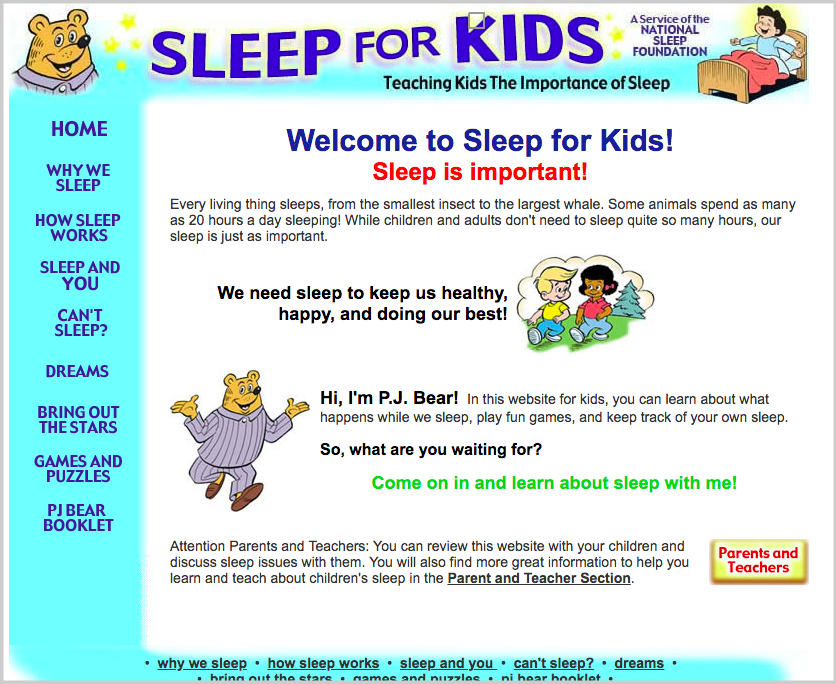
A couple of pages have been published on the site as well that may seem to be better to consume if they are on a single page (on a big content piece).
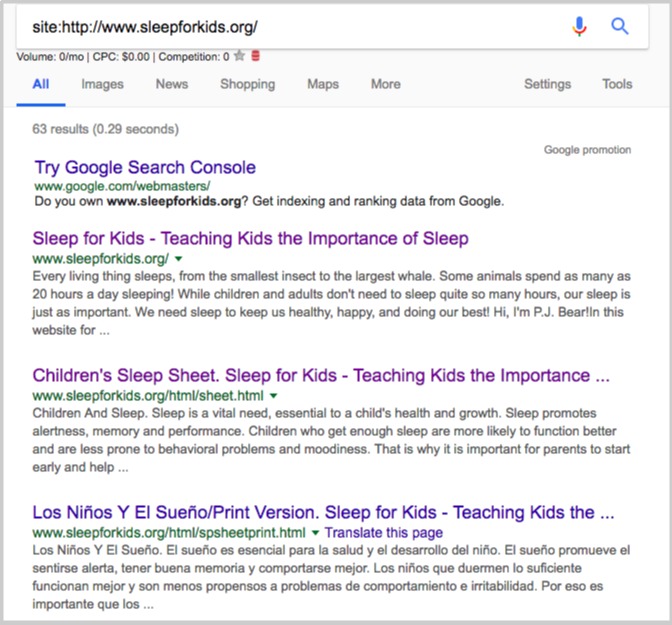
So, we've created comprehensive content on the topic - encompassing all big points covered on the website as well as topics we may have to incorporate that are not included yet in the original source.
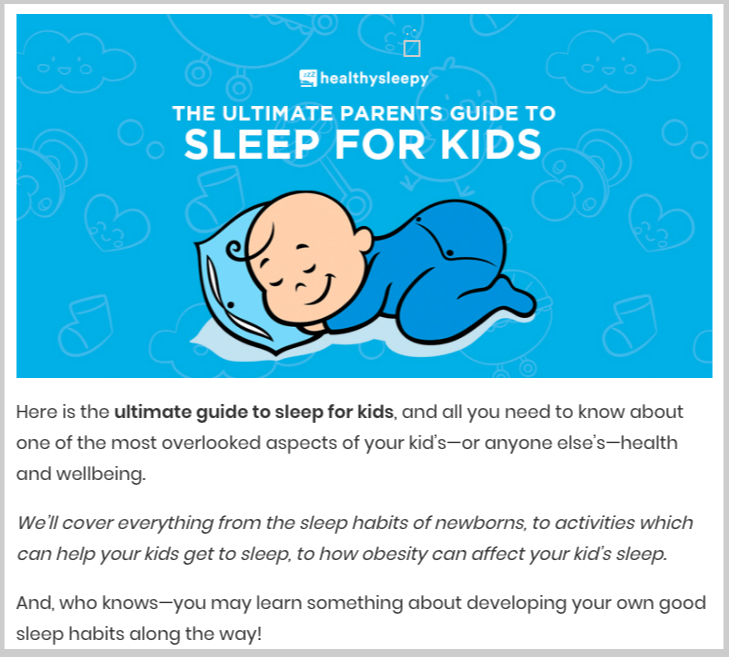
It's also important to identify how to position your content asset as a differentiator in your industry by including content types your competitors haven't built yet.
For example, the sleep sheet page I've found can be best turned into an infographic - making it easily consumable by the audience.
We've created one for that.
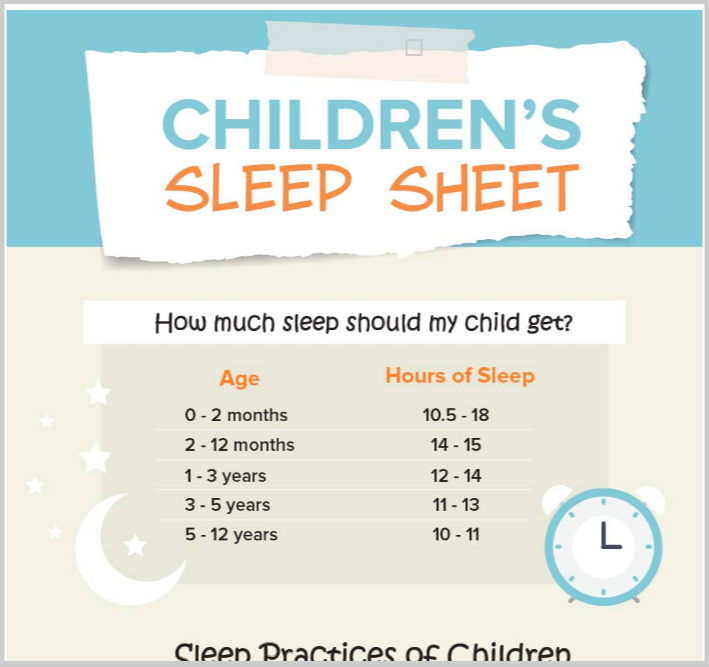
And we gave credit to where it is due.
Add table:
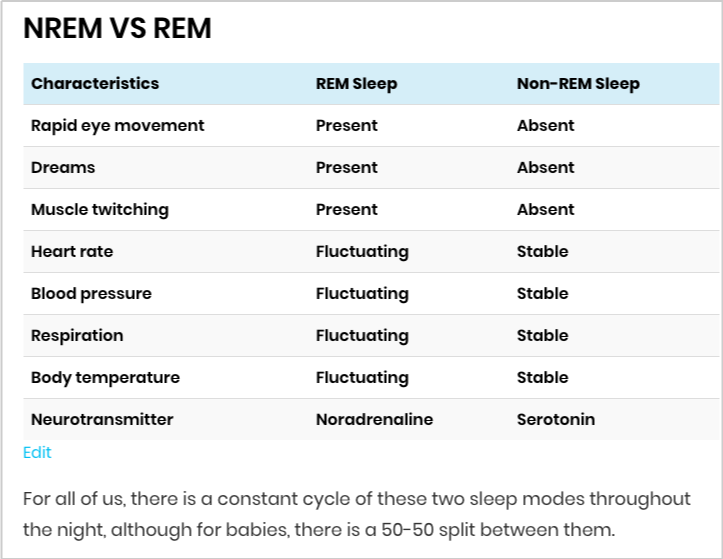
Embed videos:
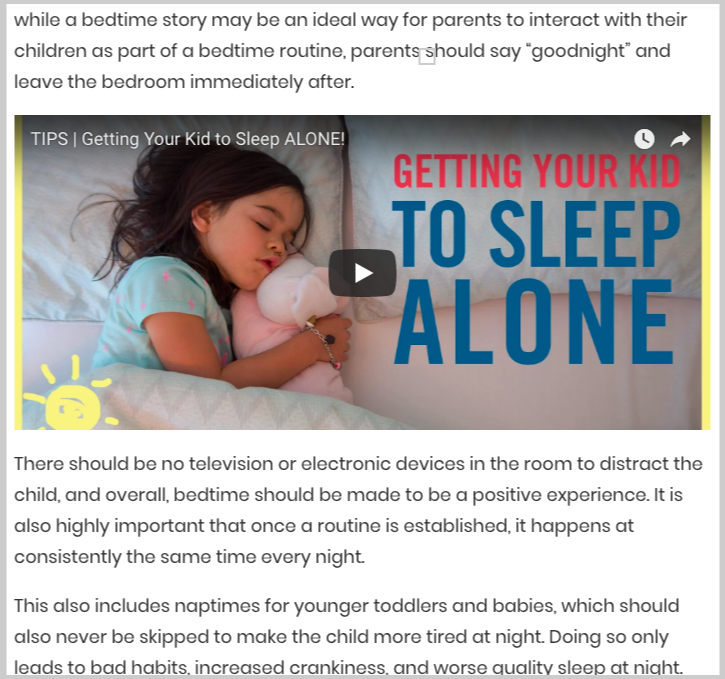
Always remember in creating big content assets:
Treat your content as a product.
Like a product, before your content asset goes out to the world, you tested it for quality assurance. You may want to check out this content quality checklist from Siegemedia to guide you with the post-content creation phase.
Start reaching out to websites linking to the niche website and get high-quality contextual links:


Other Useful Resource:
10X Content Ideation and Creation Process
2. Be Missional In Your Outreach
In their latest content trends study, Buzzsumo shows that majority of content published online gets zero backlinks and no social shares.
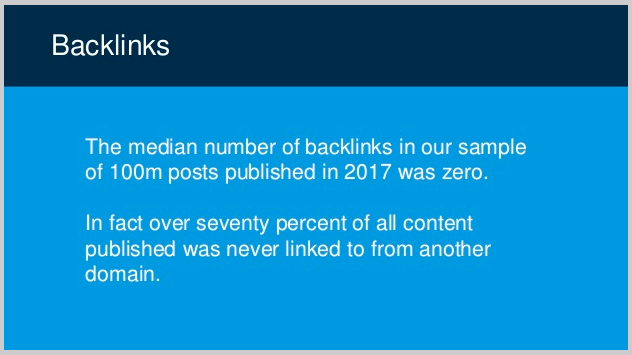
That's a harsh reality, but it's true.
It's easy to create content. But the hardest part is acquiring links and social shares to it.
Just like a product, the market decides if your content is good enough or not.
To break that content promotion anxiety, one has to come up with an effective approach.
Years ago, I stumbled upon the idea of mission-based marketing at CitationLabs. It speaks about identifying a mission in content creation and outreach.
Primarily, a mission can impact your content marketing campaign in so many ways:
- It creates a genuine purpose.
- It enables buy-in from influencers and experts in a meaningful way.
- It justifies sudden existence in someone's inbox.
When that happens, it's easier to execute parts of your outreach campaign, such as:
- Identifying potential linkers to your content (linkeratis)
- Crafting email templates that get an above-average email open rate
- Engaging publishers/webmasters/link-curators that reciprocate your actions in the end.
Let's dive in a little bit and see how the mission plays a vital role in each one above.
Identify Potential Linkers
There is no actual mission if there is no target people to whom a special purpose is catered.
With my earlier example, our main target audience is parents who're having a hard time getting their kids' sleep. We could target both parents and teachers (on how to teach the importance of sleep), which of course could expand our reach - more link opportunities!) but that would deviate from our focus mission from the very start.
By having a clear target audience, we were able to populate our initial list of link opportunities by reverse engineering similar content assets.
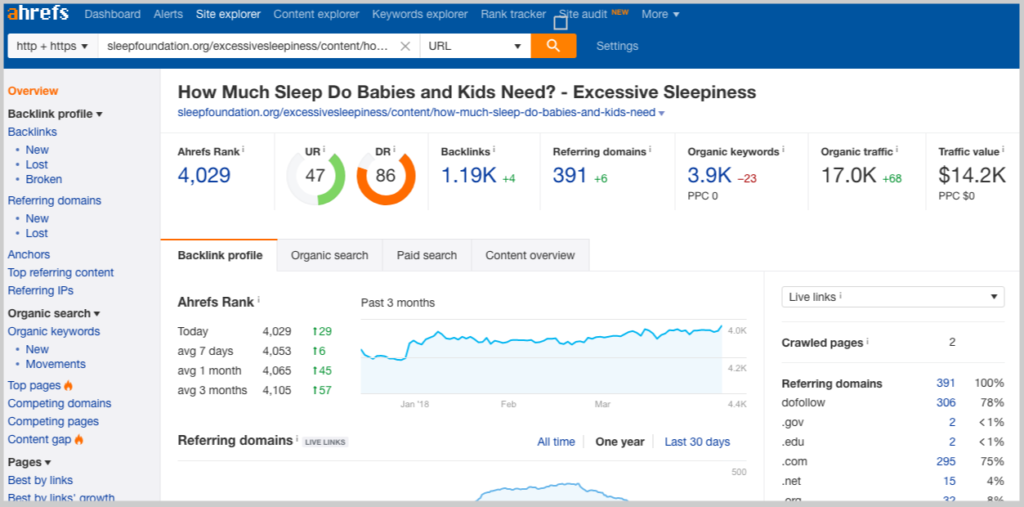
Searching deeper, we've found out pages linking to those who've linked to competitors' assets.
Crafting Email Templates
By putting mission upfront in your outreach, it brings excitement and passion in crafting your email messages given that you're thinking of how to get buy-in from outreach prospects to your purpose.
Clearly define ways on how other people (webmasters, link curators, bloggers, publishers), can contribute to the cause on your initial pitch. Your subject line and the first sentence of the email should encourage collaboration.
Through this, they (publishers) can help you in so many ways, such as:
- Providing suggestions and feedback to your content asset
- Connecting you with any of the influencers/experts within their organizations
- Sharing your content piece through other channels (social media, email, etc..) that are aside from linking to your page
- Contributing data insights that can improve your existing content piece (e.g. calendar, graph, directory, list)
Getting your outreach prospects to buy into your mission is one of the best ways to naturally attract links to your website.
Engaging Outreach Prospects
Bringing value upfront differentiates you from the pack of people sending off link requests all the time.
For example, if you practice broken link building, when you elicit responses from webmasters after you've told about their link errors on their resource pages, you immediately suggest pages (including yours) as replacements to their defunct links.
One approach we've found to be highly effective in helping webmasters fix their links is to look for the best replacements for each broken link.
There are three things that we normally suggest to them as replacements.
A. New page (redirected page)
By using the advanced search operator "site:domain", we look for the new page where the old information is now placed - which is published on the same website.
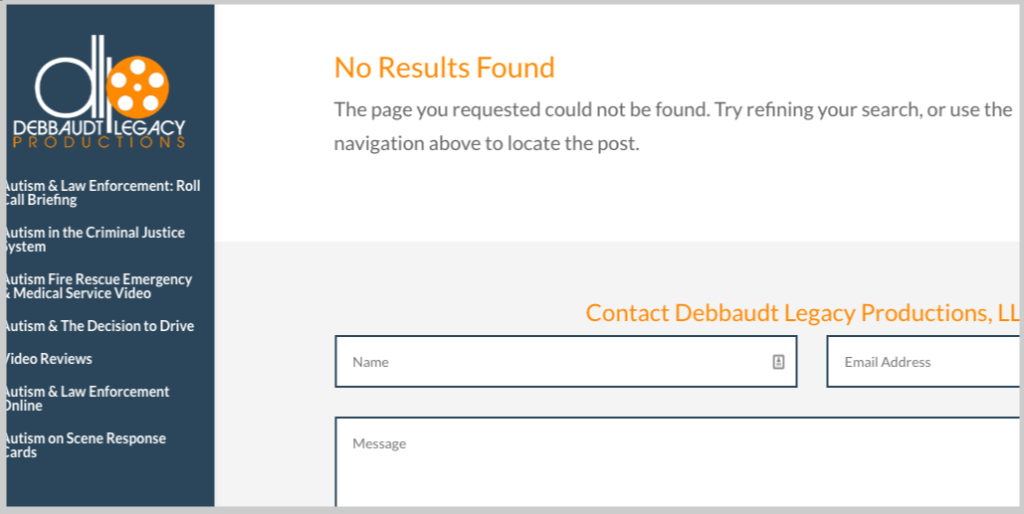
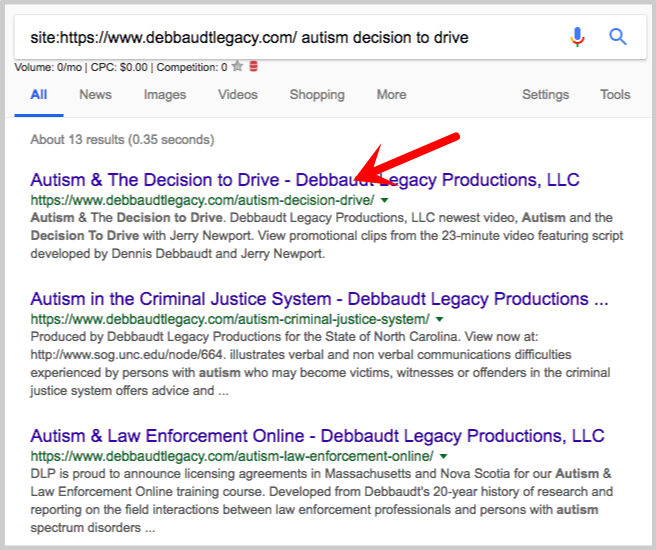
In some cases, the new page is a redirected new website where the webmaster has transferred all details of the original information.
B. Homepage
If the old information isn't published anywhere on the website (i.e. a new page) or it couldn't be seen on other sites (or new website), the next best replacement is their homepage.

C. Remove the link
There are broken links that are non-evergreen (i.e. news, article, pdf), of which the homepage is not a good replacement - the best suggestion to the webmaster is to actually remove the link.
For a more detailed guide on how to find the best replacements for broken links, you can check out my older post on broken link replacements.
3. Collaborate With Influencers For Guest Publishing
Relationships are vital in acquiring high-value links from top industry publications.
It would be easier for your pitch to stand out amongst hundreds (if not thousands) of guest contributor emails bloggers are receiving daily in their inbox if they are aware of your brand (you) and the kind of value you can contribute to their website's audience and followers (through your content).
Easier said than done, but bloggers who're still starting to build their own brand may not have the popularity and authority needed to generate interest from target publishers.
One approach that you can use to capture the attention of your prospect publishers is to associate yourself with influencers or experts in your field.
The process can begin by Identifying influencers whom you can help out by getting them more exposure on bigger sites/brands.
You can start with popular bloggers who host interviews on their blogs (use Google search - ex. "interview series" + "industry" or "podcast" + "industry").
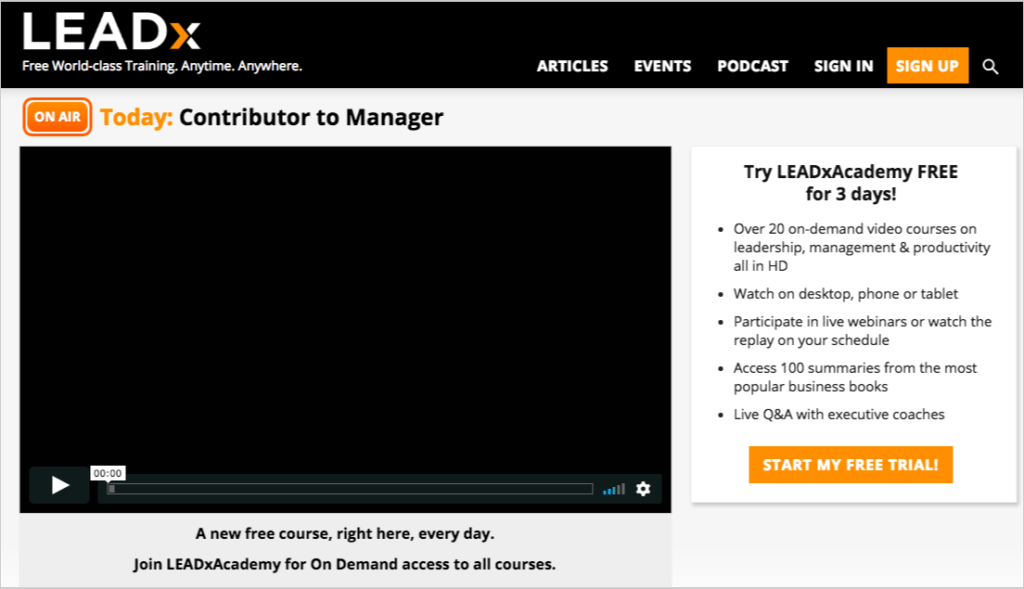
Check the list of experts being interviewed on the hosted website. Pick those who have their own blogs given that high-value links to their websites will be the main value proposition of your pitch to them (more on this later).
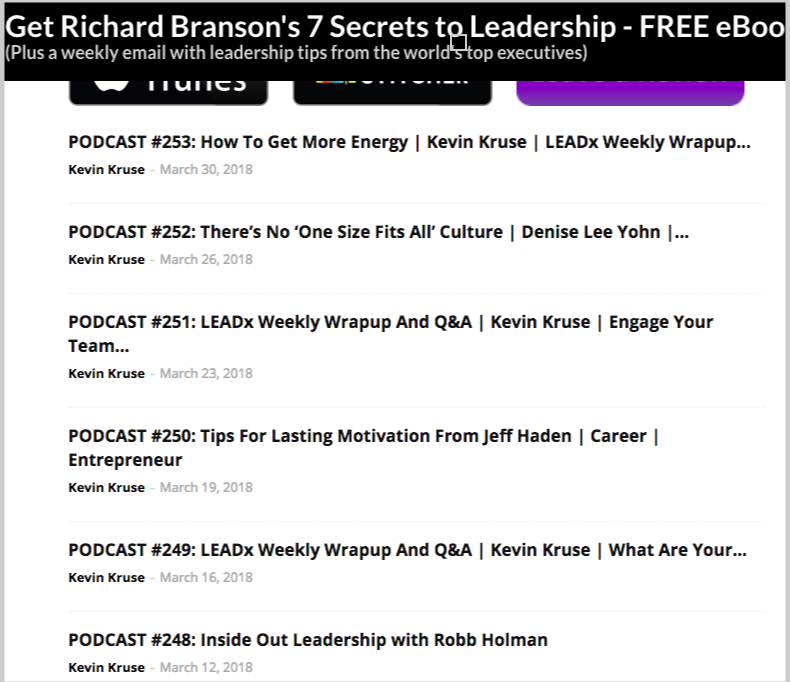
From there, you can find and collect their email address. List them all in a spreadsheet to have an easier process once you start reaching out to them.
The second part of this process is to pitch industry publications with content topics that haven't been covered yet on their blogs.

What you should be offering for them is content that can rank on keywords that they haven't ranked yet and that includes high-value information based on your expert's (interviewee's) answers to your niche-specific questions.

The only answer you'll expect from your initial pitch is their chosen topics for your guest content.

The next part of the method is to reach out to influencers or personalities (from the first part of the process) and try to do an interview with them.

Come up with questions that are related to the chosen topic of your target publication so it'll be easily integrated into the draft piece you'll be creating (given your guest content is also about the chosen topic).
Once you've received their answers to your questionnaire, you'll then create highly informative content that you can use as a guest entry for your prospect publication sites.
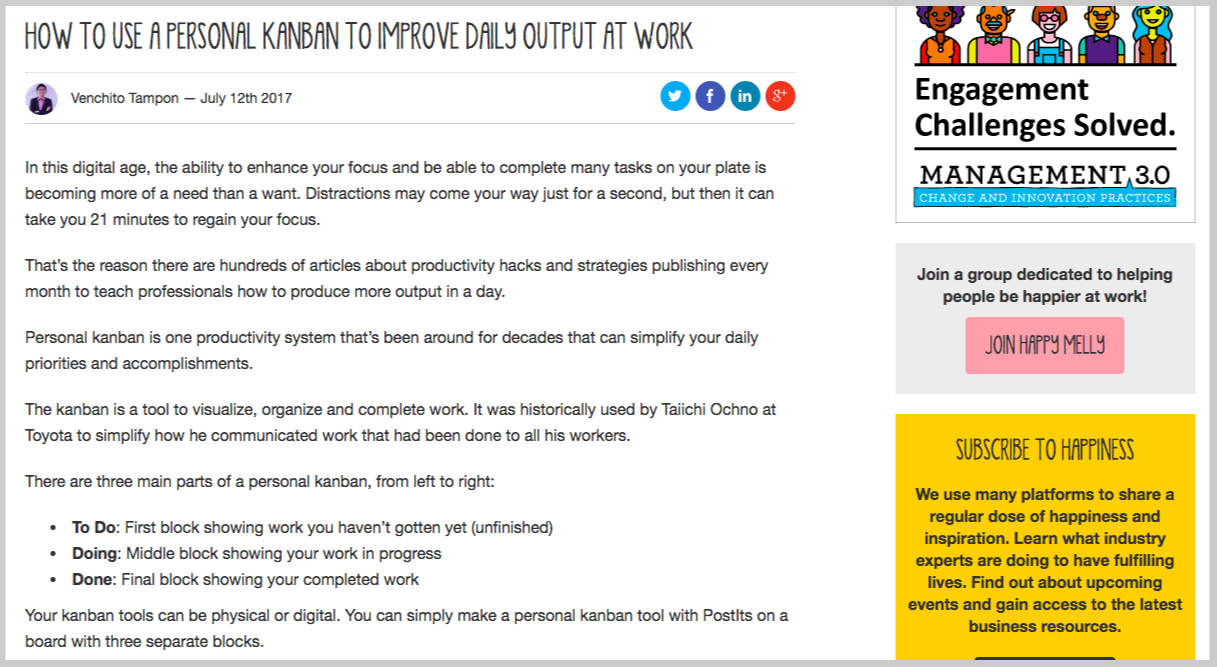

The great thing about this approach is that it's very easy to generate this type of content and definitely a win/win situation for all parties: the blog hosting the content will publish content that includes experts' insights (and potentially can rank for informative keywords), the interviewee (expert) acquires a quality for his/her blog (and gets more exposure) and you, as the contributor, build a brand presence and authority on other blogs (which can translate to additional traffic and more potentially linking opportunities).
4. Have A Long-Term Perspective
When doing link acquisition, it's imperative that you think long-term. You avoid shady link building tactics that lead to short-term behaviors and benefits.
Instead, you target the right types of links that will have a lasting impact on your website.
By providing useful content (industry guides, cheatsheets, data infographics) that gets visibility over time through its ability to rank for secondary/primary keywords, you increase the possibility of attracting links even without doing manual outreach.
Ross Hudgens shared their repeatable blog promotion strategy at SiegeMedia that allows them to increase their client's monthly visitors by hundreds of thousands (month over month).
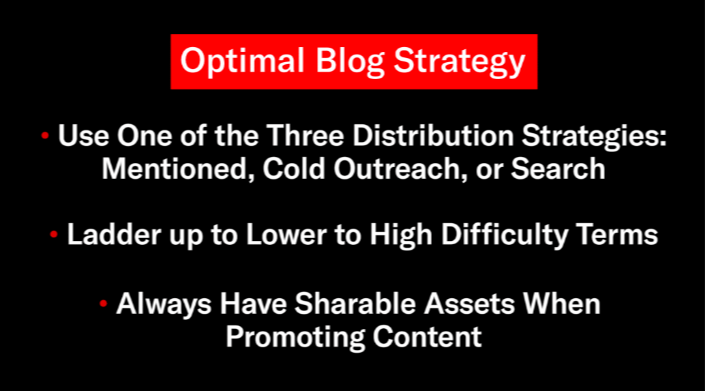
By targeting keywords where your website has the ability to rank (by creating comprehensive content and manually building links to it), you'll soon be able to level up to more difficult topics/keywords.
Repeatedly doing so can slowly build your brand as an authority publisher of useful information in your industry.
For further reading, you can check out these two guides on building authority links and content writing tips.
How to Find Any Email Address: Seeking Email Superheroes
Link building is not complete without emails. In order for us to build relationships with other bloggers, we must have a venue to connect with them.
And one best thing to bring together bloggers is through email outreach. It is when you contact the bloggers you have prospected to gain exposure for you or your client’s products and services.
But before you proceed to outreach, you first need to look for the email of the person you are trying to connect to. The more specific it is, the better.
How To Find Email Addresses?
1. Check the contact page.
This is where they’ll most likely be adding all ways to connect with them, like their social media pages, contact form, or email address.
Do note that contact forms are not always advisable because it has a lower chance of response rate than when you reach out directly using an email of a specific person.
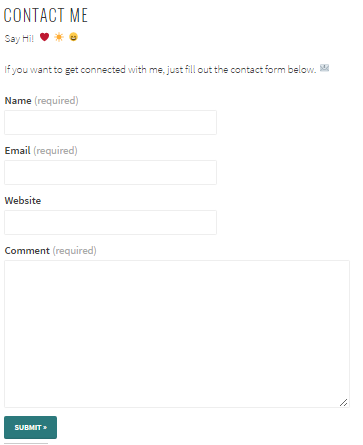
2. See about page.
Many website owners take their emails as part of their identity. That is why we can sometimes see emails on the about page. Some like their contacts put on a different page especially if they use contact forms.
Others prefer it to be included in their about page.
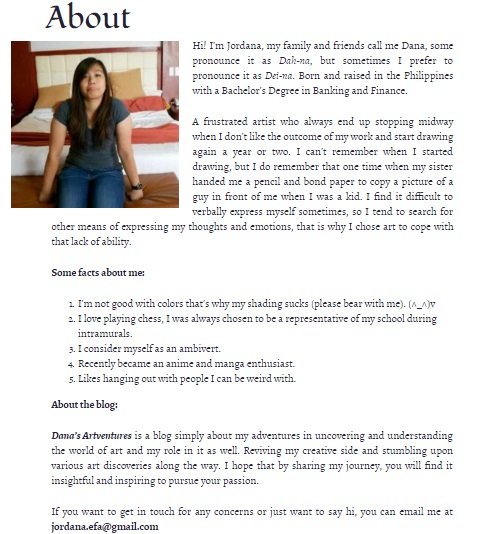
3. Visit privacy policy.
All the boring legal stuff aside, some bloggers include their email addresses on their privacy policy page for readers or other people who wish to email them regarding their queries about the security of their personally identifiable information given to the website.
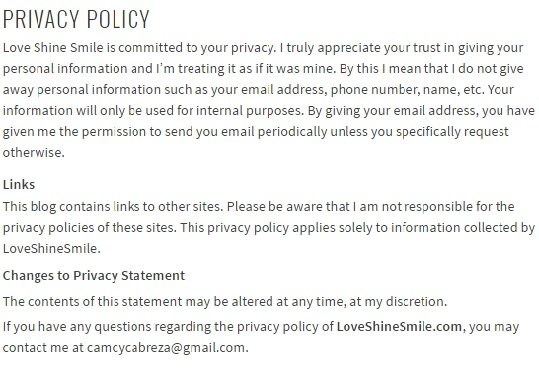
4. See disclaimer or disclosure page.
You can also try to look in their disclaimer or disclosure page where they state that the information readers have seen in this blog are meant to be taken as an opinion to avoid lawsuits or that they receive compensation from companies they advertise.
There are instances where they add their personal email for it to be easily seen for people who wish to reach them regarding their queries.
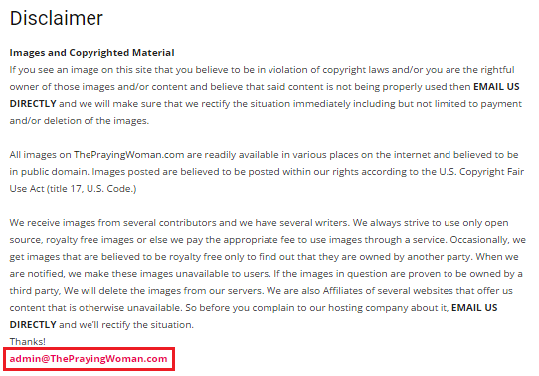
5. Go to social media pages.
Just check the social media accounts of the blogger and click on the about page. Voila! You will then find the email address you are looking for.
A. Facebook
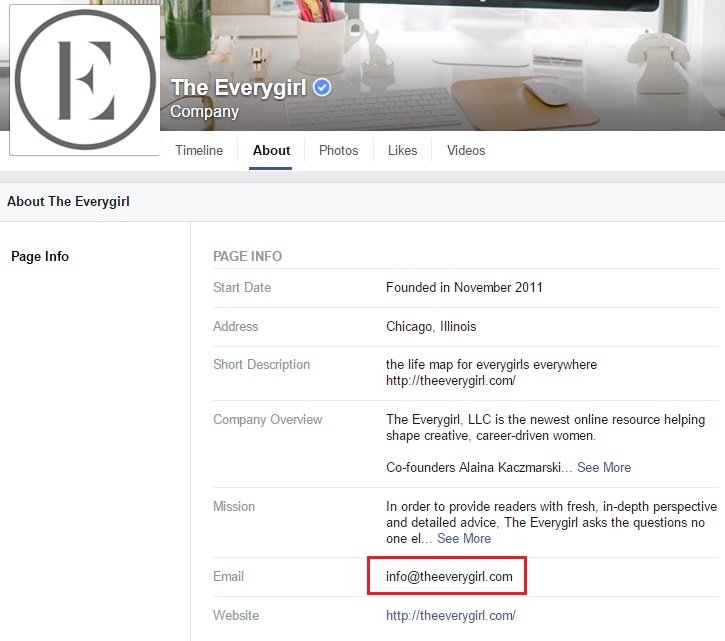
B. Google+
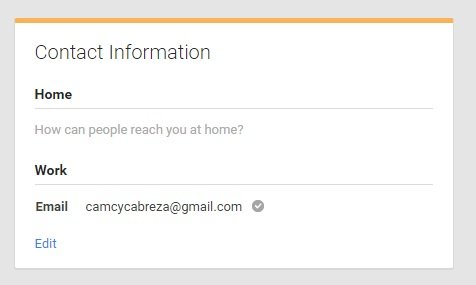
C. Twitter
All My Tweets is a handy tool you can use on Twitter to find all the tweets an individual has made. You can even opt to hide replies and retweets.
You just have to sign in with your Twitter account and you’re good to go! With this, you can also try to look for your prospect’s email because at some point there is a great chance that he tweeted something with their email address on it.
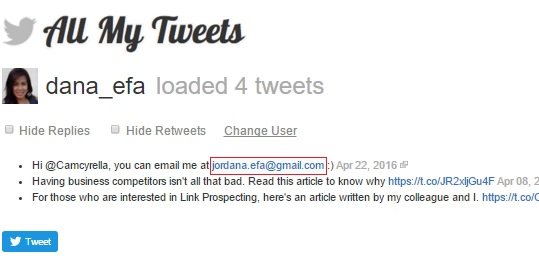
Here are the steps to start using this tool:
- Go to https://www.allmytweets.net/connect/ and sign in with your Twitter account.
- Type in the Twitter account of the person you are trying to search.
- A result of all his tweets will be shown. You can then use CTRL + F or COMMAND + F (if you’re using a Mac Laptop) to search for the word “email” faster than going through all his tweets one by one.
- Just skim through the tweets that mentioned “email” and if you’re lucky, you will find an email that your prospect tweeted.
6. Utilize Google Search Queries.
Google can be quite dandy in doing detective work for you. We can play around with Google search by combining search operators and add-ons to get a more specific result. Let me cite some examples:
name + “email” OR “contact”
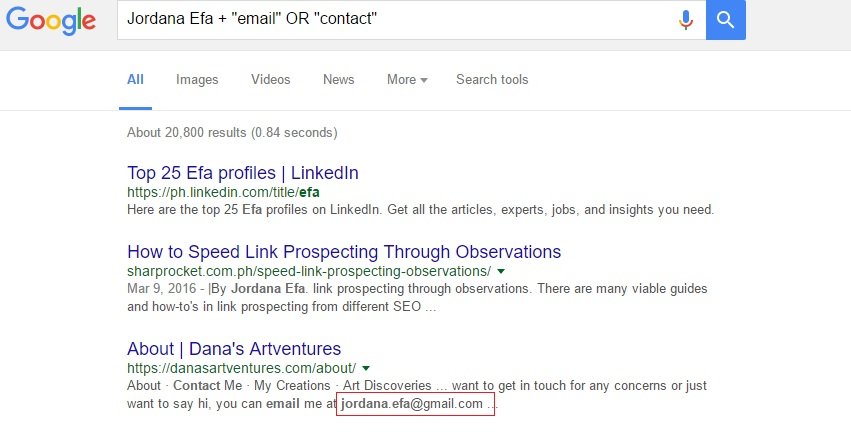
site:[domain.suffix] + “email” OR “contact”
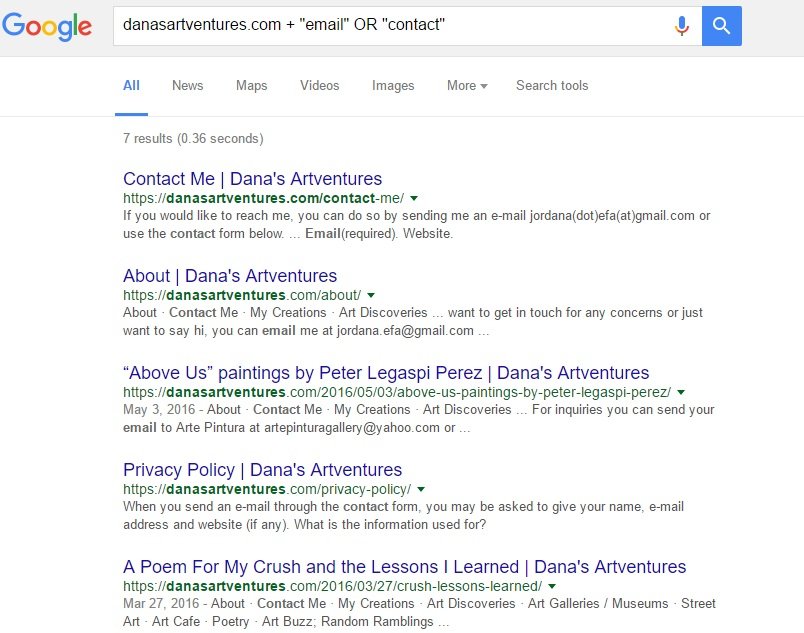
domain.suffix + name + email
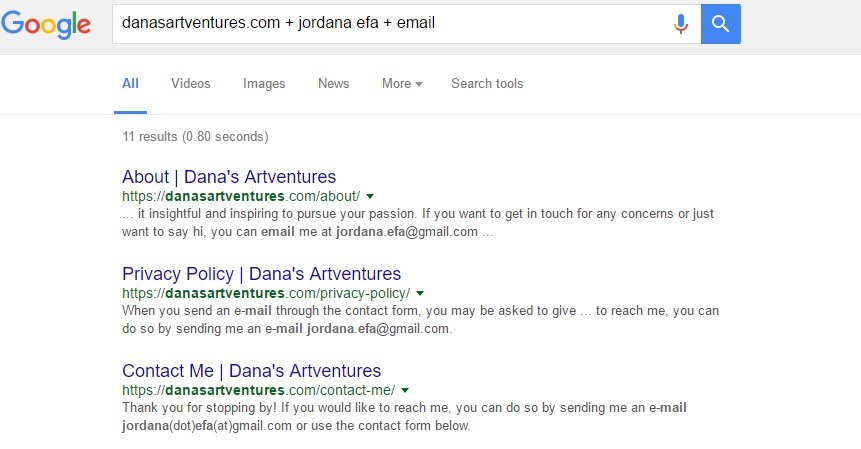
domain.suffix + name[at]domain.suffix

7. Use Hunter
If you want to save time and find email addresses in seconds, Email Hunter is a magnificent link building tool to instantly find email addresses within the website itself just by clicking on its icon Google extension.
There is a catch though.
Request for email through this tool is only up to 150 each month unless you upgrade to their premium account.
If you want to use this tool, all you have to do is to create a free account then download its Google Chrome extension.
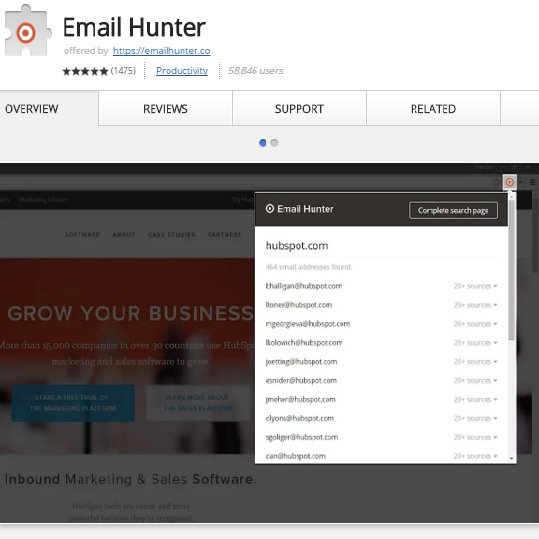
Though Email Hunter is convenient to find email addresses FAST, it becomes irrelevant when some bloggers tend to be more creative in publishing their contact information.
Some bloggers may publish their email addresses in image format.
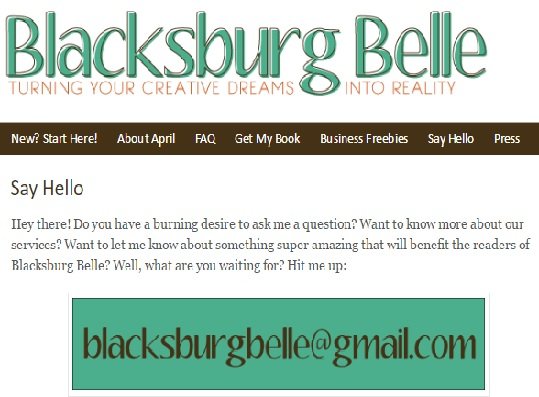
Some may try to emphasize the @ and change it to [at] or the period and replace it with [dot].
![email with [at] or [dot]](https://sharprocket.com.ph/wp-content/uploads/2016/05/email-with-at-or-dot.jpg)
Note: Unless the correct email format is hyperlinked on these creative formatting, the blogger’s email address will remain hidden from Email Hunter.
8. Try Clearbit

Clearbit is another great tool to look for emails of a specific domain.
First, you have to install the chrome extension. Using your Gmail account, click “Connect”.

Type in the name of the company or domain you are looking for then press Enter.
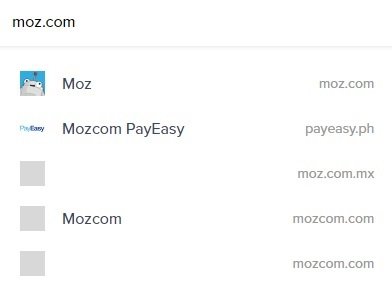
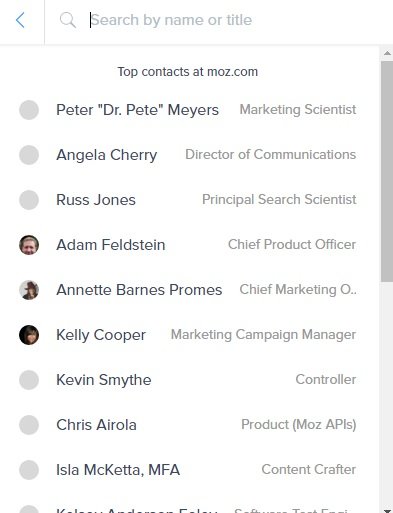
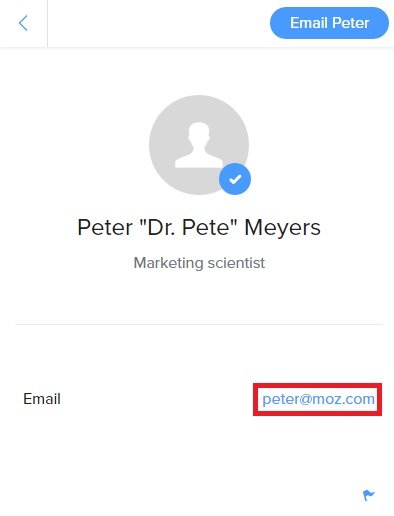
Note: Not all domains you will key in will give you results. However, there’s no harm in trying.
9. Try FindThat.Email
This tool is very handy for those who are looking for the email addresses of company owners/staff.
Head over to findthat.email.
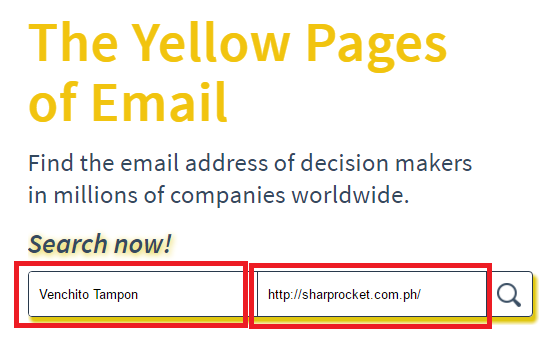
Type in the full name of the person.
Copy and paste the domain of the website.
Click the search button.

10. Try ContactOut
ContactOut is a powerful tool for finding and connecting with the right people quickly.
Renowned for its accuracy, ContactOut helps you uncover both professional and personal email addresses, as well as phone numbers from a vast database.
The browser extension integrates seamlessly with LinkedIn and any website, allowing you to extract contact information without leaving the page.
Using ContactOut is simple: install the Chrome extension, navigate to a LinkedIn profile or website, click the ContactOut icon, and view the contact info in a sidebar.
This makes it perfect for link building, as you can easily find and reach out to the right contacts.
ContactOut also offers CRM integrations and team collaboration features, enhancing your outreach efficiency.
With ContactOut, you have the confidence that you’re reaching out to the right people, in the right way, every time.
How To Verify Email Address?
Why validate emails you say? There are cases where the email addresses that bloggers provide are no longer valid or are inactive. Through email verification, you can then authenticate that the email address to which you are going to send your message is a valid email. You, therefore, minimize failed messages and improve your email deliverability and the chances of it being seen.
1. Utilize Rapportive
Rapportive is also a Google Chrome extension that gives you results of everything you need to know about the person you are trying to contact pulled from their LinkedIn information.
You can try to use this to validate an email to know if it exists.
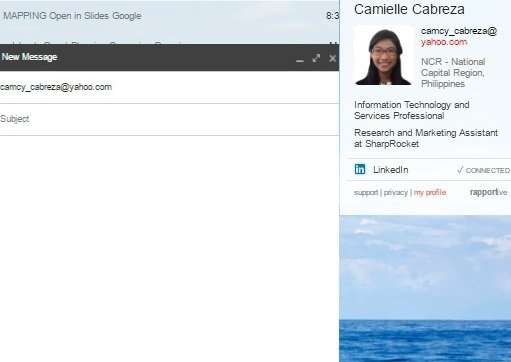
To use this plugin:
- First, you have to download Rapportive.
- Compose an email using your Gmail account.
- Key in the email address you found or the potential combination of email addresses using the blogger's name and domain name until a photo appears along with your prospect’s LinkedIn information.
Note: You have to sign in with your own Gmail and LinkedIn account to be able to use this plugin.
2. Use VerifyEmailAddress.org
What if they don’t have a LinkedIn account connected to their email? That’s not a problem! VerifyEmailAddress.org is another way to verify the email address of an individual, even without the connection of social media profiles to their emails.
What you have to do is simply go to verifyemailaddress.org and key in the potential email address you have created in mind to see if it is valid.

Meeting Bruce Wayne Not Batman: Getting Personal
You wouldn’t say you know Batman if you didn’t see him behind his mask. In searching for emails, it is very important to catch the more specific email rather than the generic ones. Most bloggers use their name or initials plus their blog or domain name.
Just be experimental in combining the blogger’s name, domain name, and punctuation marks such as dot or underscore. The key to finding valid emails easily is by searching in obvious places first and verifying them through third-party tools. This will be a great help especially in checking bulk email addresses.
Have We Been Helpful?
Want to take your link building to the next level – — but don’t know where to start, and are feeling overwhelmed by this post.
We are here to help you. SharpRocket is a team of link building specialists who love building high-quality links.
To learn more about how we can help, take a look at the link building services we offer and results we got for our clients.
How to Use VoilaNorbert For Linker Outreach
Outreach is a critical part of any link building campaigns given that this is where you have to ensure your prospects are pitched carefully with extreme value for them.
With so many tools to aid your outreach process, it's so hard to identify which ones actually help you move the needle in every initiative of the campaign.
There is one web product that's been available in the market to help you with finding someone's email addresses, email verification, and scheduling email pitches.
It's VoilaNorbert.
What Is VoilaNorbert?
VoilaNorbert is a lead intelligence software that allows you to find new email addresses of people you are trying to pitch, verify the validity of those emails, and/or schedule emails at your preferred date and time.
Features, Details, and Pricing
Unlike other outreach tools that have tens of features, VoilaNorbert focuses on three core uses.
The first is finding leads.
Find email addresses
VoilaNorbert helps you discover and collect the corporate emails of decision-makers of businesses you're trying to get in touch with. It also helps you find the email addresses of publishers, bloggers, or any content creator you are looking to pitch for content publishing.
Finding email addresses can be done manually. Go for each target website or page, skim through it, and keen an eye on a section that tells you the right contact person and email address to contact. Copy and paste it to your spreadsheet and you're done.
That is the most basic way of doing it.
However, doing it on a scale of hundreds and thousands of prospects will consume so much time you could otherwise spend on crafting an email copy that gets their interests.
Furthermore, if you're working on a scalable link building strategy, i.e. guest blogging and broken link building, it's vital to find a tool that will get things done very quickly — as in the case of collecting important contact details of outreach prospects.
Verify emails
Did your emails fail to receive responses from your link targets?
It's probably not because your email pitch is crap, but that the email address isn't valid anymore -
VoilaNorbert gives you the ability to validate emails in real-time. By doing so, you can now reach real people and expect replies from them.
There are tools that function just like that — verifying email addresses. But if you're looking for a flexible one that does both two core functions straight from the platform: finding email addresses and verifying them, VoilaNorbert is the best fit for you.
You can have both functionalities without having to leave the platform.
Enrich contacts
Enriching contacts is sending emails to target link prospects with the right message at the right time they'll be more likely to see and read your email message.
It's important to have a good understanding of what makes an email message effective, especially in aiming to get organic links.
One principle you can apply is the A.I.D.A model, which is an acronym for Attention, Interest, Desire, and Action. Make sure you have these elements included in your email pitch — to make it strong enough to entice responses from your link targets.
Here are some resources you may find valuable to improve your email copies:
- Six Small Differences You Can Make to Your Email Outreach
- The Definitive Guide To Link Building Outreach
- Why and How Influencer Outreach Works
How Does VoilaNorbert Work?
Sign up to get your first free 50 leads.
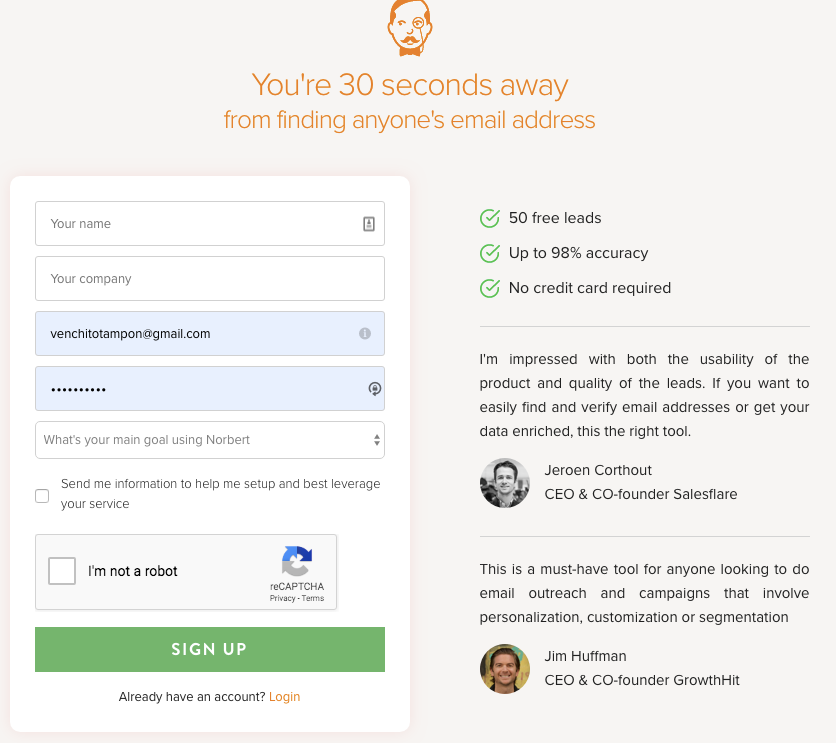
Once you've confirmed your registration, you can now log in to the tool.
You'll then see the features of the tool. Let's talk about each of them.
Prospecting
There are two prospecting methods: manual and bulk.

With manual prospecting, you simply have to enter the name of the contact person and the domain URL of the website. Then click, Go Ahead, Norbert!.

As for bulk prospecting, you have to upload your CSV file with columns for Names and Company Names.
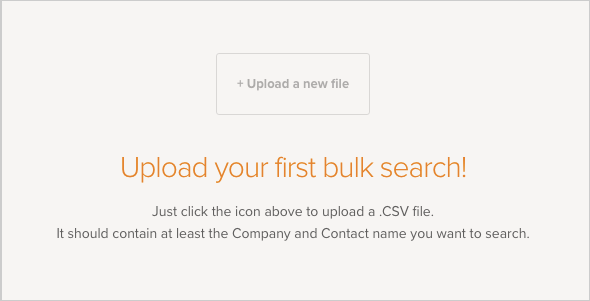
What I liked about VoilaNorbert is that it gives you a sense of the validity of the email by showing you a green color for a high percentage, an orange one for mid, or red for a low percentage of validity.
Furthermore, if you wish to send an email straight from the platform, you can do so by clicking the Mailbox button.

Link builders should look for ways to improve their productivity. In finding email addresses, VoilaNorbert saves you enough time with its Chrome extension tool.
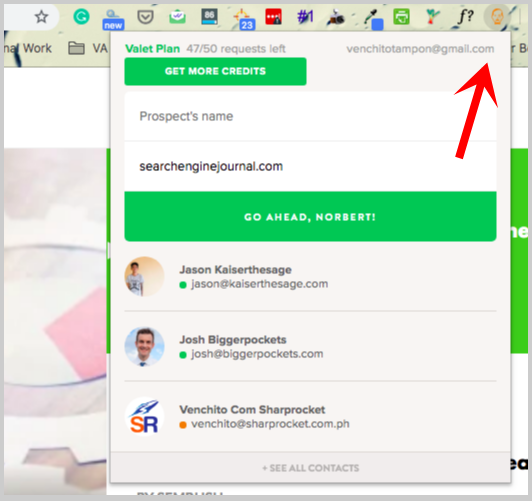
If you're on your target page, simply click the VoilaNorbert tool in your toolbox. You can use it immediately to find the right email address for that page. It's a handy feature that keeps you highly productive in your email-finding process.
You may want to check out this guide on top Gmail extensions you can use for linker outreach, and link building in general.
Validation
To avoid failed messages and ensure you're making the cut through every email pitch you send, it's important to validate email addresses.
Other important reasons to include email validation in your outreach process:
- Reduces time spent pitching invalid email addresses.
- Easily diverts efforts to finding secondary emails, in case the primary email address collected is invalid.
- Clean input in a spreadsheet or on an outreach platform — leading to a more organized outreach workflow
With VoilaNorbert, you can verify emails based on the number of emails you need. This is a good feature that differentiates it from its tool competitors — as it saves so much money if you're into a small outreach campaign.
There are three ways to validate your emails:
- Upload a CSV file
- Copy and paste email addresses from a spreadsheet
- Use connected integrations from other sites/tools (i.e. Mailchimp, Hubspots, or Mailshake).
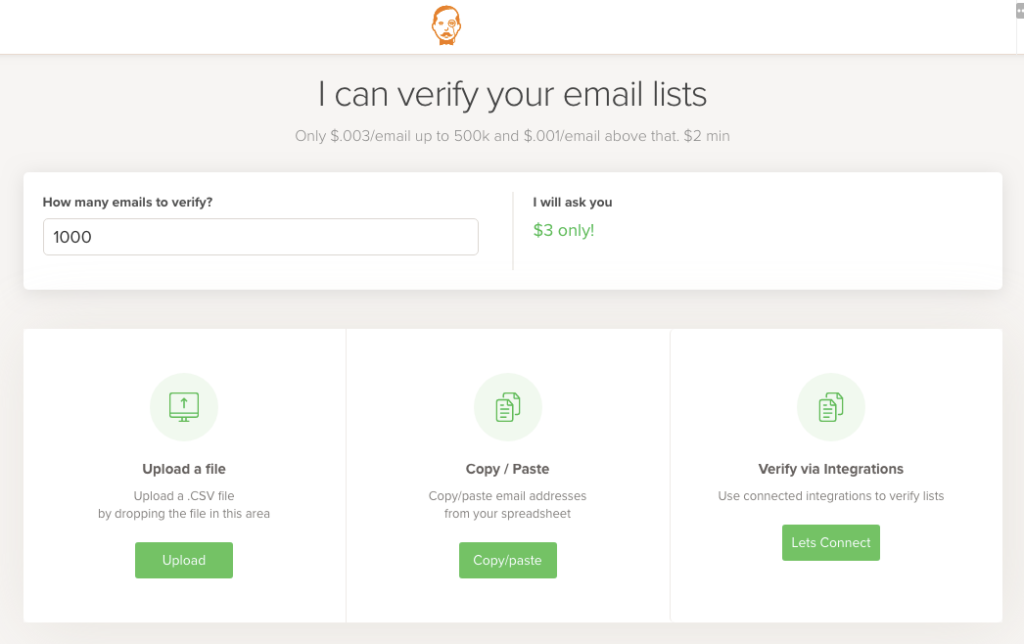
One important note here is that there are emails that will be marked as "Risky" when you start verifying emails. These "risky-marked" emails simply mean that there's a high chance of bounce for that email address.
VoilaNorbert verifies the connection to the mail server owning the email address. If it's not established properly, it is marked with red color and/or risky. The tool has proper functionalities to ensure proper accuracy of email validation — giving you confidence in the results.
Enrichment
In crafting email copies for link building outreach, it's important to include details that matter to your recipient. You can do that by having an overview of their interests.
It's easy to check a Twitter profile, get a sense of what the prospect is up to, his or her location, and what can make you engaged with him/her in your email pitch.
The thing is, if you're doing it on scale finding each and every social account of prospects, it may not be a good investment for your time.
VoilaNorbert helps you with this matter. It can fetch the current job title, employer, location, and even social networks of the person behind the email you're verifying.
This quick feature gives you the ability to know more about your link prospects and not just spam them with another generic pitch.
Best Alternatives to VoilaNorbert
I highly recommend that you use VoilaNorbert in doing outreach tasks efficiently (finding email addresses, email verification, and initial email pitching).
In case, you're not satisfied with its features, here are two alternatives that you can try out:
Hunter
Our link building team is heavily using Hunter as part of one of our email-finding tools. It lets us find email addresses in seconds.
With over 200+ million email addresses indexed, Hunter already has effective search filters and scoring to give you a list of email addresses that you need for the right context.
Clearbit
Clearbit has a deep data engine that's very efficient for lead generation processes. If you're looking for integrations into many platforms, Clearbit's functionality is a good try for you.
Whatever tools you use, whether it's VoilaNorbert, Hunter, or Clearbit, you can leverage them for core outreach initiatives for whatever campaign that is - blogger outreach, influencer outreach, or other types of outreach campaigns.
Finding Email Addresses and Validation At Scale
It doesn’t' hurt to try VoilaNorbert for your linker outreach campaigns. Being able to collect email addresses and validating them in minutes is a huge legwork any link builder aims for.
Validating emails is another micro process that will make a huge difference in how your email outreach results turn out.
Those two processes: finding email addresses and email validation are critical success factors in email outreach.
However, it's important to know which parts of the process need your most precious time and attention. Those are crafting email copies with personalization and value proposition.
Content Marketing Ideas & Strategies For Small Business
Content sits at the core of most discussions by marketers and business owners today.
The reason why content is king is that it ties every area in digital marketing together. This simple image below from Jason Acidre's content marketing at Moz is still relevant up to this date.
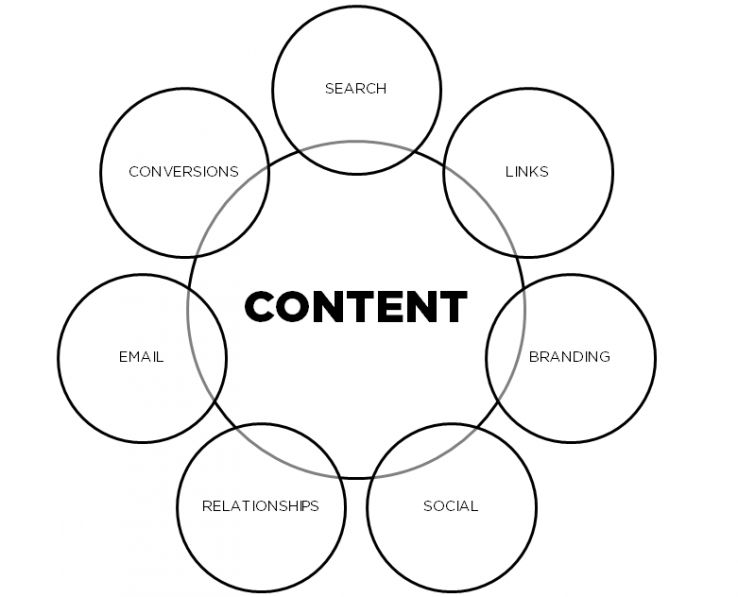
"Does content marketing work for small businesses?" This is a question I received multiple times. And the answer is an astounding yes.
It works for big brands and it works for a small business owned by you.
However, it works more effectively if you are clear about your goals.
You'll receive different responses when people are asked, why are they doing content marketing?
You hear words like, "because it's trending now". Others say, "my business friend does it, I'll invest in it too".
Why Do Small Businesses Need Content Marketing?
Why use content marketing? How can content marketing help a business? What does content mean in business? What does content marketing include?
These are the questions people asked as to why small business owners need content marketing?
In the recent B2B content marketing research by Content Marketing Institute, these are the top three most-cited content marketing goals achieved in the last 12 months — giving us a preview of the main reasons why people need to invest in content marketing:
- Creating brand awareness (86%)
- Educating audience(s) (79%)
- Building credibility/trust (75%
Let's quickly discuss them one by one.
Creating brand awareness
Content is deemed to bring awareness about your brand, regardless of type, industry, and size.
And in this day and age, the competition is in branding. People buy products because they've known it, repeatedly seen on different social places — and therefore, they've made buying decisions based on which products get more branded.
Building awareness through content marketing is a huge thing.
This is where small business owners like you can leverage and can compete over your contemporaries.
You may not have a billion-dollar marketing budget, but if you can purposefully implement a solid content strategy with a good amount of investment and build a strong brand out of it, you'll be better off dominate a good share in your market.
Educating the audience
To educate is the best way to sell
Content marketing takes a long process to get people to move through your business' customer journey. In content, you are not always selling your products and services.
Most of your content assets, whether those that are written-word (like blog posts), videos, audio, and other formats, are designed to inform your audience with topics they'll be interested to consume.

Through content, you show your expertise as a brand. Your potential customers get to trust you as they are helped with the content serving their specific needs.
There is a high return on investment in content marketing. If properly planned and executed, content marketing can be a powerful channel of new leads for your small business.
Building credibility and trust
Word-of-mouth marketing today isn't only acquired through best works of services or products--while that, of course, is a huge advantage for entrepreneurs who are looking to scale their small businesses.
Through content marketing, you can build credibility and trust of your potential customers to your brand.
Word-of-mouth marketing can also happen when they've found your content valuable to be shared and used as a reference for their content works.
See more resources:
Content Marketing Myths Of Small Business Owners
There are certain mindsets small business owners, including the ones who owned a content marketing business, must break to start investing in content marketing and reap its benefits. Here are a few you should watch yourself if you're a small business owner.
"I don't have time for content marketing"
If you're an entrepreneur, you wear many hats to let your business thrive. You are putting out fires in sales, operations, hiring, admin, and finance.
Doing all these things makes you think you don't have time for content marketing.
That may be true, but if you look at the benefits of content marketing to your business (which I've shared earlier), you'll find ways to invest in it.
The best way to start is to do it yourself. Content requires some kind of expertise that outsourced generic writers (low-cost outsourcing) may not afford to do.
You can create one asset for less than an hour (e.g. producing a video and repurpose it into other content formats — to efficiently and instantly generate multiple content pieces for your brand.
"I don't have enough budget for content marketing"
Besides lack of time, another excuse small business owners voice out is their lack of resources, particularly finances to invest in content marketing.
Today, the online web has offered several opportunities to market your brand with small investment using strategies through organic channels.
For example, you can answer 3 to 5 questions on Quora on topics you are interested in (and have the expertise to bring value). This Quora marketing doesn't cost any buck from your end.
So not having enough budget to execute a content marketing campaign can't be used as an excuse today — knowing there are so many opportunities this core channel can bring to your site.
"Content marketing is SEO"
This is where most people get confused: mixing content marketing and SEO.
Here's the truth: content marketing is not SEO, but it is part of it.
Content marketing is tied into your other SEO efforts such as link acquisition, and keyword research. Links are a by-product (and considered as one goal) in starting a content marketing campaign.
Researching and choosing content ideas is tied into content asset creation to target topics (or keyphrases) that have a tendency to rank in search results.
There are many other myths small business owners come up with on a daily basis.
But the thing is you have to be sold enough to the idea of content marketing.
If you're still not convinced, here are some more benefits of starting a content marketing campaign:
- Drive potential customers from organic rankings (when content assets start to rank for their targeted keywords) and from distribution channels (when content assets are promoted).
- Establish a personal brand (besides the company itself) as an expert in your industry.
- Engage with your leads and let them go through a slow process of a customer journey.
Now, let's dive into some content marketing ideas you can start brainstorming with your team, fill in the gap with your competitors' content, and execute as much as possible to reap the benefits listed above.
Content Marketing Ideas for Small Businesses
Execution starts with ideas.
In this section, we are going to answer this question, "how do I market my small business?"
If you're looking for ways to come up with content assets as early as possible, here are some that can get you out there and do the work.
Leverage the GaryVee Content Model
Gary Vaynerchuck, CEO of VaynerMedia has closed the gap between content ideas and their distribution with his content model.
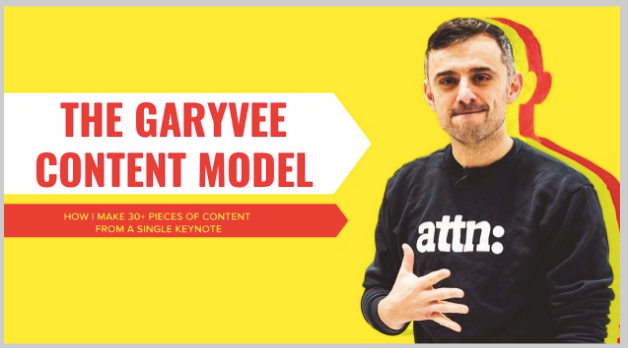
His content model basically follows this process:
- Document pillar content
- Repurpose into micro-content
- Distribute across social media
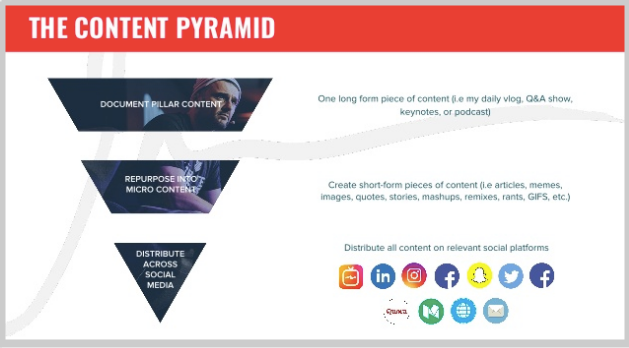
Let's discuss each step.
Document pillar content
What is pillar content?
Pillar content is a long form piece of content that can be chopped into micro content pieces. Examples of pillar content are daily vlogs, Q&A shows, interviews, keynotes or podcast.
If you are not comfortable in documenting your brand videos — with you like the frontier, you may find videos where your brand has been part of (it could be a story of your company from its setup to its growth today).
Discover these long-form pieces in your archives or create one for yourself.
Repurpose into micro-content
From your pillar content, you can create short-form pieces of content. These are video clips from your long-form video, videos transcribed for articles, short clips turned into memes, images, quotes, remixes, GIFs, and other micro content useful for your audience.
Imagine if you have 1 or 2 pillar content and turn them into 30 micro-content pieces each. That's 60 content assets in total that you can distribute both on your internal blog, and to external distribution channels such as Facebook, Twitter, Linkedin, and Youtube.
Distribute across social media
This last phase is the tedious part of the process because you have to ensure you know the context and behavior of each social platform.
Facebook is over-indexed today with videos as well as images with long-form captions.
Instagram is full of high-quality images, quotes, and IGTV comes with minutes of video content.
Every social platform requires different visitor interactions and consumption of content.
Ross Hudgens of SiegeMedia has done this model incredibly for their weekly videos on their content marketing blog. They have Content Conversations series where they interview top-notch SEOs and marketers to talk about the different facets of content marketing, techniques, and link building strategies to better improve the execution of content marketing.
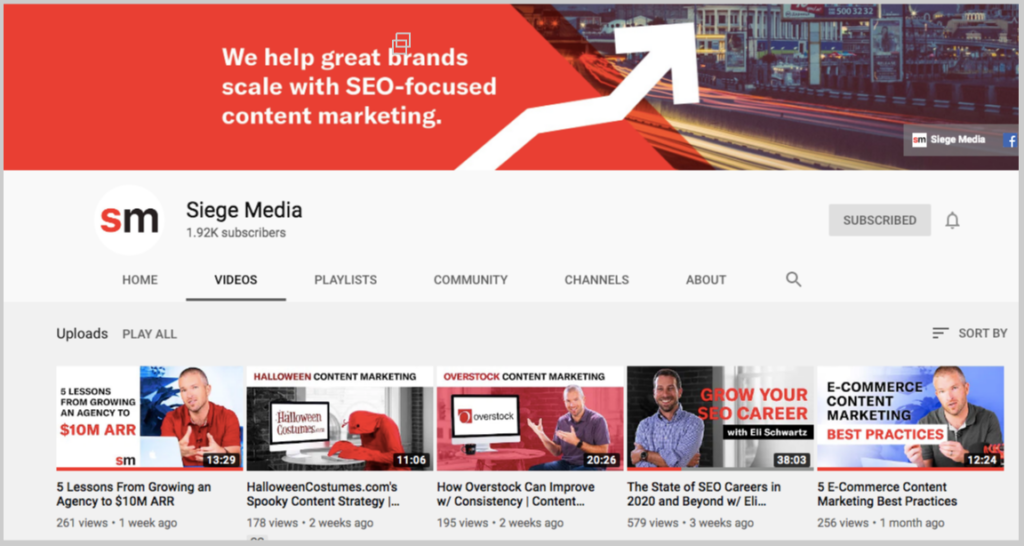
They also have weekly tips where they simply share their insider content strategies for their clients.
This is where your "no time" and "no resource" excuses will be eliminated. As you produce more pillar content pieces, you double it, or multiply the number of pieces you have. This allows you to get a flywheel effect on your content marketing results.
Produce 10x, 5x, and 2x content
The idea of skyscraper content produces a movement of marketers producing long-form content — increasing now the benchmark of word count per content piece.
Even that itself gives a solid motivation for publishers, Brian Dean's skyscraper principle was misunderstood by many publishers, leading them to sacrifice the quality of information over quantity.
The reality is producing 10x content requires both: quantity and quantity.
Not only that, there is a misconception going around that all content pieces should be done 10x. This means that if your content piece is not 4000 or 5000 words in length, your page will not stand out in organic search results.
For small business owners, 10x content creation is not the only pathway to go.
There are information and topics that need 5x, and even just 2x needed to perform better in search engine results pages.
You don't have to write long-form to satisfy users.
Sometimes, you need 2x content, not 10x content. Here's why:
- Consistently producing 2x content pieces multiple times a month can outperform a one-time 10x content asset every month.
- The number of 2x content produced on a blog that targets different topics has a faster impact on the site's overall domain authority.
My recommendation for you as a small business owner is to produce 2x content, 5x content, and 10x content. 10x content isn't only the way to go.
To get the maximum results in the least possible time, you can consistently produce 2x content on a monthly basis.
While doing so, make sure you consider delivering other formats of content to better satisfy your users.
Here are some formats for different learning styles you may consider to add to your content:
- Surveys
- Podcasts
- Video content
- Ebooks
- Case studies (of your customers or other people)
- Checklists, a list of additional references/resources, and tools
![]()
![]() You can't produce all the content types. There are only ones that fit into your strengths — your technical expertise, your resources, your set of writers, and your blog architecture.
You can't produce all the content types. There are only ones that fit into your strengths — your technical expertise, your resources, your set of writers, and your blog architecture.
Identify those aforementioned factors before diving right into content creation.
Use low-cost entry channels for content distribution
Your content marketing campaign will not succeed without any promotion of your brand assets.
If you're a small business owner, you don't want to invest money in content creation without even promoting it to get more results in terms of traffic, shares, links, or referred conversions.
Remove the mindset that in order to distribute content to different channels, you have to pay huge bucks for advertising.
There are, in fact, entry channels where the cost of entry for distribution is low, and even free. It doesn't necessarily require a team of content marketers to promote your content. You can actually do it yourself.
Quora
Every industry has questions to answer. This is where your expertise can play with.
Use Quora to market your content assets. And I don't mean you insert links inappropriately.
What you need to do is to find any discussion pages that need more attention to answers.
Prioritize the ones that are already ranking on search engine results. Given that those are pages that get recurring visitors from search.
Use SEMRush or Ahrefs to find what pages Quora is already dominating on search results.
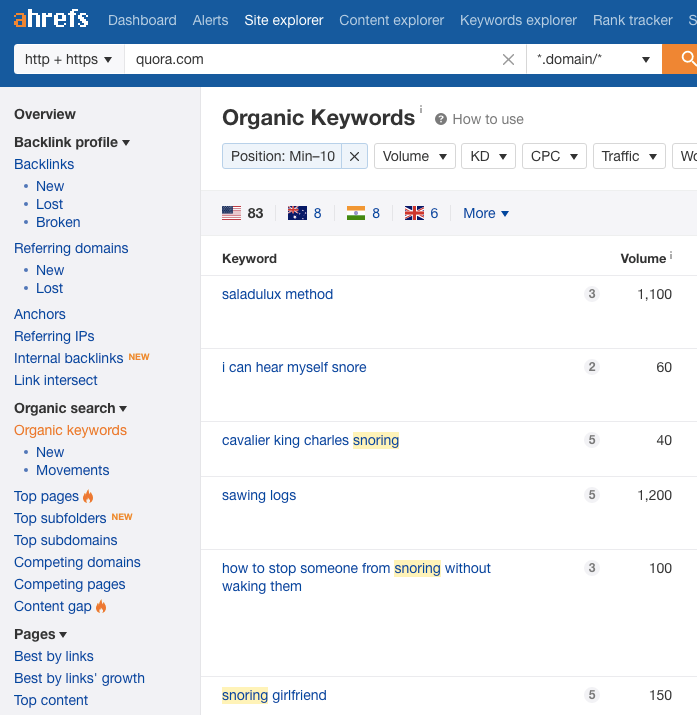
Answer those questions if they seem relevant to the content assets you've already published.
For example, I recently published a guide on how to use HARO. I then looked for any HARO-related queries on Quora and used takeaways or bullet points from my HARO guide as answers to questions.
7 Content Marketing Tools for Small Business
"How do you create business content?"
You can't create business content assets without using proprietary tools.
Not just for content ideation, but for content formatting, topic research, and even outreach promotion — tools can speed up output in a content marketing campaign.
Here are some web-based products you can utilize for your small business content marketing campaign:
Pixlr
It doesn't hurt much to edit photos yourself. If you can't afford to hire a full-time graphic designer, you can DIY photo editing.
Pixlr can help you with photo-editing tasks.
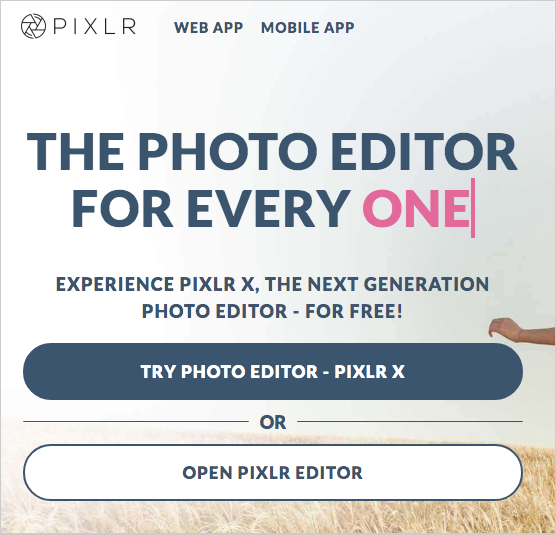
What I liked about this online photo editor is that it is easy to use — very quick even for professional edits. You can make adjustments to your image, draw anything on it, remove spots, and add more filters to enhance the photo.
Whatever quality of photo you desire, you can achieve it perfectly with Pixlr.
Remove BG
Oftentimes, if you want to remove the background of an image, you have to learn how to do Photoshop.
You don't always have to.
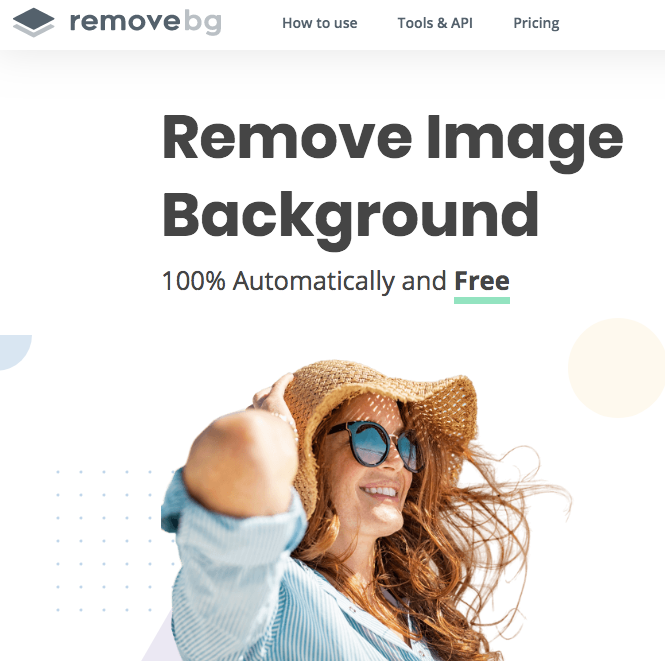
Within 5 seconds, RemoveBG can remove the backgrounds of images. It slashes your time editing the entire visual.
Snappa
Another amazing content marketing tool you can repeatedly use is Snappa.
For every text-based content, i.e. blog posts, there is a need to create featured images to appear in the blog section.
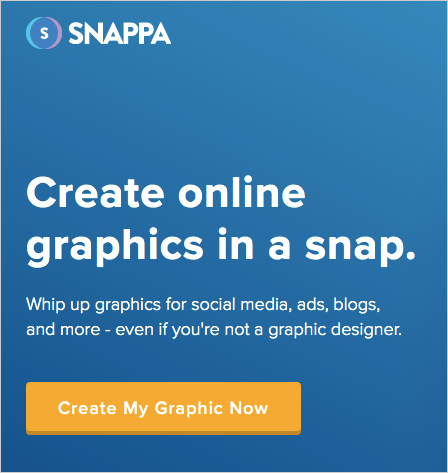
Snappa allows you to create an eye-catching image even if you're not a graphic designer.
Starting from the perfect image dimension and with their pre-made templates, you can create a high-resolution stock photo right inside Snappa. Add texts, and effects to the image wherever you want.
In 5 minutes, you can do the work you pay for designers. Have it very quickly for blog posts and for social media posts.
Recordit
If you are creating how-to on-screen guides in a text or video format, you spend most of your time creating screenshots.
RecordIt gives you the luxury of generating fast screenshots. You'll save much of your time doing so, therefore, producing more how-to content assets for your blog.
Esummarizer
You know one of the most consuming parts of a content creation process. Specific to blog writing, — It's writing the summary of the entire article.
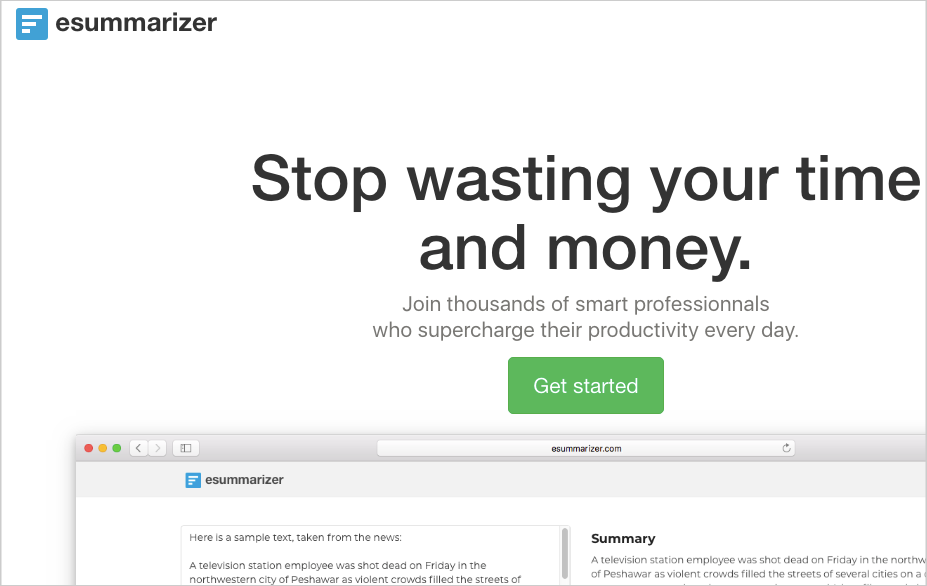
Another tool to supercharge your productivity is Esummarizer. It does only one thing — to summarize any text online in a few seconds. Now, you don't have to worry about the summary, the tool does it for you.
Keywords Everywhere
Keyword research tools are great. But one tool that's most fascinating, easily integrated as an extension to your browser is Keywords Everywhere.
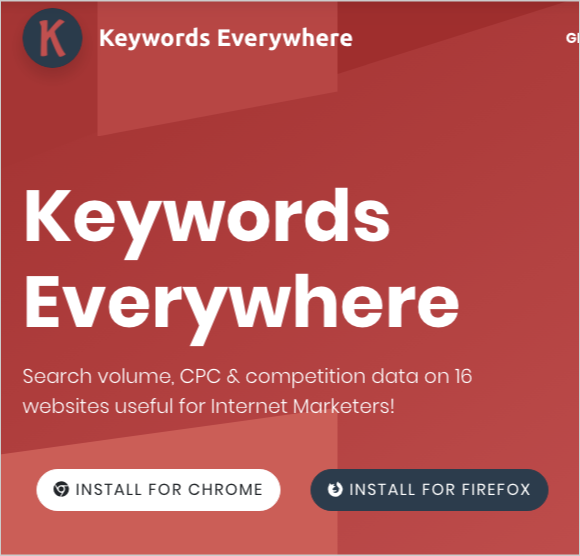
Whatever keyword you are searching for on Google, it will give you related keywords and phrases people also search for. These words can be included in your content piece either add it straight to the page and/or create new sections to target those topics.
Furthermore, Keywords Everywhere allows you to check important metrics of keywords — search volume, CPC & competition data.
Straight from search results, you can export and download any list of keywords in Excel, CSV, or PDF file formats.
Google Trends
Using trending topics in your content is a good way to get early traction from readers who are looking for industry updates.
Google Trends is a great tool to see any trending topics as well as check the demands of a keyphrase month over month.
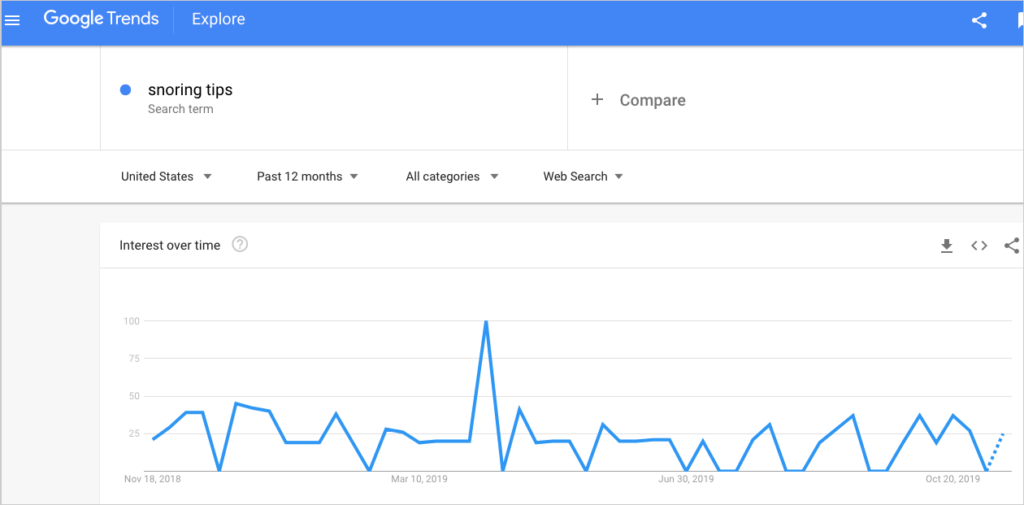
Here are some advantages of using Google Trends in your content marketing toolset:
- Find entities associated with the term — by adding brands, institutions, and any particular names to your content, search engines can easily identify and match them and know what your content is all about.
- Look at whether the interest in that topic is increasing or decreasing over time.
- Compare up to 5 different things against each other to resolve an argument about which topic to focus on.
3 Content Marketing Examples for Small Business
All content marketing ideas are good if they are executed properly. And everyone needs content marketing help for some inspiration.
Here are three small businesses that are doing extremely well with content marketing (from John Doherty's observations at Credo).
Ecommerce: Frank and Oak’s Handbook
You see usual blogs from eCommerce sites - nothing too special. But Frank and Oak have a top-notch blog architecture that gives you a soothing feeling in consuming its content.
This clothing retailer brand makes their handbook (their blog) like an online magazine filled with stories and advice on good living. It also has categories for culture-centric content pieces that perfectly fit its target market - millennials.
If you're an eCommerce small business brand, check out their blog and be inspired by how they use content to get brand advocates.
SaaS: Wix’s website-building tutorials
If you're a SaaS small business owner, Wix's content execution can be an inspiration for you. They published tutorial-style content in video format and publish it on their Youtube channel.
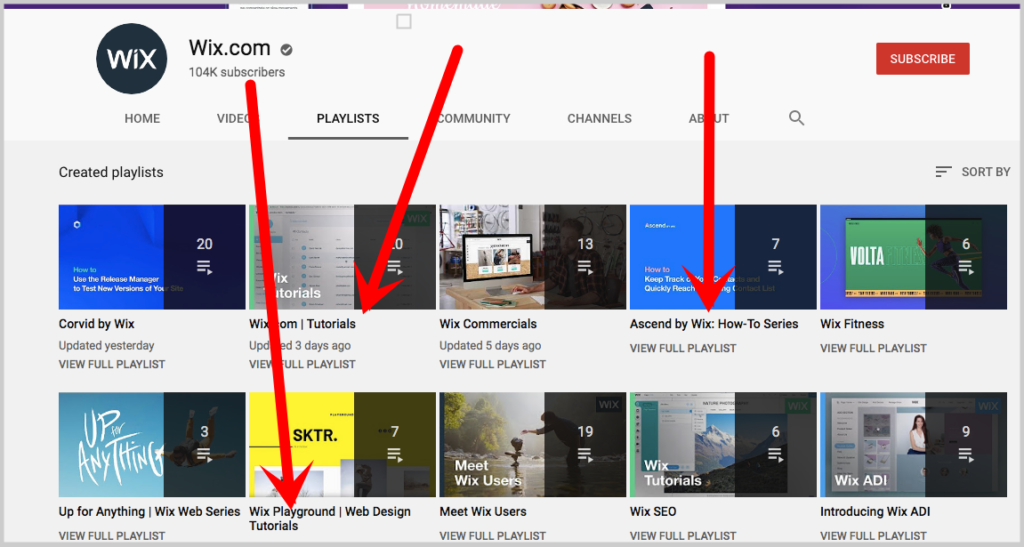
From basic topics to more advanced areas of website building, Wix does well in making its channel a one-stop information channel in the industry. They also have interview-type content where they feature prominent personalities and influencers.
B2B: MindSea’s original research
For B2B small businesses, ensuring that content is fact-based and/or credible is the top-most considered concept when creating content.
There are no other brands we can think of that does solid data-driven content creation other than Mindsea. They take a different approach to sharing data interestingly through visual content.
Further Reading:
- The guide to building your business with content
- Case studies on out-of-the-box content marketing
- 2020 B2B content marketing
Final words on small business content marketing
There is no small business, only small business owners. The same is true with your investment in content marketing.
It's not only how much money you invest in content marketing. Consider as well all non-financial resources you can put all into execution — time, attention, and networks to help you propel the results that you're looking for.
Share with us in the comments what else you need to get started with content marketing.
